Leading IT Transformation – Workshop 5 (Organizational Structure)

The Appleton Greene Corporate Training Program (CTP) for Leading IT Transformation is provided by Ms. Drabenstadt MBA BBA Certified Learning Provider (CLP). Program Specifications: Monthly cost USD$2,500.00; Monthly Workshops 6 hours; Monthly Support 4 hours; Program Duration 24 months; Program orders subject to ongoing availability.
If you would like to view the Client Information Hub (CIH) for this program, please Click Here
Learning Provider Profile

Ms. Drabenstadt is a Certified Learning Provider (CLP) at Appleton Greene and she has experience in Information Technology, Information Governance, Compliance and Audit. She has achieved an MBA, and BBA. She has industry experience within the following sectors: Technology; Insurance and Financial Services. She has had commercial experience within the following countries: United States of America, Canada, Australia, India, Trinidad, and Jamaica. Her program will initially be available in the following cities: Madison WI; Minneapolis MN; Chicago IL; Atlanta GA and Denver CO. Her personal achievements include: Developed Trusted IT-Business Relationship; Delivered Increased Business Value/Time; Decreased IT Costs; Re-tooled IT Staff; Increased IT Employee Morale. Her service skills incorporate: IT transformation leadership; process improvement; change management; program management and information governance.
MOST Analysis
Mission Statement
The digital transformation of an organization is not just about adopting new technology, setting up an innovation lab, or moving to a new platform. There are a lot of organizational factors that affect how the transformation unfolds. One such important factor is the organizational structure. Digital transformation cannot be executed successfully if the organizational structure and the decision-making processes are not conducive to this change. For IT transformation to be successful, there has to be minimum friction and an acceptance to change. If the organization’s structure or culture does not contribute to the adoption of these changes or if there is a lack of information flow in the organization, there will be a mismatch between the expected outcome and the reality of the transformation initiative. So, it is important to take the organizational structure into account, understand how it approaches change, and realize what modifications in the structure would be necessary to implement the digital transformation process successfully. One common trait of organizations with a digital mindset is that authority is distributed among all levels. Senior leadership still hold their position as policymakers and set the vision and goals for the organization, but the technology and business teams are empowered to make decisions for successful implementation and smooth transition. Organizations that are too rigid about their processes or do not trust their employees’ decision-making capabilities limit the agility and growth of the transformation process and the organization as a whole. This also makes employees indifferent and even resistant to change. For successful transformation to a new digital landscape, teams have to be given ownership of their action plans and operations so that they can be fully, and willingly, involved.
Objectives
01. Hierarchical Structure: departmental SWOT analysis; strategy research & development. Time Allocated: 1 Month
02. Functional Structure; departmental SWOT analysis; strategy research & development. Time Allocated: 1 Month
03. Matrix Structure; departmental SWOT analysis; strategy research & development. Time Allocated: 1 Month
04. Multidivisional Structure; departmental SWOT analysis; strategy research & development. Time Allocated: 1 Month
05. Flat Structure; departmental SWOT analysis; strategy research & development. Time Allocated: 1 Month
06. Flatarchy Structure; departmental SWOT analysis; strategy research & development. Time Allocated: 1 Month
07. Product Structure: departmental SWOT analysis; strategy research & development. 1 Month
08. Project Management Structure: departmental SWOT analysis; strategy research & development. Time Allocated: 1 Month
09. Network Structure: departmental SWOT analysis; strategy research & development. Time Allocated: 1 Month
10. Team-based Structure: departmental SWOT analysis; strategy research & development. Time Allocated: 1 Month
11. Process-based Structure: departmental SWOT analysis; strategy research & development. Time Allocated: 1 Month
12. Agile Methodology: departmental SWOT analysis; strategy research & development. Time Allocated: 1 Month
Strategies
01. Hierarchical Structure: Each individual department head to undertake departmental SWOT analysis; strategy research & development.
02. Functional Structure: Each individual department head to undertake departmental SWOT analysis; strategy research & development.
03. Matrix Structure: Each individual department head to undertake departmental SWOT analysis; strategy research & development.
04. Multidivisional Structure: Each individual department head to undertake departmental SWOT analysis; strategy research & development.
05. Flat Structure: Each individual department head to undertake departmental SWOT analysis; strategy research & development.
06. Flatarchy Structure: Each individual department head to undertake departmental SWOT analysis; strategy research & development.
07. Product Structure: Each individual department head to undertake departmental SWOT analysis; strategy research & development.
08. Project Management Structure: Each individual department head to undertake departmental SWOT analysis; strategy research & development.
09. Network Structure: Each individual department head to undertake departmental SWOT analysis; strategy research & development.
10. Team-based Structure: Each individual department head to undertake departmental SWOT analysis; strategy research & development.
11. Process-based Structure: Each individual department head to undertake departmental SWOT analysis; strategy research & development.
12. Agile Methodology: Each individual department head to undertake departmental SWOT analysis; strategy research & development.
Tasks
01. Create a task on your calendar, to be completed within the next month, to analyze Hierarchical Structure.
02. Create a task on your calendar, to be completed within the next month, to analyze Functional Structure.
03. Create a task on your calendar, to be completed within the next month, to analyze Matrix Structure.
04. Create a task on your calendar, to be completed within the next month, to analyze Multidivisional Structure.
05. Create a task on your calendar, to be completed within the next month, to analyze Flat Structure.
06. Create a task on your calendar, to be completed within the next month, to analyze Flatarchy Structure.
07. Create a task on your calendar, to be completed within the next month, to analyze Product Structure.
08. Create a task on your calendar, to be completed within the next month, to analyze Project Management Structure.
09. Create a task on your calendar, to be completed within the next month, to analyze Network Structure.
10. Create a task on your calendar, to be completed within the next month, to analyze Team-based Structure.
11. Create a task on your calendar, to be completed within the next month, to analyze Process-based Structure.
12. Create a task on your calendar, to be completed within the next month, to analyze Agile Methodology.
Introduction
Throughout the life of an organization, at least one sort of organizational change will occur. The unavoidable and ever-changing reality of the competitive corporate environment is reflected in organizational changes.
Technology will improve, outmoded systems and processes will be replaced, and the process of organizational change will continue to resurface, forcing leaders to re-evaluate processes and re-establish the new standard.
A good organizational change process protects a company from losing earnings to competitors and missing out on possibilities to boost ROI, save expenses, and boost productivity. The approach is designed to give you a long-term competitive advantage in the market.
“Change is the only constant in life,” – Heraclitus, Greek philosopher
Companies must implement organizational changes that respond to market trends, appeal to consumers, and progress in lockstep with the fast-paced digital world now more than ever.

What is the process of organizational change?
The organizational change process is a comprehensive framework for implementing transformative changes across an organization. Every company will experience organizational change at some point, whether it be in the form of planned change, cultural change, process change, transformational change, or changes in the organizational structure. It’s critical to have a comprehensive process in place for any type of organizational change to minimize employee opposition, confusion, and fatal oversights.
Rather of focusing on the specific change at hand, the organizational change process is in place to establish the framework and guidelines for any large-scale change in a corporation. Consider the organizational change process as a hollow structure into which specific projects can be placed and swapped out as needed. The emphasis in developing an organizational change process is on the building of a complete, overarching infrastructure, rather than on the specifics of the change.
When a new firm decides to increase its personnel, find a larger office space, or expand to another state, organizational change may occur. For example, suppose a company’s work culture no longer meets its business objectives, and top executives determine the company’s purpose, vision, and values need to be refreshed. In any case, an organizational change process will lead the change management team through a series of tried-and-true procedures to ensure a successful transition. The current status of the business is called into question when there is potential for the company to function more efficiently and cost-effectively—and there is always room for improvement.
Organizational transformation is an ongoing operation that requires a detailed, 10-step procedure since the current status of the firm should always be reviewed.

10 Critical Steps in the Process of Organizational Change:
1. Recognize the problem. Build urgency.
To get everyone on the same page, with the same knowledge and urgency, it’s critical to create a sense of urgency around a change initiative. Urgency can drive change efforts when team members and executives believe that an aspect of the firm has to be improved. Encourage staff to communicate openly and honestly. Communicate what’s going on in the market, what the firm could do to assure long-term growth, where the company is falling short, and what this means for the company’s future. Speak with staff who deal with clients or consumers to support the urgency. Customer support representatives will have personal knowledge of the customer’s problems and complaints.
Even if the numbers are alarming, back up your arguments with verifiable data and statistics. Leaders frequently withhold information that could reflect adversely on their leadership abilities or have a detrimental impact on the market. Real data is required for instilling a feeling of urgency and illuminating the true need for change. Numbers don’t lie, and statistics don’t allow for subjective judgment. Change can be triggered solely by numbers.
This stage is known as the “unfreezing” stage in Kurt Lewin’s change model. To enable the change model, the existing model must unfreeze, thaw out, and melt down. Change leaders are unfreezing the current status quo at this stage, allowing a new status quo to emerge.
2. Determine the type of organizational change and make sure it’s in line with the company’s goals.
It’s vital to figure out what kind of organizational transformation is taking place at this point. Is this a complete shift in strategy? Is there a cultural shift? And there’s another issue that should be on leaders’ thoughts throughout the process: Why is this change required? Step two is similar to step one in that it defines the benefits of the change. Determine how this modification relates to particular business goals as well as the broader goal.
Determine the organization’s threats and foresee potential roadblocks in the future. What impact will these new developments have on threats, roadblocks, and limitations? What role does this transformation project play in advancing and supporting the business strategy? Make a forecast of how and where these changes will fit into the present model, as well as how they will help the organization achieve its objectives. To strengthen buy-in from other leaders, present data/statistics from step one and identify how these adjustments correspond with the company’s success trajectory. To be successful, according to John Kotter, a well-known thought leader in business transformation, 75 percent of a company’s leaders and managers must buy-in to the process of organizational change.
Other change leaders are more likely to buy-in if the proposal for an organizational change is backed up by data, market patterns, and historical facts.
3. Explain how each role will be affected by the changes.
It’s critical for employees and fellow team members to understand how these changes will directly effect their jobs and responsibilities once change leaders have made a convincing case for change. The key to success is effective internal communication.
Clear and open communication will not only keep team members informed about upcoming events, but it will also demonstrate to them that their responsibilities are critical to the company’s success, increasing their feeling of purpose.
Employees are more likely to be engaged and excited when they can see how their position fits into the equation and contributes to the larger picture. Employee participation is critical throughout the organizational change process, as employees will be the ones to implement the new changes and establish the new standard.
Employees must grasp the initial value of these changes, as well as the consequences of these changes and what they can expect to experience in the interim.
4. To assist the change endeavor, assemble a group of interdepartmental change leaders.
If one leader recognizes the importance of change, it is likely that other leaders will have the same perception and motivation to implement a change project. Gathering a group of interdepartmental change leaders shouldn’t be too difficult once organizations have ensured buy-in using the tactics in phases one and two.
Inviting leaders from diverse departments to participate in the change management process and assist in the implementation of change initiatives is a good idea. Hearing the views and opinions of other department heads will broaden your perspective to the entire firm, allowing you to see the true urgency behind the need for change as well as the transformation’s potential consequences.
As people with diverse backgrounds, talents, and experiences are brought together to participate in decision-making and problem-solving, open communication between departments will enable for the emergence of new ideas.
When their views, opinions, and perspectives are considered, fellow leaders and team members will feel appreciated and respected.

5. Develop a vision and strategy.
Change agents have gathered feedback and developed a deep awareness of the issues that each department encounters. This feedback should have an immediate impact on the vision and strategy. In fact, the vision and plan should be shaped by comments from other team members.
When making any organizational changes, especially those that touch the entire company, meticulous planning is critical. To avoid company interruption and ensure a successful process, change leaders must be comprehensive, inclusive, and meticulous in their planning. Refer back to the sense of urgency established in step one. What was the motivation behind this initiative? Is there a shift in the market? Have there been any changes in consumer behavior? New trends in the horizon? Incorporate these motivations into your vision and plan.
In order to build an inclusive game plan that delivers solutions and satisfies the needs of the entire firm, leaders and employees from all departments should collaborate in this step.
6. Communicate the vision, and initiate the change.
You must effectively explain your vision to your change leader peers and team members if you want them to share it. How does the final product appear? What role does the vision play in the overall mission of the company?
Establish open lines of communication with team members and fellow change agents. This is your moment to pique staff interest and encourage participation. Work with staff to establish a positive, sincere tone for the upcoming changes. Throughout the transition process, a good vision will recognise employees and emphasize the importance of their contributions. Employees will have a better sense of connection with the changes to come and a higher sense of purpose in the process if change leaders articulate a vision that speaks to the value of employees and how critical their contributions are to a successful end result.
With the help of the rest of the team, implementing the modification should go rather well. Changes will be implemented in stages, with a roadmap being defined, milestones being set, and roles being assigned.
7. Empower action from team members.
Encourage innovative thinking and problem-solving. Maintain a high degree of enthusiasm and anticipation for the upcoming changes. Begin by expressing the enthusiasm you wish to see in your staff. It is the responsibility of top management leaders to motivate other change agents and team members to take action. This is not the time for leaders to relax and delegate. This is where leaders demonstrate the type of behavior they want their team members to exhibit.
Recognize any fear or reluctance from employees by communicating openly. Employees are probably used to the current methods and procedures, so it’s understandable if they show some resistance. People desire security, and we all have a fear of the unknown, so resistance to change is understandable. Leaders must portray an understanding disposition and enable people to feel heard and supported in order to implement a successful organizational change process.
To avoid company disruptions, respond to employee opposition with helpful, respectful, and effective communications. Encourage employees who are resistant to change to participate and engage in the process, and empower them to take action. To not only improve the process and operate as efficiently as possible, but also to demonstrate inclusion and consideration for employees, ask these employees for feedback as they engage with it.
8. Establish short-term milestones and goals to be met.
Create short-term goals and actions for the team members who are leading the transformation. Set short daily goals and assign daily responsibilities to verify that the team is working together and that change projects are moving along as anticipated. Short-term milestones are critical not just for achieving fundamental goals and moving the organizational process forward, but also for motivating employees. Use short-term goals to reward and recognize employees for their contributions and achievements.
To promote effective and strategic project management, a successful change management team will create a roadmap of milestones and goals. Employee expectations have previously been stated by top management, but it’s vital to reassert them and explain responsibility through goals and milestones. Employees should never be left unsure on what to do next, how to proceed, or how to complete tasks. To prevent misunderstanding and employee resistance, a successful project management team would organize tasks clearly and coherently.
9. Implement an effective change management process.
Keep track of team members’ productivity and growth. Is everything going according to plan? Are team members achieving their aims and accomplishing their goals? Is it time to re-evaluate future timetables and milestones?
Create an effective communication strategy to ensure that employees are kept informed throughout the organizational change process. Problems cannot be addressed and solutions cannot be found if issues are not shared and employees do not share their feedback throughout the process.
Many successful firms use communication journeys that are tailored to their specific change initiatives to enable employees from all departments and levels of leadership communicate more effectively.
Change agents will be able to define goals, roles, duties, success indicators, reporting, and accountability mechanisms through an effective organizational change management process. What criteria will be used to determine the company’s success? Create reports and assess data on a regular basis to get a clear picture of how these changes are affecting the company’s success and how personnel are coping with the new processes and technologies. Employee feedback should be solicited on a regular basis, and employee happiness and productivity should be evaluated.
Work performance, staff contentment, and overall output levels should all be evaluated by top management on a regular basis. Leaders will commit to constant refining of all strategies and procedures if they use an effective change management methodology.
10. Provide feedback to everyone involved.
It’s vital that team members understand how they’re doing and how they’re reacting to new situations. If certain employees are having trouble adjusting to the new status quo, they must be aware of their performance in order to improve it.
Regular employee assessments should be included in the organizational change management process (solidified in step 9) so that senior management team members can provide constructive input. While many managers are afraid to provide negative/constructive feedback to their staff, research has shown that employees are ready to learn and improve their skills.
According to a Harvard Business Review research, 57 percent of employees prefer corrective input (constructive or negative criticism), whereas just 43 percent prefer good feedback (praise and recognition).
Because employees desire to contribute their best effective and efficient work, the majority of your employees want to be corrected and given constructive feedback.
Positive feedback is also one of the most effective ways to motivate employees and maintain a high level of morale in the workplace. Create positive reinforcements that link the upcoming changes to positivity, motivation, and reward. Employees are a company’s most valuable asset, and good feedback is a proven way to boost productivity. Honest feedback demonstrates to team members that their efforts are valued. Employees who receive feedback are more likely to achieve their full potential.
The Bottom Line
The goal of organizational reform is to make continuous progress toward a better future state corporation. Effective change management tactics will ensure that organizational changes always promote the company’s overall goals, while also minimizing employee resistance and business disruption.
Attracting, hiring, and maintaining the correct talent pool is critical for change leaders, as it is for any company project. Talent management software is a useful tool for keeping track of a company’s human resource performance. Having the appropriate people on board with a change endeavor can make all the difference during the transition phase.
The need for organizational change will persist as long as technology exists, and the process of organizational change will be vital as long as technology exists.

Leading IT Transformation and organizational structure
Companies frequently mandate Leading IT transformation (or any other popular change theory) without relating it to their employees’ day-to-day experiences. This is especially true if organizational structures and decision-making processes aren’t changed to accommodate the new mandate. Employees may become indifferent (if not outright opposed) to change as a result of such misalignments between reality and rhetoric. To avoid this, it’s critical to make all employees’ desire for change tangible. The teams that build and manage the technology must be fully engaged when it comes to IT transformation.
Autonomy for technology teams is one of the hallmarks of firms that exemplify the digital mindset. Senior management still set the overarching vision and define the competitive landscape, but technology teams are given more freedom to figure out how to best serve customers and help the company achieve its objectives. This method promotes model acceptance and liberates teams from complex “master plans” or restrictive processes, which can stifle mobility and progress.
In the past, businesses have grappled with this. An engineering team would suggest a new idea, but it would take months for that idea to go through our previous “integrated business planning” (that’s precisely what we called it) process, and much longer for it to be implemented. It’s possible that an entire year will pass before any of that effort has a noticeable influence on customers. Meanwhile, the engineering team’s interest and motivation would wane. Worse, they’d occasionally be beaten to market by more agile competitors, or customer wants would just change faster than we could respond.
Companies generate goods and services that resemble their organizational charts and communication structures, according to an aphorism known as Conway’s Law. So, if you have a traditional and hierarchical organization where product development teams are separated from their users or customers by thick layers of business analysts, project managers, manager managers, and so on, using their products and services will often feel equally opaque, complex, and muddy. Many businesses were confronted with this fundamental issue, and they had to find a way to overcome it.
Since then, some firms have adopted a more agile technology organization model. Our diverse businesses’ teams are organized around technological products that they may use to service their own customers and workers. These cross-functional teams, which comprise software developers, product managers, user experience designers, business analysts, and others, are in charge of their product roadmaps and conduct business as if they were interacting with external clients (even if their actual customers are just sitting one floor above them).
Teams must also undertake competitive research to prove that their solution is superior to what is currently available on the market. Furthermore, it is their obligation to persuade their clients of this. We all have a strong inclination toward buy when it comes to the traditional “build vs buy” conundrum. We’ll only create anything if we’re confident that it will give us a significant competitive edge over other options.
This strategy moves the responsibility for identifying the company’s next steps down the organizational ladder. It’s a scary change for leaders who are used to having tight control over their workers, but it’s a necessary one for any firm that wants to reap the benefits of digitization. Senior leaders must strike a balance between allowing their teams to be autonomous while still keeping them engaged and aligned on the overarching strategy.
At the end of the day, established businesses that wish to become more digital must do more than discuss the end objective in terms of product or market. They must provide the kind of organizational structure that will encourage technology teams to own the vision and implement it in their daily work.

The different organizational structures
A company’s organizational structure integrates and connects its various pieces in order for it to work at its best. The structure chosen has an impact on an organization’s ability to achieve its strategy and objectives. To aid in this strategic alignment, leadership should be aware of the characteristics, benefits, and limitations of various organizational structures.
Background
The way by which work flows through an organization is known as organizational structure. It enables groups to collaborate on assignments within their respective functions. Employees are typically organized by function (such as finance or operations), area, or product line in traditional organizational systems. Structures that are less traditional are loosely knit and flexible, allowing them to adjust swiftly to changing business conditions.
Since the 1800s, organizational structures have changed. Individuals were organized throughout the Industrial Revolution to add parts to the manufacturing of the product as it moved down the assembly line. Frederick Taylor’s scientific management approach streamlined how activities were completed, allowing workers to focus on only one activity at a time. General Motors pioneered a novel organizational architecture in the twentieth century, in which each main division produced its own cars.
Organizational structures are rapidly evolving today, ranging from virtual organizations to more flexible forms. Future organizations may exemplify a fluid, free-forming organization, member ownership, and an entrepreneurial mentality among all members as corporations continue to change and expand their global presence.
Business Case
The flexibility to adapt and realign as needed is a hallmark of a well-aligned organization. An organization’s structure must be adjusted to reflect new economic realities while maintaining core strengths and competitive distinction to ensure long-term existence. Closing structural gaps that impede organizational effectiveness is part of organizational realignment.
Problems created by a misaligned organizational structure
Rapid rearrangement of business units, divisions, or functions can result in ineffective, misaligned organizational structures that do not support the company’s operations. Poorly planned reorganizations can result in a variety of issues, including the following:
• When firms cut middle management levels without eliminating the job, individuals are forced to take on extra duties, resulting in structural gaps in roles, work processes, accountabilities, and crucial information flows.
• Lower-level employees who step in when middle management is terminated may be ill-equipped to undertake the needed activities, and higher-level executives may be forced to take on more tactical responsibilities, reducing the value of their leadership skills.
• Inadequate staffing and disorganization can have an impact on a company’s cost structure, cash flow, and ability to supply goods or services. Agile businesses can quickly deploy personnel to meet changing business needs. However, with limited resources, most employees can only focus on their immediate responsibilities, leaving little time, energy, or motivation to work outside of their existing job area. In the end, a company’s ability to compete is harmed by reduced capacity and slow response times.
• Low employee engagement can lead to lower employee retention, lower customer loyalty, and lower organizational performance and shareholder value.

The importance of aligning the structure with the business strategy
The key to profitable performance is the extent to which four business elements are aligned:
Leadership. Individuals in charge of planning, implementing, and tracking the strategy’s progress.
Organization. The structure, processes, and operations that are used to implement the strategy.
Jobs. The necessary roles and responsibilities.
People. The knowledge, skills, and abilities required to carry out the strategy.
Understanding the interdependencies of these business pieces, as well as the necessity for them to respond to change rapidly and strategically, is critical for high-performance success. Outstanding performance is more likely when these four aspects are in sync.
Time and critical thinking are required to achieve alignment and maintain organizational capacity. Organizations must determine the outcomes that the new structure or process will create. Typically, this necessitates recalibrating the following:
• Which tasks are mission-critical and can be reduced or eliminated?
• Existing role requirements, as well as new or changed roles that are required
• Accountabilities and key metrics
• Critical information is exchanged
• Organizational decision-making authority

Key Elements of Organizational Structures
An organizational structure is made up of five elements: job design, departmentation, delegation, span of control, and chain of command. An organizational chart is made up of several pieces, which together form the organization’s structure. The way an organization organizes its jobs to coordinate work is referred to as “departmentation.” The number of people who report to a manager is referred to as the “Span of Control.” A line of power is referred to as a “chain of command.”
Organizational structures are also influenced by the company’s managerial centralization or decentralization approach. A pyramid structure is usually the result of “centralization,” or the degree to which decision-making authority is restricted to higher levels of management. When conflicting aims and methods among operating units necessitate a common policy, centralization is usually suggested. The degree to which lower levels of the hierarchy have decision-making authority is known as “decentralization,” and it usually results in a leaner, flatter organization. When conflicting strategies, ambiguity, or complexity necessitate local flexibility and decision-making, decentralization is advocated.
Centralized vs. Decentralized Organizational Structures
A company will either have a centralized or decentralized organizational structure. Organizations have traditionally been established with centralized leadership and a well defined chain of command. The military is known for its highly centralized structure, which includes a long and detailed hierarchy of superiors and subordinates. In a centralized organizational system, each function has extremely clear responsibilities, with junior roles relying on their superiors for guidance.
As is the case with many technological businesses, there has been an increase in decentralized organizations. This enables businesses to be quick, nimble, and adaptable, with nearly every employee having a high level of personal agency. Johnson & Johnson, for example, is well-known for its decentralized structure. As a huge corporation with over 200 business units and brands operating in a variety of industries, each functions independently. Even in decentralized businesses, hierarchies are usually present (such as the chief operating officer operating at a higher level than an entry-level associate). Teams, on the other hand, are free to make their own decisions and come to the best conclusion without needing “approval” from the top.
Your IT Organizational Structure: Should You Centralize or Decentralize?
The topic of whether your organization’s IT system should be centralized or decentralized does not have a simple answer, s ince businesses rarely commit to one of these models. In truth, centralized and decentralized IT structures are on opposite sides of a spectrum, with most businesses, falling somewhere in between.
Understanding the advantages of both strategies can aid in determining whether your company should centralize or decentralize its IT infrastructure. You should be preparing for future growth and selecting software solutions that support your objectives throughout the process.
Centralized vs. decentralized IT organizational structures
All users are connected to a central server in a centralized network, which keeps all network data and user information. A decentralized network, on the other hand, contains numerous peer-to-peer user groups, each of which has its own server that maintains data and information specific to that group.
All communications networks used to be centralized. In 1964, researcher Paul Baran proposed the concept of a decentralized network to aid in the improvement of telecommunications infrastructure.
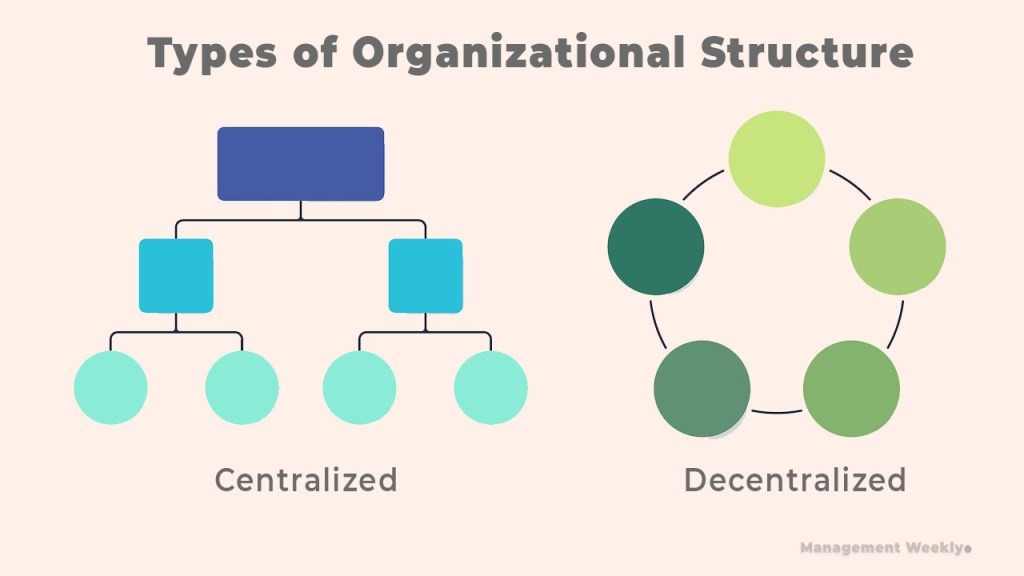
Researchers were looking for an alternative to the typical, centralized network structure during the Cold War. Even if the majority of network lines and stations were unaffected, they feared that a single hit on the central server would render the entire system unusable.
Baran recommended “distributing” the network’s key switching and control equipment. In this way, even if one component of the network is broken, the remaining sections will continue to function. He advocated for a decentralized system by improving network redundancy, which entails adding more devices, equipment, and communication channels to ensure increased infrastructure availability in the event of a network breakdown.
Benefits of centralized IT structures
Companies that require better network management and visibility should use a centralized server that monitors the entire flow of network data.
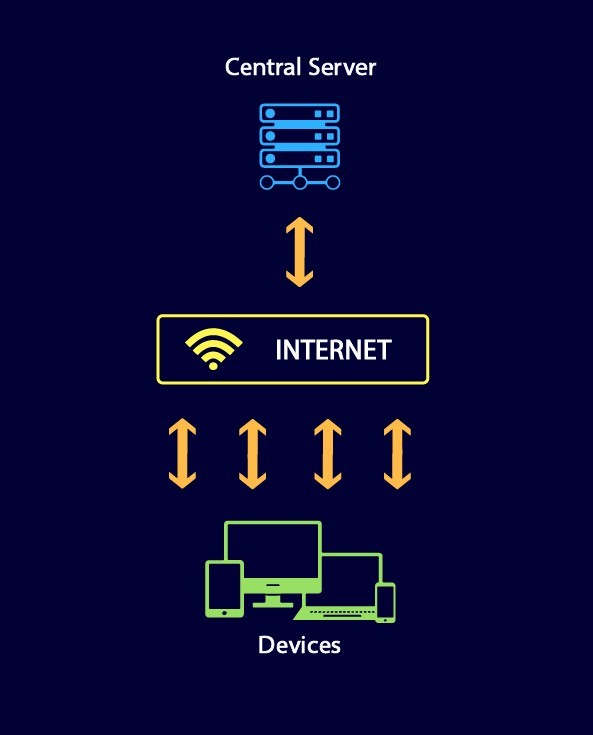
Centralized IT Structure by 101 Blockchains
There are many benefits of adopting this type of structure. A centralized IT network can:
1. Reduce your hardware costs. By centralizing all servers and networking equipment, you can save money on hardware. Extra or duplicate equipment is required when deployed across multiple locations. Increasing redundancy, in a nutshell, raises expenses.
2. Boost IT employees’ productivity. Your IT team will have better oversight and routine duties will be easier with a centralized framework. Software installations, upgrades, and security patches, for example, can all be done from a single spot. Completing these activities in a decentralized IT structure would have employees managing each location independently, which might increase expenses and reduce productivity.
3. Make your purchasing power stronger. Pricing software licenses and support contracts for an entire organization is easier to negotiate than for individual divisions. Better contract terms and even complimentary integration or support services may come as a result of this.
4. Assist in meeting industrial regulations. HIPAA for healthcare providers and the Sarbanes-Oxley Act for financial services both demand varied degrees of IT and database centralization, usually for data security concerns. Issuers that store and process user information, such as credit card companies, find that centralized IT systems make it easier to meet regulatory data security standards.
5. Improve the information flow. Data silos can be avoided with centralized IT structures. Data and information may be quickly transferred between departments, resulting in improved knowledge sharing and cooperation. Using a centralized cloud-based CRM system, for example, will enable all staff to access customer information from any location.
Benefits of decentralized IT structures
When different departments in a firm have diverse IT demands and strategies, decentralization is a sensible solution. It enables each business unit to run its own server and select hardware and programs based on their specific requirements.
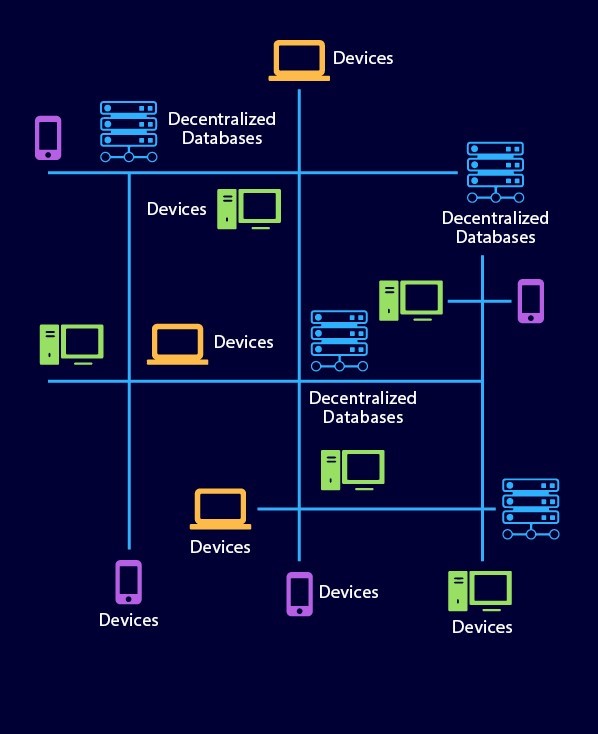
Decentralized IT Structure by 101 Blockchains
Decentralized IT structures provide several benefits, including:
1. The ability to tailor IT selection and configuration. Individual departments with IT decision-making authority can select and configure IT resources to meet their unique requirements. The decision-making procedure is simple and does not necessitate a series of approvals.
2. More fail-safes and redundancy in the organization. IT networks become more resilient as a result of decentralization. Because each department has its own server, one department’s server can act as a backup server for another in the event of a network breakdown.
3. Response time to emerging IT trends is quicker. It’s easier for departments in decentralized companies to take advantage of new technologies because they can make their own decisions. Let’s imagine your customer service department wishes to use online live chat to better their services. It can do it autonomously in a decentralized model. There would be many obstacles to the acquisition in a centralized arrangement, starting with securing buy-in from the IT department. Responding slowly to evolving technology developments can put you at a competitive disadvantage.

How to determine the right degree of centralization or decentralization for your company?
There are various reasons for moving toward or away from a centralized or decentralized IT system, as stated above. Of course, a variety of factors will impact your decision, but there are some broad guidelines that might assist you in determining what is best for your company.
Companies that rely on technical agility to stay competitive usually benefit from decentralized IT structures.
Decentralized IT networks are most likely to help newer, smaller companies (e.g., startups) and organizations that need to respond fast to new IT advancements (e.g., software and hardware companies or app development firms).
It can be challenging to grow decentralized IT infrastructure.
Organizations that build decentralized IT systems organically as a result of a lack of monitoring may have trouble growing. Without adequate preparation, bringing dissimilar systems together is difficult, if not impossible.
Large firms, in particular, benefit from centralized IT structures since they save money.
The ability for entire organizations to behave in lockstep is enabled by centralization. All departments will be able to shift to new, less expensive technologies and negotiate contracts with greater clout.
Network connectivity is critical for centralized network structures.
The entire network loses connectivity if the central server goes down. Because there are no backup servers, the odds of users losing their data are considerable.
Executive Summary
Chapter 1: Hierarchical Structure
A simple reporting system comes standard with a hierarchical organization structure, making it easy for subordinates to grasp their roles and obligations. This structure can help business owners assure smooth operations and more transparent reporting. It works effectively in most settings and has numerous advantages for huge corporations. The hierarchical structure, as well as its benefits and drawbacks, will be discussed in this Course Manual.
What is a hierarchical Structure?
A hierarchical structure is one in which the highest executives report to normal employees through a chain of command. It resembles a pyramid, with the individual with the most authority occupying the topmost place, while the lowest-ranking employees occupy the bottom positions. The company’s vertical chain of command has separate reporting structures, and everyone understands where they belong. In huge firms and organizations with multiple departments performing many functions, hierarchical systems frequently work well.
How a hierarchical structure works
Employees in a hierarchical structure have distinct roles that are interconnected and contribute to the company’s goals. Executives divide personnel into groups, each with a manager or managers in charge of the group of employees under their supervision. A pyramidal line of command exists between the managers and the senior executives above them. The conventional structure can be flat or tall, depending on the size of an organization or the phases of management in the middle.
The chief executive officer (CEO), chief financial officer (CFO), and chief operating officer (COO) are members of an organization’s C-Suite (COO). Senior executives are in charge of making major choices for the company. There are also directors that oversee various firm divisions and make strategic decisions to ensure that their departments fulfill their goals. Marketing, IT, finance, accounting, and human resources are some of the most popular departments. Managers are under the direction of directors, who give them orders. Managers pass out instructions to lower-level employees and supervise them as they accomplish their jobs.

Chapter 2: Functional Structure
The functional structure is a sort of organizational structure that aids in the management of people and the achievement of corporate objectives. The benefits of the functional organizational structure and how it is used in firms today are discussed in this Course Manual.
What is the Functional Organizational Structure?
The functional organizational structure arranges a company’s activities around specialist areas. There may be a marketing department that only does marketing, a sales department that only does sales, and an engineering department that only designs products and production facilities, for example. In larger firms, the functional organizational structure is the most common method of organization since they deal with such massive sales and production volumes that no other type of organization would be nearly as efficient. It’s especially useful in the following situations:
• Large volume of standardized product or service sales
• Low level of change within the business
• Large, fixed asset base
• Minimal amount of fully new product line releases
• Minimal changes due to fashion or other changes in taste or technology
• Competition is mostly centered on cost
In other words, in a stable environment, this system performs well.
The functional organization is built on a traditional hierarchy system, with each employee’s role and job responsibilities clearly specified. The company is also organized into many sections, each of which is responsible for completing a certain project. The function of departments is determined by the project’s requirements. A functional organization structure is one of the most common organizational models for running a firm efficiently and generating high profits. Small businesses as well as those that provide a single type of service or product on a regular basis, such as medical clinics, car repair shops, hotels, and restaurants, can benefit from a functional organization structure.
A functional organizational structure can be implemented in departments such as advertising, finance, marketing, sales, and human resources of a corporation. It allows managers to maintain control over their employees without inciting friction between them. Employees are well-trained and skilled, and they are divided into groups based on their areas of expertise. The personnel are assigned to departments with individuals that have the same skill set as them. They must report to a functional manager, who in turn must report to a higher authority, such as a CEO or director.
Because the manager is an expert in the same field as the employees, he can better utilize, manage, and coordinate the skills of the workers under his supervision to achieve maximum output.
The ideal structure of the functional organization
If an organization is to survive and thrive in these competitive times, it must have an efficient organizational structure. If you do not apply a correct structure that is ideal for your type of business, you will experience confusion, turmoil, and inefficiency.
Keep in mind that an organization’s working culture and the function and responsibilities of an employee in that environment are determined by the organization. Remember that in these types of arrangements, you have a fixed role to fulfill and must report to the functional manager. The corporation is divided into smaller divisions or groups under a functional organization structure, and all personnel are categorized according to the role they do.
The president is at the top of the organizational chart, followed by vice president, finance department, sales, purchase, administration, and so on. Every department has a leader who is directly responsible for the employees who report to them. For example, the advertising department focuses primarily on raising brand awareness and product visibility, whereas the sales department focuses on increasing corporate sales. Communication is routed through department heads to top management brass, rather than through lower levels or employees.
Example of the Functional Organization Structure
ABC International has reached a sales milestone of $10 million, and its president believes that now is a suitable moment to restructure the company to increase efficiencies through job specialization. As a result, he divides employees into the following categories:
• Accounting department
• Corporate department
• Engineering department
• Facilities department
• Human resources department
• Investor relations department
• Legal department
• Production department
• Public relations department
• Purchasing department
• Sales and marketing department

Chapter 3: Matrix Structure
What is a matrix organization?
A matrix organization is a work system in which members of a team report to several different leaders. Team members (whether remote or in-house) report to a project manager as well as their department head in a matrix organization. This management structure can assist your organization in developing new products and services while avoiding the need to realign personnel.
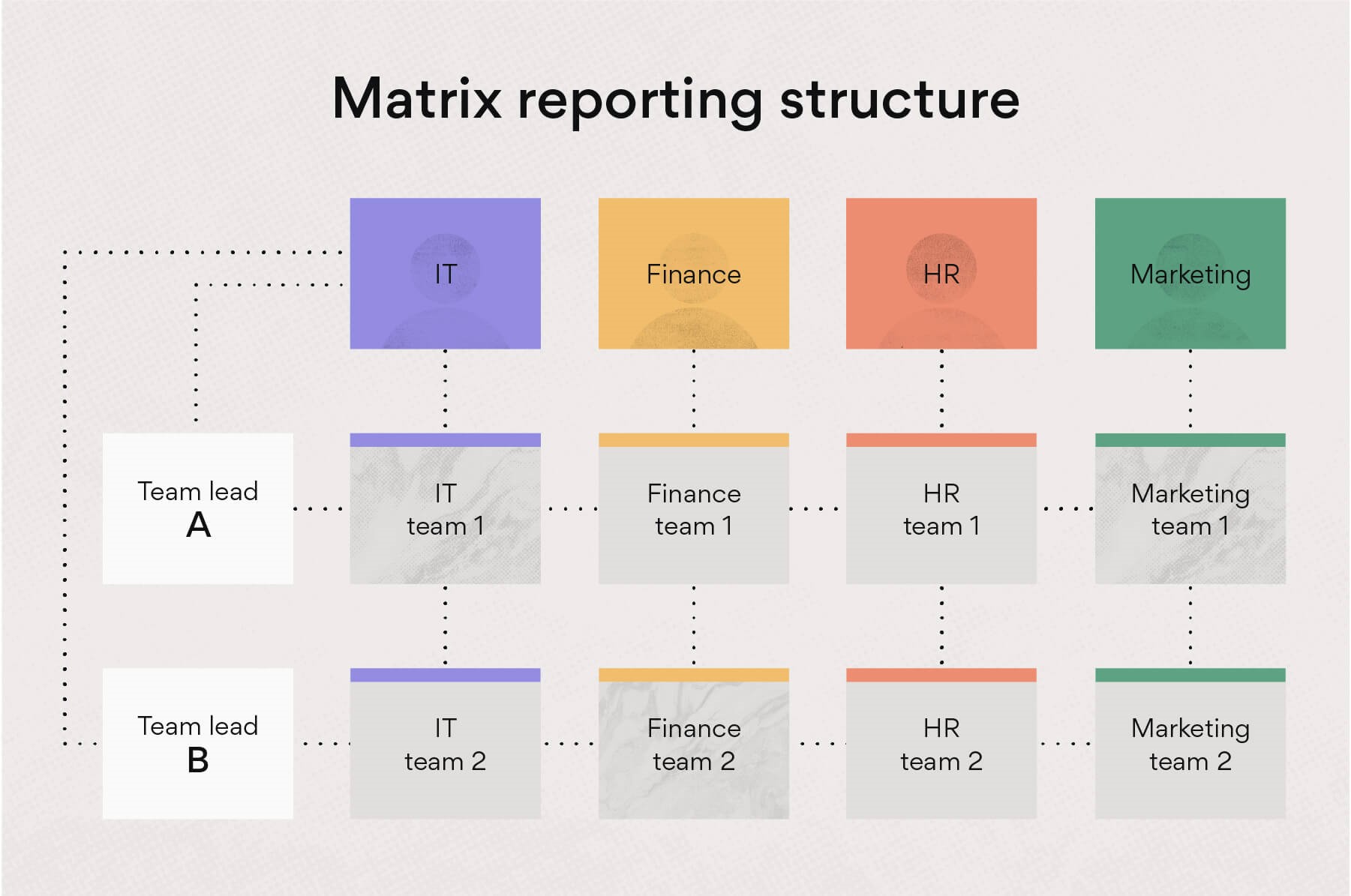
Asana
How do matrix organizations work?
There are two or more management reporting structures in matrix organizations. While this may appear perplexing at first, each department normally has a primary manager.
Working under the direction of a department manager is similar to a typical work arrangement. IT team members, for example, report to the IT department head. The vice president of their division reports to the head of their division. All reporting ties eventually go to the CEO.
A matrix organization differs in that team members report to project managers as well. Projects sometimes demand contributions from several areas like as IT, marketing, and finance, which is why having a distinct project manager makes sense.
Improve the matrix structure with project management tools
The best approach to make the matrix structure work is to use project management tools. The project manager and the department head can align on project goals, plan work together, and establish a clear channel of communication with project management. When all of these parts are in place, team members will have the clarity they require to operate effectively and meet your project’s goals.

Chapter 4: Multidivisional Structure
Many organizations provide a diverse range of goods and services. Some of these businesses provide their goods and services in a variety of locations. These strategies necessitate companies being attentive to the requirements of local customers. However, as previously stated, functional structures are slow to alter. As a result, when a company grows, many companies forsake the usage of a functional structure since it is no longer appropriate for their new size. A multidivisional structure is frequently the new option. Employees are organized into departments based on products, services, and/or geographic regions in this organization.
The Jim Pattison Group is an example of a corporation that is structured in this manner. The majority of the company’s employees work in one of nine product divisions: Food and Beverage, Media, Entertainment, Automotive and Agriculture, Periodical Distribution and Marketing, Signs, Packaging, Forest Products and Port Services, and Investments and Partnerships, as mentioned in the chapter’s opening vignette.
A multidivisional structure has the advantage of allowing a company to act swiftly. Only the relevant division (in this case, Food and Beverage) needed to be involved in integrating the new entity into the company’s hierarchy when Jim Pattison Group made a strategic move like acquiring Ocean Foods. The change would be substantially slower if the Group was organized using a functional structure, because all of the company’s divisions would need to be involved.
A multidivisional structure also aids in better serving the needs of clients. The Jim Pattison Group’s Investments and Partnerships division, for example, established Great Pacific Bank Limited in Barbados in the summer of 2006. Because all of Jim Pattison Group’s investment company is handled by one division, the wisdom and experience required to select when to enter the banking sector in Barbados was more readily available.
Of course, allowing divisions to move swiftly can backfire if their employees adopt activities that are inconsistent with the company’s overall plan. In 2002, McDonald’s faced a similar scenario. McDonald’s France published an unexpected advertising in the magazine Femme Actuelle. A nutritionist quoted in the advertisement said that youngsters should not eat at McDonald’s more than once a week. Of course, executives at McDonald’s headquarters in suburban Chicago were concerned about the message they were sending to their customers, and they made it known that they disagreed vehemently with the nutritionist.
Multidivisional structures also have the disadvantage of being more expensive to operate than functional structures. While a functional organization allows for greater efficiency by having one department manage all activities in a given area, such as marketing, a multidivisional structure necessitates marketing units inside each division. Each of the Jim Pattison Group’s nine divisions, for example, must have its own marketing talents, which can diminish a company’s overall profit margin. The organization does have a Group Opportunities (GO) program that can help with things like group purchasing and shared services, which can help save money and increase efficiencies.
Another advantage of such movements is that they establish consistency across divisions. Many Canadian institutions and colleges have established a Sustainability Office to coordinate sustainability efforts across the board. On the campus of McMaster University, beekeeping is practiced (McMaster, 2014). The University of Saskatchewan commemorated International Polar Bear Day by vowing to reduce building energy use by modifying cooling and heating temperatures, as well as urging students and staff to take personal action to conserve energy now and in the future (University of Saskatchewan, 2014).
Multidivisional Structure vs. Matrix Structure
You may be familiar with the matrix organizational structure and believe it is similar to the multidivisional structure. The fundamental distinction between a multidivisional and a matrix structure is how the individual groups within the firm are arranged.
Unlike multidivisional structures, the matrix structure borrows some of its functionality from the projectized organizational structure. This means that inside individual projects, staff are grouped by function, allowing each project team to act as a separate entity within the organization. However, these projects are usually just for a limited time, and after they are completed, staff are reallocated or given new assignments.
The matrix structure will not meet your demands if your company is looking for long-term function structuring, as it is much more focused on establishing a dynamic workplace that can adapt to new projects as they arise.

Chapter 5: Flat Structure
What is a flattened organizational structure?
A flattened organizational structure, often known as a horizontal structure, is a business hierarchy with few or no levels. Because there are fewer stages between an entry-level employee and the company’s CEO with a flat structure, most employees have more responsibility and autonomy in their work, as well as the capacity to make significant decisions without consulting others. A flattened organizational structure, at the very least, eliminates middle management functions.
Tips for implementing a flattened organizational structure
Examine these tips to implement a flattened organizational structure in the workplace:
• Decide how flat to go. It is not necessary for a flattened organizational structure to be fully flat. Instead of a hierarchical structure, a company can choose for a more flat structure, with various levels of management as needed.
• Develop an open door policy. Create an open door policy if one does not already exist so that employees are aware that they have direct access to executives for any questions, issues, or ideas they may have. It’s critical that employees feel comfortable addressing those at the top of the company’s structure, so policies should make it obvious that they can do so.
• Provide access to resources. Employees must have access to the resources they’ll need because they’ll be given the ability to solve problems and work independently without the input of several layers of management. Consider creating a central location where all employees can go to get the information they need on policies, procedures, and processes, among other things, so they can make educated decisions and feel in control of their own actions.
• Create ways for employees to grow within the company. Employees may have less opportunities to advance within the company if you choose a flattened organizational structure, at least in the traditional sense. However, many employees value the ability to advance their careers within the company, therefore provide opportunities for them to do so within your framework.
• Communicate expectations. Employees should be aware of what others in the organization expect of them, even if they have autonomy and the power to make decisions they believe are important without the need for several layers of administrative approval. This will provide direction to the employee and make them feel more at ease when executing their daily job.
• Develop training. Proper and comprehensive training is required to feel supported as an employee in the midst of a flattened organizational structure. Consider the most critical messages to convey to employees, from new hires to more seasoned personnel, and create the training programs you’ll need to ensure their future success.

Chapter 6: Flatarchy Structure
Flatarchies exist between hierarchies and flat organizations. These businesses combine elements of both structures. They can have more hierarchical structures and then build ad-hoc teams for flat structures, or they can have flat structures and form more structured ad-hoc teams. Organizations with this structure are very dynamic in nature, and can be compared to an amoeba that lacks a consistent structure.
A corporation with an internal incubator or innovation program is the most prevalent sort of example with this structure. Employees are frequently allowed to suggest and then run with fresh ideas in this type of workplace, which operates inside an existing structure. Separate teams are frequently formed as a result of ideas that a corporation allows employees to pursue. The aerospace company Lockheed Martin is well known for initiating its skunkworks project, which was responsible for the development of the SR-71 spy plane. Internal innovation incubators exist at Google, 3M, Adobe, Linkedin, and many more firms, where employees can try to get their ideas funded and developed into new products or services. To accomplish this, however, new teams must be formed, which must often function with significantly more autonomy, resources, and bureaucracy.
This framework can be used in any form of business, big or little. A flatarchy, on the other hand, should be viewed of as a more ad hoc structure that develops isolated pockets of new structures when needed, such as when establishing a new product or service. This is becoming more prevalent as companies around the world devote more time and resources to developing innovation initiatives that extend beyond a single R&D department. It’s not difficult to envision a “flatter organization” with a permanent structure that allows employees to form special teams as needed.
This model is more powerful than the other structures studied, but it is also more disruptive. The key benefit is the emphasis on innovation, which is a significant competitive advantage in the workplace of the future.

Chapter 7: Product Structure
Product-based organizational structures, in which employees are grouped based on the product they work on rather than individual positions or other traits, may be the most successful strategy for firms with multiple product lines or divisions. When considering whether or not this organizational style will assist your company reach its overall goals, weigh the benefits and drawbacks.
Cloud computing, data and analytics, and artificial intelligence (AI) are all altering organizations and customer expectations both inside and outside the technology industry. Businesses cannot avoid keeping up with the rapid speed of development. Enter “product management,” a profession that has its roots in the technology sector but is spreading across industries.
Product management is a vital enabler of technology-driven innovation, disruption, and business success since it lies at the crossroads of business, customers, market, and technology. Effective product leadership fosters growth by converting corporate strategy into a winning digital asset strategy and establishing market differentiation. Product executives are in charge of creating a roadmap for those offers as technology and consumer dynamics change, as well as managing the often-digital customer experience and channels in detail. Most product leaders possess or have major control over price and packaging, as well as go-to-market (GTM) strategy and product marketing.
Non-technology companies are increasingly establishing a product management organization or function. Because technology is challenging non-tech industries, having a well-thought-out product roadmap and a well-functioning product management unit is essential. There are numerous examples of botched IT-led “digital transformations” that have aided organizations in upgrading their technological assets but left them behind in the market and unable to reap the full benefits of technology-enabled transformation. This has heightened the necessity for a product management-led transformation strategy. For many leaders, the question is how to build best-in-class product capabilities within their company while also structuring it to deliver on the product roadmap.
The focus of this Course Manual is on how to establish product management as a function to deliver value. There are no universally applicable right or wrong responses. Different organizational structure options, on the other hand, come with their own set of advantages and disadvantages. Leaders require a clear understanding of the context in which their business operates, as well as the organization’s current capabilities and strategic direction, in order to determine the proper trade-offs to make.

Chapter 8: Project Management Structure
People working for an organization have devised novel methods and approaches for delivering high-quality output and a well-functioning system. With such a rapidly changing sector, it’s no surprise that employees are ensuring that they are adapting to the changes while also getting more motivated in each task they complete. Employees are also always willing to assist one another, sharing expertise and providing opportunities for team members to grow or expand their talents. This is the primary response to the question, “What is a projectized organizational structure?”
The Big Deal: What is Projectized Organization Structure?
Projectized—an organizational structure that focuses on projects, their processes, and the work inside them—comes from the word itself. Various management systems have been created in the business and technology industries over the years. And project management is one of them. So, what is the structure of a projectized organization? What distinguishes it from a traditional functional organization structure?
In this scenario, organizations finish their tasks, turn them into programs or portfolios, and then execute them through projects. Sounds like standard project management, but the project manager’s responsibilities are nearly unrecognizable from the functional organization structure.
A projectized organization structure is one in which the project manager is at the top of the hierarchy and has complete control over all project decisions. He or she is personally responsible for the team members, and all tasks are focused on the project. Project managers in the projectized organization structure are not confined to activities such as decision making and resource usage, as they are in a traditional functional organization.
In order to establish one, the project of such organization structure relies on external domains. A projectized organization structure is typically made up of divisions like accounting, human resources, and administration, which together function as support systems for all project management tasks. This is still dependent on the sort of firm and its size—some projects have more than three support domains, each of which provides specific components that are critical to the project’s overall success.
The team members might be full-time or part-time, depending on the size of the project. Larger projects require more resources and teams, resulting in the creation of a project organization within an organization. Because a project is a one-time endeavor, teams are reassigned to new projects once the prior one is completed.

Chapter 9: Network Structure
What is Network Organizational Structure?
The network organizational structure (also known as virtual network structure) is a temporary or permanent alliance formed by previously independent organizations or associates to generate a product or service by sharing expenses and key skills.
The network-based organizational structure is based on relationships between networked organizations. Each network associate or organization concentrates on its core competency and conducts a percentage of the tasks required to supply the network’s products and services as a whole.
A network-based organizational structure essentially means that the company outsources or subcontracts many or most of its major procedures to several entities and coordinates their activities from a small headquarters.
Outsourcing or subcontracting became a popular approach for many businesses in the late 1980s and early 1990s, partially as a result of rising pressure to downsize and a greater realization of the potential benefits of cooperative inter-firm relationships.
Citing Miles & Snow (1986), “organizational network structure is the basic principle to achieve flexibility, adaptability to the market and quick response in a highly complex environment”.
Why the Structure Is Important
Most of today’s products require a great deal of knowledge and physical resources, which are often beyond the capabilities of a single company.
To overcome the problem of a lack of resources that may give the company a competitive advantage, the company simply looks for ways to collaborate with other organizations in a variety of ways, such as subcontracting other companies or forming strategic alliances or joint-venture groups.
Partnerships, alliances, and other complicated collaboration forms are becoming a popular way to achieve strategic goals, especially because many managers and other strategy experts advise a firm to focus on its core capabilities and outsource the rest.
The Core Competence Theory (Prahalad & Hamel, 1990) asserts that an organization’s success or failure is inextricably linked to its unique or particular potentials, assets, or resources. Core competencies are a competitive advantage that should allow access to a wide range of markets, contribute significantly to the product’s benefit, and be apparent to the client while also being difficult to imitate and out of reach of competitors.
Nike, for example, usually does not manufacture any of its own garments, instead focused on developing brand value through extensive marketing efforts and strict control over their suppliers. In a network-based structure, partners contribute their best practices and core capabilities to ensure that the structure as a whole is as competitive as possible.

Chapter 10: Team-Based Structure
Regardless of their precise jobs or the simplicity or complexity of the activities they do, team-based businesses highlight the worth and importance of all employees. Work processes in a team-based organization are managed by groups of employees who are assigned specific projects with deadlines to meet. Employees have more autonomy and ability to make decisions in this organizational structure, and they don’t need administrative consent.
Team-Based Organization Elements
Employees in a team-based organization work in small groups to complete a project. These teams, with a few exceptions, do not have supervisors, which implies that employees must build confidence with one another in order to meet project objectives. This also implies that employees share responsibility for all tasks and are empowered to make decisions that would normally be made by managers and supervisors in more traditional organizations.
Managers set goals, milestones, and performance criteria in most team-based enterprises, but team members decide how to satisfy these requirements. This structure is fairly organic, with cross-functional teams delivering a single service or product. Agile teams are frequently organized into team-based structures. These groups are largely self-directed, function with little formalization, and have decision-making authority.
Team-based systems are extremely adaptive, agile, and sensitive to new problems from the outside world. Decision-making is swift and effective due to decentralized power and strong communication. Decision-making standards, feedback, and peer reviews have taken the place of hierarchical approval workflows. There is an unrestricted flow of data.
Self-directed teams can save money once they’ve been established because there’s no need for a hierarchical overhead. Employee engagement is high and teamwork is usually effective when staffed with people who can navigate such an open atmosphere. Self-directed teams, on the other hand, necessitate a lot of effort when it comes to implementation, from functional cross-training to interpersonal training. The role ambiguity that comes with such a framework is not something that all professionals enjoy or can cope with.
Finally, self-directed teams may find themselves in competition with one another. While this might be beneficial, competition can also be detrimental to your company’s overall goals.

Chapter 11: Process-based Structure
End-to-end workflows for individual processes are the focus of process structures. Their processes and rules aim to improve the efficiency of corporate operations by tracking how each business activity interacts with others in the hierarchy, as well as how each process is carried out. This increases adaptation and flexibility in response to shifting market and demand situations.
Inefficiencies in the two most frequent structures, as well as new business trends, point to a process-based organization as one of the potential answers. The process paradigm, which is centered on the horizontal view of business activities and alignment of organizational systems toward business processes, guides the process-based organization.
Process orientation or process paradigm is a broader phrase than process-based organization. While the former refers to a completely new way of thinking and conducting business, the later refers to a practical method to implementing higher degrees of process maturity and process practice into businesses. The concept of a process-based organization as a new organizational form, with “business processes” as the fundamental organizational architecture, is gaining traction. Furthermore, Levi (2002) claims that it is becoming a legal obligation.
The concept of process-based organization is nothing new. Although certain projects focusing on structuring work around business processes have been handled previously, Quality movements (e.g., Total Quality Management, Lean Thinking, Six Sigma, etc.) have paid greater attention to business processes, particularly with Business Process Reengineering (BPR). Bryne (1993) was one of the first to popularize the phrase “horizontal organization” and present a prescriptive definition of a business process-oriented model, alongside Hammer & Champy (1993). Following it, several authors looked at the idea of structuring around business processes in a specific way.
Despite the widespread interest in business processes, current organization design theory only provides basic principles for process-based organizations, or more specifically, a process-based organization design model. Although there are several techniques to implementing process-oriented aspects, they are all incomplete. The literature on process-based businesses is limited, particularly when it comes to establishing a process-based business unit or organization from the ground up. Furthermore, the majority of the linked literature simply lists the perceived benefits of business process management without adequately articulating how to put the strategy into practice. A systematic vision and in-depth investigations of this type of organization are likewise lacking.
Furthermore, there is evidence of a slew of failed BPR projects that are slowing down the process. As a result of all of the aforementioned, a great number of authors and practitioners have a misunderstanding of the process-based organization design approach. For the time being, a lack of clarity is perplexing practitioners and academics. Furthermore, there is a debate among organization design specialists about the use of such a structure, with some of them underestimating the importance of business processes.

Chapter 12: Agile Structure
Many large firms are confronted with the need for agile transformation, which is difficult to accomplish. The route toward agile transformation for traditionally managed firms entails a significant shift in corporate culture, including employee attitudes, core company values, and mentality.
It’s not surprising that firms are attempting to become more agile, given the rapid speed of change and the ongoing push to adapt. This issue is rated as very important by 60% of CEOs, and important or very important by 90%. Furthermore, the COVID-19 epidemic forces firms to quickly adapt to new technology and working methods. Being adaptable has now become the norm!
This Course Manual will show you how to lead and manage an agile transformation at your company, as well as the value of effective employee communication in encouraging and enabling employees to adopt an agile attitude at work.
What Is Agile Transformation?
According to McKinsey agile transformation is “The ability of an organization to renew itself, adapt, change quickly, and succeed in a rapidly changing, ambiguous, turbulent environment”, as well as “the ability to quickly reconfigure strategy, structure, processes, people, and technology toward value-creating and value-protecting opportunities.”
As a result, agile transformation is the process of transforming organizational procedures so that the company can embrace and prosper in a flexible, collaborative, self-organizing, and fast-changing environment.
The Rising Importance of Agility in the Workplace
The adoption of new technology and working environments, the transition to remote work, the implementation of new processes and safety standards, layoffs, organizational structure changes… the list goes on. Employers around the world are dealing with a lot of changes as a result of the COVID-19 pandemic.
These extraordinary times have a huge impact on how businesses manage their human resources and operations. As a result, as detailed in a superb whitepaper by Deloitte, businesses must learn how to tackle COVID-19 using an agile change management methodology.
Organizations must:
“strengthen their workforce through resilient leadership, internal and external collaborations, and open and honest communications across stakeholder groups“.
The same Deloitte study asks these five essential questions in order to assess firms’ readiness to adapt to new conditions and successfully go through change management and agile transformation during and after these times:
• How does leadership manage expectations and place a premium on employee health and well-being?
• How can stakeholders communicate more effectively utilizing technology to keep employees informed and engaged, resulting in a more resilient and adaptable workforce?
• What can be done to build a clear and consistent communication plan that keeps all stakeholders informed and addresses their concerns?
• How can staff be assisted in adopting new ways of working?
• How can a renewed focus on online learning initiatives help employees become more engaged and upskilled?
Curriculum
Leading IT Transformation – Workshop 1 – Organizational Structure
- Hierarchical Structure
- Functional Structure
- Matrix Structure
- Multidivisional Structure
- Flat Structure
- Flatarchy Structure
- Product Structure
- Project Management Structure
- Network Structure
- Team-based Structure
- Process-based Structure
- Agile Methodology
Distance Learning
Introduction
Welcome to Appleton Greene and thank you for enrolling on the Leading IT Transformation corporate training program. You will be learning through our unique facilitation via distance-learning method, which will enable you to practically implement everything that you learn academically. The methods and materials used in your program have been designed and developed to ensure that you derive the maximum benefits and enjoyment possible. We hope that you find the program challenging and fun to do. However, if you have never been a distance-learner before, you may be experiencing some trepidation at the task before you. So we will get you started by giving you some basic information and guidance on how you can make the best use of the modules, how you should manage the materials and what you should be doing as you work through them. This guide is designed to point you in the right direction and help you to become an effective distance-learner. Take a few hours or so to study this guide and your guide to tutorial support for students, while making notes, before you start to study in earnest.
Study environment
You will need to locate a quiet and private place to study, preferably a room where you can easily be isolated from external disturbances or distractions. Make sure the room is well-lit and incorporates a relaxed, pleasant feel. If you can spoil yourself within your study environment, you will have much more of a chance to ensure that you are always in the right frame of mind when you do devote time to study. For example, a nice fire, the ability to play soft soothing background music, soft but effective lighting, perhaps a nice view if possible and a good size desk with a comfortable chair. Make sure that your family know when you are studying and understand your study rules. Your study environment is very important. The ideal situation, if at all possible, is to have a separate study, which can be devoted to you. If this is not possible then you will need to pay a lot more attention to developing and managing your study schedule, because it will affect other people as well as yourself. The better your study environment, the more productive you will be.
Study tools & rules
Try and make sure that your study tools are sufficient and in good working order. You will need to have access to a computer, scanner and printer, with access to the internet. You will need a very comfortable chair, which supports your lower back, and you will need a good filing system. It can be very frustrating if you are spending valuable study time trying to fix study tools that are unreliable, or unsuitable for the task. Make sure that your study tools are up to date. You will also need to consider some study rules. Some of these rules will apply to you and will be intended to help you to be more disciplined about when and how you study. This distance-learning guide will help you and after you have read it you can put some thought into what your study rules should be. You will also need to negotiate some study rules for your family, friends or anyone who lives with you. They too will need to be disciplined in order to ensure that they can support you while you study. It is important to ensure that your family and friends are an integral part of your study team. Having their support and encouragement can prove to be a crucial contribution to your successful completion of the program. Involve them in as much as you can.
Successful distance-learning
Distance-learners are freed from the necessity of attending regular classes or workshops, since they can study in their own way, at their own pace and for their own purposes. But unlike traditional internal training courses, it is the student’s responsibility, with a distance-learning program, to ensure that they manage their own study contribution. This requires strong self-discipline and self-motivation skills and there must be a clear will to succeed. Those students who are used to managing themselves, are good at managing others and who enjoy working in isolation, are more likely to be good distance-learners. It is also important to be aware of the main reasons why you are studying and of the main objectives that you are hoping to achieve as a result. You will need to remind yourself of these objectives at times when you need to motivate yourself. Never lose sight of your long-term goals and your short-term objectives. There is nobody available here to pamper you, or to look after you, or to spoon-feed you with information, so you will need to find ways to encourage and appreciate yourself while you are studying. Make sure that you chart your study progress, so that you can be sure of your achievements and re-evaluate your goals and objectives regularly.
Self-assessment
Appleton Greene training programs are in all cases post-graduate programs. Consequently, you should already have obtained a business-related degree and be an experienced learner. You should therefore already be aware of your study strengths and weaknesses. For example, which time of the day are you at your most productive? Are you a lark or an owl? What study methods do you respond to the most? Are you a consistent learner? How do you discipline yourself? How do you ensure that you enjoy yourself while studying? It is important to understand yourself as a learner and so some self-assessment early on will be necessary if you are to apply yourself correctly. Perform a SWOT analysis on yourself as a student. List your internal strengths and weaknesses as a student and your external opportunities and threats. This will help you later on when you are creating a study plan. You can then incorporate features within your study plan that can ensure that you are playing to your strengths, while compensating for your weaknesses. You can also ensure that you make the most of your opportunities, while avoiding the potential threats to your success.
Accepting responsibility as a student
Training programs invariably require a significant investment, both in terms of what they cost and in the time that you need to contribute to study and the responsibility for successful completion of training programs rests entirely with the student. This is never more apparent than when a student is learning via distance-learning. Accepting responsibility as a student is an important step towards ensuring that you can successfully complete your training program. It is easy to instantly blame other people or factors when things go wrong. But the fact of the matter is that if a failure is your failure, then you have the power to do something about it, it is entirely in your own hands. If it is always someone else’s failure, then you are powerless to do anything about it. All students study in entirely different ways, this is because we are all individuals and what is right for one student, is not necessarily right for another. In order to succeed, you will have to accept personal responsibility for finding a way to plan, implement and manage a personal study plan that works for you. If you do not succeed, you only have yourself to blame.
Planning
By far the most critical contribution to stress, is the feeling of not being in control. In the absence of planning we tend to be reactive and can stumble from pillar to post in the hope that things will turn out fine in the end. Invariably they don’t! In order to be in control, we need to have firm ideas about how and when we want to do things. We also need to consider as many possible eventualities as we can, so that we are prepared for them when they happen. Prescriptive Change, is far easier to manage and control, than Emergent Change. The same is true with distance-learning. It is much easier and much more enjoyable, if you feel that you are in control and that things are going to plan. Even when things do go wrong, you are prepared for them and can act accordingly without any unnecessary stress. It is important therefore that you do take time to plan your studies properly.
Management
Once you have developed a clear study plan, it is of equal importance to ensure that you manage the implementation of it. Most of us usually enjoy planning, but it is usually during implementation when things go wrong. Targets are not met and we do not understand why. Sometimes we do not even know if targets are being met. It is not enough for us to conclude that the study plan just failed. If it is failing, you will need to understand what you can do about it. Similarly if your study plan is succeeding, it is still important to understand why, so that you can improve upon your success. You therefore need to have guidelines for self-assessment so that you can be consistent with performance improvement throughout the program. If you manage things correctly, then your performance should constantly improve throughout the program.
Study objectives & tasks
The first place to start is developing your program objectives. These should feature your reasons for undertaking the training program in order of priority. Keep them succinct and to the point in order to avoid confusion. Do not just write the first things that come into your head because they are likely to be too similar to each other. Make a list of possible departmental headings, such as: Customer Service; E-business; Finance; Globalization; Human Resources; Technology; Legal; Management; Marketing and Production. Then brainstorm for ideas by listing as many things that you want to achieve under each heading and later re-arrange these things in order of priority. Finally, select the top item from each department heading and choose these as your program objectives. Try and restrict yourself to five because it will enable you to focus clearly. It is likely that the other things that you listed will be achieved if each of the top objectives are achieved. If this does not prove to be the case, then simply work through the process again.
Study forecast
As a guide, the Appleton Greene Leading IT Transformation corporate training program should take 12-18 months to complete, depending upon your availability and current commitments. The reason why there is such a variance in time estimates is because every student is an individual, with differing productivity levels and different commitments. These differentiations are then exaggerated by the fact that this is a distance-learning program, which incorporates the practical integration of academic theory as an as a part of the training program. Consequently all of the project studies are real, which means that important decisions and compromises need to be made. You will want to get things right and will need to be patient with your expectations in order to ensure that they are. We would always recommend that you are prudent with your own task and time forecasts, but you still need to develop them and have a clear indication of what are realistic expectations in your case. With reference to your time planning: consider the time that you can realistically dedicate towards study with the program every week; calculate how long it should take you to complete the program, using the guidelines featured here; then break the program down into logical modules and allocate a suitable proportion of time to each of them, these will be your milestones; you can create a time plan by using a spreadsheet on your computer, or a personal organizer such as MS Outlook, you could also use a financial forecasting software; break your time forecasts down into manageable chunks of time, the more specific you can be, the more productive and accurate your time management will be; finally, use formulas where possible to do your time calculations for you, because this will help later on when your forecasts need to change in line with actual performance. With reference to your task planning: refer to your list of tasks that need to be undertaken in order to achieve your program objectives; with reference to your time plan, calculate when each task should be implemented; remember that you are not estimating when your objectives will be achieved, but when you will need to focus upon implementing the corresponding tasks; you also need to ensure that each task is implemented in conjunction with the associated training modules which are relevant; then break each single task down into a list of specific to do’s, say approximately ten to do’s for each task and enter these into your study plan; once again you could use MS Outlook to incorporate both your time and task planning and this could constitute your study plan; you could also use a project management software like MS Project. You should now have a clear and realistic forecast detailing when you can expect to be able to do something about undertaking the tasks to achieve your program objectives.
Performance management
It is one thing to develop your study forecast, it is quite another to monitor your progress. Ultimately it is less important whether you achieve your original study forecast and more important that you update it so that it constantly remains realistic in line with your performance. As you begin to work through the program, you will begin to have more of an idea about your own personal performance and productivity levels as a distance-learner. Once you have completed your first study module, you should re-evaluate your study forecast for both time and tasks, so that they reflect your actual performance level achieved. In order to achieve this you must first time yourself while training by using an alarm clock. Set the alarm for hourly intervals and make a note of how far you have come within that time. You can then make a note of your actual performance on your study plan and then compare your performance against your forecast. Then consider the reasons that have contributed towards your performance level, whether they are positive or negative and make a considered adjustment to your future forecasts as a result. Given time, you should start achieving your forecasts regularly.
With reference to time management: time yourself while you are studying and make a note of the actual time taken in your study plan; consider your successes with time-efficiency and the reasons for the success in each case and take this into consideration when reviewing future time planning; consider your failures with time-efficiency and the reasons for the failures in each case and take this into consideration when reviewing future time planning; re-evaluate your study forecast in relation to time planning for the remainder of your training program to ensure that you continue to be realistic about your time expectations. You need to be consistent with your time management, otherwise you will never complete your studies. This will either be because you are not contributing enough time to your studies, or you will become less efficient with the time that you do allocate to your studies. Remember, if you are not in control of your studies, they can just become yet another cause of stress for you.
With reference to your task management: time yourself while you are studying and make a note of the actual tasks that you have undertaken in your study plan; consider your successes with task-efficiency and the reasons for the success in each case; take this into consideration when reviewing future task planning; consider your failures with task-efficiency and the reasons for the failures in each case and take this into consideration when reviewing future task planning; re-evaluate your study forecast in relation to task planning for the remainder of your training program to ensure that you continue to be realistic about your task expectations. You need to be consistent with your task management, otherwise you will never know whether you are achieving your program objectives or not.
Keeping in touch
You will have access to qualified and experienced professors and tutors who are responsible for providing tutorial support for your particular training program. So don’t be shy about letting them know how you are getting on. We keep electronic records of all tutorial support emails so that professors and tutors can review previous correspondence before considering an individual response. It also means that there is a record of all communications between you and your professors and tutors and this helps to avoid any unnecessary duplication, misunderstanding, or misinterpretation. If you have a problem relating to the program, share it with them via email. It is likely that they have come across the same problem before and are usually able to make helpful suggestions and steer you in the right direction. To learn more about when and how to use tutorial support, please refer to the Tutorial Support section of this student information guide. This will help you to ensure that you are making the most of tutorial support that is available to you and will ultimately contribute towards your success and enjoyment with your training program.
Work colleagues and family
You should certainly discuss your program study progress with your colleagues, friends and your family. Appleton Greene training programs are very practical. They require you to seek information from other people, to plan, develop and implement processes with other people and to achieve feedback from other people in relation to viability and productivity. You will therefore have plenty of opportunities to test your ideas and enlist the views of others. People tend to be sympathetic towards distance-learners, so don’t bottle it all up in yourself. Get out there and share it! It is also likely that your family and colleagues are going to benefit from your labors with the program, so they are likely to be much more interested in being involved than you might think. Be bold about delegating work to those who might benefit themselves. This is a great way to achieve understanding and commitment from people who you may later rely upon for process implementation. Share your experiences with your friends and family.
Making it relevant
The key to successful learning is to make it relevant to your own individual circumstances. At all times you should be trying to make bridges between the content of the program and your own situation. Whether you achieve this through quiet reflection or through interactive discussion with your colleagues, client partners or your family, remember that it is the most important and rewarding aspect of translating your studies into real self-improvement. You should be clear about how you want the program to benefit you. This involves setting clear study objectives in relation to the content of the course in terms of understanding, concepts, completing research or reviewing activities and relating the content of the modules to your own situation. Your objectives may understandably change as you work through the program, in which case you should enter the revised objectives on your study plan so that you have a permanent reminder of what you are trying to achieve, when and why.
Distance-learning check-list
Prepare your study environment, your study tools and rules.
Undertake detailed self-assessment in terms of your ability as a learner.
Create a format for your study plan.
Consider your study objectives and tasks.
Create a study forecast.
Assess your study performance.
Re-evaluate your study forecast.
Be consistent when managing your study plan.
Use your Appleton Greene Certified Learning Provider (CLP) for tutorial support.
Make sure you keep in touch with those around you.

Tutorial Support
Programs
Appleton Greene uses standard and bespoke corporate training programs as vessels to transfer business process improvement knowledge into the heart of our clients’ organizations. Each individual program focuses upon the implementation of a specific business process, which enables clients to easily quantify their return on investment. There are hundreds of established Appleton Greene corporate training products now available to clients within customer services, e-business, finance, globalization, human resources, information technology, legal, management, marketing and production. It does not matter whether a client’s employees are located within one office, or an unlimited number of international offices, we can still bring them together to learn and implement specific business processes collectively. Our approach to global localization enables us to provide clients with a truly international service with that all important personal touch. Appleton Greene corporate training programs can be provided virtually or locally and they are all unique in that they individually focus upon a specific business function. They are implemented over a sustainable period of time and professional support is consistently provided by qualified learning providers and specialist consultants.
Support available
You will have a designated Certified Learning Provider (CLP) and an Accredited Consultant and we encourage you to communicate with them as much as possible. In all cases tutorial support is provided online because we can then keep a record of all communications to ensure that tutorial support remains consistent. You would also be forwarding your work to the tutorial support unit for evaluation and assessment. You will receive individual feedback on all of the work that you undertake on a one-to-one basis, together with specific recommendations for anything that may need to be changed in order to achieve a pass with merit or a pass with distinction and you then have as many opportunities as you may need to re-submit project studies until they meet with the required standard. Consequently the only reason that you should really fail (CLP) is if you do not do the work. It makes no difference to us whether a student takes 12 months or 18 months to complete the program, what matters is that in all cases the same quality standard will have been achieved.
Support Process
Please forward all of your future emails to the designated (CLP) Tutorial Support Unit email address that has been provided and please do not duplicate or copy your emails to other AGC email accounts as this will just cause unnecessary administration. Please note that emails are always answered as quickly as possible but you will need to allow a period of up to 20 business days for responses to general tutorial support emails during busy periods, because emails are answered strictly within the order in which they are received. You will also need to allow a period of up to 30 business days for the evaluation and assessment of project studies. This does not include weekends or public holidays. Please therefore kindly allow for this within your time planning. All communications are managed online via email because it enables tutorial service support managers to review other communications which have been received before responding and it ensures that there is a copy of all communications retained on file for future reference. All communications will be stored within your personal (CLP) study file here at Appleton Greene throughout your designated study period. If you need any assistance or clarification at any time, please do not hesitate to contact us by forwarding an email and remember that we are here to help. If you have any questions, please list and number your questions succinctly and you can then be sure of receiving specific answers to each and every query.
Time Management
It takes approximately 1 Year to complete the Leading IT Transformation corporate training program, incorporating 12 x 6-hour monthly workshops. Each student will also need to contribute approximately 4 hours per week over 1 Year of their personal time. Students can study from home or work at their own pace and are responsible for managing their own study plan. There are no formal examinations and students are evaluated and assessed based upon their project study submissions, together with the quality of their internal analysis and supporting documents. They can contribute more time towards study when they have the time to do so and can contribute less time when they are busy. All students tend to be in full time employment while studying and the Leading IT Transformation program is purposely designed to accommodate this, so there is plenty of flexibility in terms of time management. It makes no difference to us at Appleton Greene, whether individuals take 12-18 months to complete this program. What matters is that in all cases the same standard of quality will have been achieved with the standard and bespoke programs that have been developed.
Distance Learning Guide
The distance learning guide should be your first port of call when starting your training program. It will help you when you are planning how and when to study, how to create the right environment and how to establish the right frame of mind. If you can lay the foundations properly during the planning stage, then it will contribute to your enjoyment and productivity while training later. The guide helps to change your lifestyle in order to accommodate time for study and to cultivate good study habits. It helps you to chart your progress so that you can measure your performance and achieve your goals. It explains the tools that you will need for study and how to make them work. It also explains how to translate academic theory into practical reality. Spend some time now working through your distance learning guide and make sure that you have firm foundations in place so that you can make the most of your distance learning program. There is no requirement for you to attend training workshops or classes at Appleton Greene offices. The entire program is undertaken online, program course manuals and project studies are administered via the Appleton Greene web site and via email, so you are able to study at your own pace and in the comfort of your own home or office as long as you have a computer and access to the internet.
How To Study
The how to study guide provides students with a clear understanding of the Appleton Greene facilitation via distance learning training methods and enables students to obtain a clear overview of the training program content. It enables students to understand the step-by-step training methods used by Appleton Greene and how course manuals are integrated with project studies. It explains the research and development that is required and the need to provide evidence and references to support your statements. It also enables students to understand precisely what will be required of them in order to achieve a pass with merit and a pass with distinction for individual project studies and provides useful guidance on how to be innovative and creative when developing your Unique Program Proposition (UPP).
Tutorial Support
Tutorial support for the Appleton Greene Leading IT Transformation corporate training program is provided online either through the Appleton Greene Client Support Portal (CSP), or via email. All tutorial support requests are facilitated by a designated Program Administration Manager (PAM). They are responsible for deciding which professor or tutor is the most appropriate option relating to the support required and then the tutorial support request is forwarded onto them. Once the professor or tutor has completed the tutorial support request and answered any questions that have been asked, this communication is then returned to the student via email by the designated Program Administration Manager (PAM). This enables all tutorial support, between students, professors and tutors, to be facilitated by the designated Program Administration Manager (PAM) efficiently and securely through the email account. You will therefore need to allow a period of up to 20 business days for responses to general support queries and up to 30 business days for the evaluation and assessment of project studies, because all tutorial support requests are answered strictly within the order in which they are received. This does not include weekends or public holidays. Consequently you need to put some thought into the management of your tutorial support procedure in order to ensure that your study plan is feasible and to obtain the maximum possible benefit from tutorial support during your period of study. Please retain copies of your tutorial support emails for future reference. Please ensure that ALL of your tutorial support emails are set out using the format as suggested within your guide to tutorial support. Your tutorial support emails need to be referenced clearly to the specific part of the course manual or project study which you are working on at any given time. You also need to list and number any questions that you would like to ask, up to a maximum of five questions within each tutorial support email. Remember the more specific you can be with your questions the more specific your answers will be too and this will help you to avoid any unnecessary misunderstanding, misinterpretation, or duplication. The guide to tutorial support is intended to help you to understand how and when to use support in order to ensure that you get the most out of your training program. Appleton Greene training programs are designed to enable you to do things for yourself. They provide you with a structure or a framework and we use tutorial support to facilitate students while they practically implement what they learn. In other words, we are enabling students to do things for themselves. The benefits of distance learning via facilitation are considerable and are much more sustainable in the long-term than traditional short-term knowledge sharing programs. Consequently you should learn how and when to use tutorial support so that you can maximize the benefits from your learning experience with Appleton Greene. This guide describes the purpose of each training function and how to use them and how to use tutorial support in relation to each aspect of the training program. It also provides useful tips and guidance with regard to best practice.
Tutorial Support Tips
Students are often unsure about how and when to use tutorial support with Appleton Greene. This Tip List will help you to understand more about how to achieve the most from using tutorial support. Refer to it regularly to ensure that you are continuing to use the service properly. Tutorial support is critical to the success of your training experience, but it is important to understand when and how to use it in order to maximize the benefit that you receive. It is no coincidence that those students who succeed are those that learn how to be positive, proactive and productive when using tutorial support.
Be positive and friendly with your tutorial support emails
Remember that if you forward an email to the tutorial support unit, you are dealing with real people. “Do unto others as you would expect others to do unto you”. If you are positive, complimentary and generally friendly in your emails, you will generate a similar response in return. This will be more enjoyable, productive and rewarding for you in the long-term.
Think about the impression that you want to create
Every time that you communicate, you create an impression, which can be either positive or negative, so put some thought into the impression that you want to create. Remember that copies of all tutorial support emails are stored electronically and tutors will always refer to prior correspondence before responding to any current emails. Over a period of time, a general opinion will be arrived at in relation to your character, attitude and ability. Try to manage your own frustrations, mood swings and temperament professionally, without involving the tutorial support team. Demonstrating frustration or a lack of patience is a weakness and will be interpreted as such. The good thing about communicating in writing, is that you will have the time to consider your content carefully, you can review it and proof-read it before sending your email to Appleton Greene and this should help you to communicate more professionally, consistently and to avoid any unnecessary knee-jerk reactions to individual situations as and when they may arise. Please also remember that the CLP Tutorial Support Unit will not just be responsible for evaluating and assessing the quality of your work, they will also be responsible for providing recommendations to other learning providers and to client contacts within the Appleton Greene global client network, so do be in control of your own emotions and try to create a good impression.
Remember that quality is preferred to quantity
Please remember that when you send an email to the tutorial support team, you are not using Twitter or Text Messaging. Try not to forward an email every time that you have a thought. This will not prove to be productive either for you or for the tutorial support team. Take time to prepare your communications properly, as if you were writing a professional letter to a business colleague and make a list of queries that you are likely to have and then incorporate them within one email, say once every month, so that the tutorial support team can understand more about context, application and your methodology for study. Get yourself into a consistent routine with your tutorial support requests and use the tutorial support template provided with ALL of your emails. The (CLP) Tutorial Support Unit will not spoon-feed you with information. They need to be able to evaluate and assess your tutorial support requests carefully and professionally.
Be specific about your questions in order to receive specific answers
Try not to write essays by thinking as you are writing tutorial support emails. The tutorial support unit can be unclear about what in fact you are asking, or what you are looking to achieve. Be specific about asking questions that you want answers to. Number your questions. You will then receive specific answers to each and every question. This is the main purpose of tutorial support via email.
Keep a record of your tutorial support emails
It is important that you keep a record of all tutorial support emails that are forwarded to you. You can then refer to them when necessary and it avoids any unnecessary duplication, misunderstanding, or misinterpretation.
Individual training workshops or telephone support
Please be advised that Appleton Greene does not provide separate or individual tutorial support meetings, workshops, or provide telephone support for individual students. Appleton Greene is an equal opportunities learning and service provider and we are therefore understandably bound to treat all students equally. We cannot therefore broker special financial or study arrangements with individual students regardless of the circumstances. All tutorial support is provided online and this enables Appleton Greene to keep a record of all communications between students, professors and tutors on file for future reference, in accordance with our quality management procedure and your terms and conditions of enrolment. All tutorial support is provided online via email because it enables us to have time to consider support content carefully, it ensures that you receive a considered and detailed response to your queries. You can number questions that you would like to ask, which relate to things that you do not understand or where clarification may be required. You can then be sure of receiving specific answers to each individual query. You will also then have a record of these communications and of all tutorial support, which has been provided to you. This makes tutorial support administration more productive by avoiding any unnecessary duplication, misunderstanding, or misinterpretation.
Tutorial Support Email Format
You should use this tutorial support format if you need to request clarification or assistance while studying with your training program. Please note that ALL of your tutorial support request emails should use the same format. You should therefore set up a standard email template, which you can then use as and when you need to. Emails that are forwarded to Appleton Greene, which do not use the following format, may be rejected and returned to you by the (CLP) Program Administration Manager. A detailed response will then be forwarded to you via email usually within 20 business days of receipt for general support queries and 30 business days for the evaluation and assessment of project studies. This does not include weekends or public holidays. Your tutorial support request, together with the corresponding TSU reply, will then be saved and stored within your electronic TSU file at Appleton Greene for future reference.
Subject line of your email
Please insert: Appleton Greene (CLP) Tutorial Support Request: (Your Full Name) (Date), within the subject line of your email.
Main body of your email
Please insert:
1. Appleton Greene Certified Learning Provider (CLP) Tutorial Support Request
2. Your Full Name
3. Date of TS request
4. Preferred email address
5. Backup email address
6. Course manual page name or number (reference)
7. Project study page name or number (reference)
Subject of enquiry
Please insert a maximum of 50 words (please be succinct)
Briefly outline the subject matter of your inquiry, or what your questions relate to.
Question 1
Maximum of 50 words (please be succinct)
Maximum of 50 words (please be succinct)
Question 3
Maximum of 50 words (please be succinct)
Question 4
Maximum of 50 words (please be succinct)
Question 5
Maximum of 50 words (please be succinct)
Please note that a maximum of 5 questions is permitted with each individual tutorial support request email.
Procedure
* List the questions that you want to ask first, then re-arrange them in order of priority. Make sure that you reference them, where necessary, to the course manuals or project studies.
* Make sure that you are specific about your questions and number them. Try to plan the content within your emails to make sure that it is relevant.
* Make sure that your tutorial support emails are set out correctly, using the Tutorial Support Email Format provided here.
* Save a copy of your email and incorporate the date sent after the subject title. Keep your tutorial support emails within the same file and in date order for easy reference.
* Allow up to 20 business days for a response to general tutorial support emails and up to 30 business days for the evaluation and assessment of project studies, because detailed individual responses will be made in all cases and tutorial support emails are answered strictly within the order in which they are received.
* Emails can and do get lost. So if you have not received a reply within the appropriate time, forward another copy or a reminder to the tutorial support unit to be sure that it has been received but do not forward reminders unless the appropriate time has elapsed.
* When you receive a reply, save it immediately featuring the date of receipt after the subject heading for easy reference. In most cases the tutorial support unit replies to your questions individually, so you will have a record of the questions that you asked as well as the answers offered. With project studies however, separate emails are usually forwarded by the tutorial support unit, so do keep a record of your own original emails as well.
* Remember to be positive and friendly in your emails. You are dealing with real people who will respond to the same things that you respond to.
* Try not to repeat questions that have already been asked in previous emails. If this happens the tutorial support unit will probably just refer you to the appropriate answers that have already been provided within previous emails.
* If you lose your tutorial support email records you can write to Appleton Greene to receive a copy of your tutorial support file, but a separate administration charge may be levied for this service.

How To Study
Your Certified Learning Provider (CLP) and Accredited Consultant can help you to plan a task list for getting started so that you can be clear about your direction and your priorities in relation to your training program. It is also a good way to introduce yourself to the tutorial support team.
Planning your study environment
Your study conditions are of great importance and will have a direct effect on how much you enjoy your training program. Consider how much space you will have, whether it is comfortable and private and whether you are likely to be disturbed. The study tools and facilities at your disposal are also important to the success of your distance-learning experience. Your tutorial support unit can help with useful tips and guidance, regardless of your starting position. It is important to get this right before you start working on your training program.
Planning your program objectives
It is important that you have a clear list of study objectives, in order of priority, before you start working on your training program. Your tutorial support unit can offer assistance here to ensure that your study objectives have been afforded due consideration and priority.
Planning how and when to study
Distance-learners are freed from the necessity of attending regular classes, since they can study in their own way, at their own pace and for their own purposes. This approach is designed to let you study efficiently away from the traditional classroom environment. It is important however, that you plan how and when to study, so that you are making the most of your natural attributes, strengths and opportunities. Your tutorial support unit can offer assistance and useful tips to ensure that you are playing to your strengths.
Planning your study tasks
You should have a clear understanding of the study tasks that you should be undertaking and the priority associated with each task. These tasks should also be integrated with your program objectives. The distance learning guide and the guide to tutorial support for students should help you here, but if you need any clarification or assistance, please contact your tutorial support unit.
Planning your time
You will need to allocate specific times during your calendar when you intend to study if you are to have a realistic chance of completing your program on time. You are responsible for planning and managing your own study time, so it is important that you are successful with this. Your tutorial support unit can help you with this if your time plan is not working.
Keeping in touch
Consistency is the key here. If you communicate too frequently in short bursts, or too infrequently with no pattern, then your management ability with your studies will be questioned, both by you and by your tutorial support unit. It is obvious when a student is in control and when one is not and this will depend how able you are at sticking with your study plan. Inconsistency invariably leads to in-completion.
Charting your progress
Your tutorial support team can help you to chart your own study progress. Refer to your distance learning guide for further details.
Making it work
To succeed, all that you will need to do is apply yourself to undertaking your training program and interpreting it correctly. Success or failure lies in your hands and your hands alone, so be sure that you have a strategy for making it work. Your Certified Learning Provider (CLP) and Accredited Consultant can guide you through the process of program planning, development and implementation.
Reading methods
Interpretation is often unique to the individual but it can be improved and even quantified by implementing consistent interpretation methods. Interpretation can be affected by outside interference such as family members, TV, or the Internet, or simply by other thoughts which are demanding priority in our minds. One thing that can improve our productivity is using recognized reading methods. This helps us to focus and to be more structured when reading information for reasons of importance, rather than relaxation.
Speed reading
When reading through course manuals for the first time, subconsciously set your reading speed to be just fast enough that you cannot dwell on individual words or tables. With practice, you should be able to read an A4 sheet of paper in one minute. You will not achieve much in the way of a detailed understanding, but your brain will retain a useful overview. This overview will be important later on and will enable you to keep individual issues in perspective with a more generic picture because speed reading appeals to the memory part of the brain. Do not worry about what you do or do not remember at this stage.
Content reading
Once you have speed read everything, you can then start work in earnest. You now need to read a particular section of your course manual thoroughly, by making detailed notes while you read. This process is called Content Reading and it will help to consolidate your understanding and interpretation of the information that has been provided.
Making structured notes on the course manuals
When you are content reading, you should be making detailed notes, which are both structured and informative. Make these notes in a MS Word document on your computer, because you can then amend and update these as and when you deem it to be necessary. List your notes under three headings: 1. Interpretation – 2. Questions – 3. Tasks. The purpose of the 1st section is to clarify your interpretation by writing it down. The purpose of the 2nd section is to list any questions that the issue raises for you. The purpose of the 3rd section is to list any tasks that you should undertake as a result. Anyone who has graduated with a business-related degree should already be familiar with this process.
Organizing structured notes separately
You should then transfer your notes to a separate study notebook, preferably one that enables easy referencing, such as a MS Word Document, a MS Excel Spreadsheet, a MS Access Database, or a personal organizer on your cell phone. Transferring your notes allows you to have the opportunity of cross-checking and verifying them, which assists considerably with understanding and interpretation. You will also find that the better you are at doing this, the more chance you will have of ensuring that you achieve your study objectives.
Question your understanding
Do challenge your understanding. Explain things to yourself in your own words by writing things down.
Clarifying your understanding
If you are at all unsure, forward an email to your tutorial support unit and they will help to clarify your understanding.
Question your interpretation
Do challenge your interpretation. Qualify your interpretation by writing it down.
Clarifying your interpretation
If you are at all unsure, forward an email to your tutorial support unit and they will help to clarify your interpretation.
Qualification Requirements
The student will need to successfully complete the project study and all of the exercises relating to the Leading IT Transformation corporate training program, achieving a pass with merit or distinction in each case, in order to qualify as an Accredited Leading IT Transformation Specialist (ALITTS). All monthly workshops need to be tried and tested within your company. These project studies can be completed in your own time and at your own pace and in the comfort of your own home or office. There are no formal examinations, assessment is based upon the successful completion of the project studies. They are called project studies because, unlike case studies, these projects are not theoretical, they incorporate real program processes that need to be properly researched and developed. The project studies assist us in measuring your understanding and interpretation of the training program and enable us to assess qualification merits. All of the project studies are based entirely upon the content within the training program and they enable you to integrate what you have learnt into your corporate training practice.
Leading IT Transformation – Grading Contribution
Project Study – Grading Contribution
Customer Service – 10%
E-business – 05%
Finance – 10%
Globalization – 10%
Human Resources – 10%
Information Technology – 10%
Legal – 05%
Management – 10%
Marketing – 10%
Production – 10%
Education – 05%
Logistics – 05%
TOTAL GRADING – 100%
Qualification grades
A mark of 90% = Pass with Distinction.
A mark of 75% = Pass with Merit.
A mark of less than 75% = Fail.
If you fail to achieve a mark of 75% with a project study, you will receive detailed feedback from the Certified Learning Provider (CLP) and/or Accredited Consultant, together with a list of tasks which you will need to complete, in order to ensure that your project study meets with the minimum quality standard that is required by Appleton Greene. You can then re-submit your project study for further evaluation and assessment. Indeed you can re-submit as many drafts of your project studies as you need to, until such a time as they eventually meet with the required standard by Appleton Greene, so you need not worry about this, it is all part of the learning process.
When marking project studies, Appleton Greene is looking for sufficient evidence of the following:
Pass with merit
A satisfactory level of program understanding
A satisfactory level of program interpretation
A satisfactory level of project study content presentation
A satisfactory level of Unique Program Proposition (UPP) quality
A satisfactory level of the practical integration of academic theory
Pass with distinction
An exceptional level of program understanding
An exceptional level of program interpretation
An exceptional level of project study content presentation
An exceptional level of Unique Program Proposition (UPP) quality
An exceptional level of the practical integration of academic theory
Preliminary Analysis
Research Paper
“Key characteristics of organizational structure that supports digital transformation, 17th May, 2019.
Abstract: Changes in business environment toward digitalization significantly impact on all market participants, especially organizations. In order to operate efficiently, organizations are enforced to adopt new patterns of business and to adequately apply innovative organizational solutions inherent for modern digital age. Digital transformation is an imperative for organizations due to their necessity to stay competitive on the market, so organizations should experience significant structural changes. Some of the most common organizational barriers to digital transformation are: unclear vision and objective of digital transformation, lack of management understanding, knowledge and experience, lack of leadership skills, lack of organizational agility, rewards and incentives that are not aligned to digital transformation, unclear measurement and rewarding system, lack of employee’ involvement and engagement and employee’ resistance to change. Digital transformation should be considered as a journey and long run process which make organization more adaptable on requirements of modern business. It brings a lot of advantages to the company, but we also should take into account some challenges that leaders and managers are faced with. One of those challenges is how to adequately prepare organizational structure that supports digital transformation. Speed and collaboration are the key factors that organizations need to achieve and master. That consequently means reducing the number of hierarchical levels, decentralization of decision making and greater collaboration among employees. As the traditional bureaucratic organizational models are rigid, without potential for further improvement in terms of new market conditions, it is obvious that new forms of organizational structure should be introduced. The purpose of this paper is to analyze the key aspects of organizational structure that supports digital transformation and to point out on possible solutions for organizational models in digital era.
Introduction
Breakthrough of digitalization in the circumstances of volatile environment imposed significant changes in business processes and models (Lukić & Mirković, 2018). As dramatically changed environment means that organizations should adopt new patterns of functioning and embrace innovative culture (Mirković & Lukić, 2015), modern organizations are faced with an important challenge: how to operate efficiently and effectively in digital age?
All business segments experienced large transformation toward automation and digitalization during 21st century (Dudić et al, 2018) accelerating the attitude that digital transformation requires changes in the entire organization (adjustment of work processes, organizational structure etc.). There are also opinions that we are living in the era of digital Darwinism in which technology and society experience development and growth by faster pace than it is typical for organizations (Todosijević & Milačić, 2017, p. 357).
For contemporary organizations, digital transformation is not an option, already an imperative if they intend to survive and remain competitive on the market (Andriole, Cox & Khin, 2018). Fast growing organizations made prerequisites for creation of new values from “digital mindset”. By positioning customer’s needs at the center of digital transformation organizations intend to achieve new business success in the long run (Ruzsa, 2018, p. 371).
By reviewing the literature, there are a large number of papers that examined and analyzed the impact of technologies on digital transformation, but just few of them examined the organizational challenges that are of extraordinary importance for overall result of digital transformation (Gupta, 2018). The aim of this paper is to examine and analyze key characteristics of organizational structure that supports digital transformation.
2. DIGITAL TECHNOLOGIES: KEY FEATURES AND IMPORTANCE
Every activity in today’s world is becoming more and more digitalized (Foerster-Metz et al., 2018). Digitalization refers to the conversion of analogue to digital information that is readable by computer systems (Ernst & Young, 2011), while digital transformation is defined as the ongoing process of changing the ways existing companies carry out their businesses (Oestreicher‐Singer & Zalmanson, 2011). There are many advantages that digital technology brings to organizations, such as: new business models, increased productivity, efficiency, flexibility, diversity, automatization of processes and activities. Furthermore, digital technologies lead to new ways of working and collaboration among employees, more mobility and better decisions (Foerster-Metz et al., 2018). Crucial goals, which every organization tend to achieve by digital transformation, are reflected into increase of operational efficiency, improvement of customer experience and reducing costs (Weill & Woerner, 2018).
Since the digital transformation rapidly changes industries, organizations should react quickly in order to create new business opportunities and seize novel market niches. In recent years, digital transformation runs into the epicenter of interests of researchers, organizations and business leaders (Andersson, Movin & Teigland, 2018). As digital transformation changes the whole business landscape of organizations, it is necessary to capture the extent of its usefulness. According to Westerman et al. (2011, p. 5), digital transformation means “use of technology in order to radically improve performance or reach of enterprises”. Others state that digital transformation describes the fundamental transformation of the entire business world through the establishment of new technologies based on the Internet with a fundamental impact on the society as a whole (PricewaterhouseCoopers, 2013). In the book of Mazzone (2014), digital transformation is viewed as ongoing digital evolution of a company, business model, idea, process, or methodology, both strategically and tactically.
Rapid changes in business environment and customer’s needs require an adequate response of organizations. The relationship between customers and organizations is reshaped by using digital interaction among them. At the same time, a significantly increased number of social platforms provided personalized and improved communication between customers and organizations, contributing to more sophisticated business operations. A relatively high rate of new technologies adoption via smart phones, social networks and other digital channels caused massive changes in consumers’ behavior among all industries (Vojinović et. al, 2017, p. 330). Although, the benefits from digital transformation are numerous, there is always another side of the same coin, so digital technologies are not the exception. There are many potential disadvantages and negative impacts which digital technologies could bring such as: social isolation of employees, loss of employees’ identity, dehumanization, fear for job lose, pressure, poor balance between work and private life, higher complexity of tasks, disrupted communication (Lukić, 2014; Foerster-Metz et al., 2018).”
To continue reading this research paper, please visit:

Online Article
“Adapting Organizational Structures to Drive Digital Transformation, By Jonas Andrén, Lokesh Dadhich, Johan Treutiger
Posted July 22, 2020.
Analog-native companies that have reached high digital maturity levels share a common characteristic: an enabling organization. Without this quality, companies face the risk of entrenched silo mindsets and a lack of collaboration, leading to wasted investments and, ultimately, failure of their digitalization efforts. From our experience in working with many analog-native organizations on digital transformation, we have found that four key questions need to be addressed to ensure success (see Figure 1):
1. How can we adapt organizational structures to accelerate transformation and become more digitally mature?
2. How can we ensure company-wide digital governance and investments?
3. What are the skills, competencies, and roles required for a digital business model?
4. What cultural shift is required to build a fundamental competitive advantage over digital competitors?
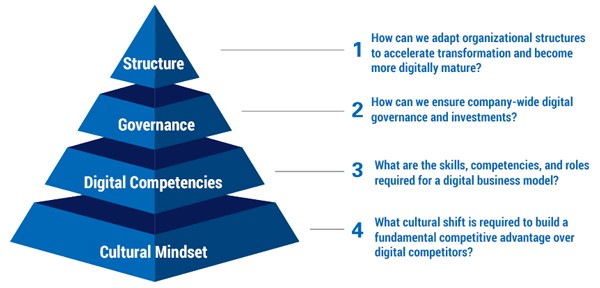
Figure 1 — Four key questions to consider for successful digital transformation.
(Source: Arthur D. Little.)
This Advisor takes a closer look at the first key point: adapting organizational structures to accelerate digital transformation.
To match the agility and customer centricity of digital players, analog-native companies need to break down their legacy functional silos and improve their overall structure. They must create organizations that foster cross-functional collaboration with processes (e.g., product development) that flow seamlessly across departments, enabling the digitalization of products, processes, and touchpoints in an end-to-end manner. Collaboration needs to stretch outside the organization to ecosystem partners and customers as well as internally throughout the organizational structure.
The choice of which organizational model to adopt to facilitate digitalization depends on multiple factors, including current digital maturity, intended target picture, urgency of change, and risk aversion. Figure 2 illustrates four generic models: (1) central, (2) integrated, (3) hybrid, and (4) centrally facilitated and fully integrated model. Each has specific pros and cons; the most appropriate model for any one company will depend on its specific context and objectives.

Figure 2 — Organizational structures to facilitate digitalization.
(Source: Arthur D. Little.)
Digitally aware organizations embarking on digital transformation may start with central models. This brings clear accountability and transparency at the expense of a possible “us-vs.-them” relationship with the wider organization. An integrated model overcomes this issue, providing greater momentum for change. However, it risks creating alignment issues due to unclear accountability and the difficulty of following a common vision. The hybrid model combines the positives of the central and integrated models but is more complex and difficult to deliver. Finally, the most digitally mature structure, the end state for many digital-native companies, is a centrally facilitated and fully integrated model. In this context, digital is fully embedded in the business model, products/services, processes, and mindset of the company.
Very few analog-native companies have yet to create dedicated organizational structures that facilitate digitalization. For many organizations, top management is still collectively responsible for both developing the digital strategy and steering the implementation.
To continue reading this article, please visit:

Online Article
“How Organizational Structure Contributes To Digital Transformation,
By Maarten Wensveen.
This is the second of a series of articles that explore what established companies should consider if they want to become more focused on technology. In my first article, I discussed how to overcome the fear of change, which is a major obstacle to any effective transformation in established companies. In this article, I’ll touch on how organizational structures can help drive the acceptance and adoption of change initiatives.
It’s quite common for companies to mandate digital transformation (or some other trendy change theory) without connecting it to the day-to-day experiences of their teams. This is especially true if organizational structures and decision-making processes aren’t adapted to the new mandate. Such mismatches between reality and rhetoric can make employees indifferent (if not openly resistant) to change. To prevent this, it’s important to make the desire for change tangible to all employees. In the case of digital transformation, the teams who build and maintain the technology must be fully engaged.
One hallmark of companies that embody the digital mindset is that they embrace autonomy for technology teams. Senior leaders still set the overall vision and define the competitive landscape, but technology teams are empowered to identify how they can best serve customer needs and advance the company towards its goals. This approach drives acceptance of the model and frees teams from detailed “master plans” or rigid processes, which can ultimately limit agility and growth.
Admittedly, my company has struggled with this in the past. An engineering team would propose a new idea, but it would take months for that idea to filter its way through our old “integrated business planning” process (that’s literally what we called it) and months beyond that to actually implement it. An entire year could easily pass before any of that effort translated to a measurable impact on customers. In the meantime, the engineering team would often lose interest or motivation. Even worse, we’d sometimes get beaten to market by more nimble competitors, or customer needs would simply change more quickly than we were able to address them. Needless to say, these long development cycles discouraged experimentation and innovation and ultimately held us back from being as successful as we could have been.
There’s an adage, often referred to as Conway’s Law, that companies create products and services which reflect their organizational charts and communication structures. So, if you have a traditional and hierarchical organization in which product development teams are separated from their users or customers by thick layers of business analysts, project managers, manager managers and so on, then the experience of using their products and services will often feel equally opaque, complex and muddied. This is fundamentally the problem that we faced, and we had to move beyond that.
We’ve since adopted a nimbler model in the technology organization which I lead. Our teams are organized around technology products which our various businesses can use to serve their own customers and employees. These cross-functional teams — which include software developers, product managers, user experience designers, business analysts and so on — own their product roadmaps and operate as if they’re dealing with external customers (even if their actual customers are just sitting one floor above them).
Teams are also tasked with conducting competitive research to validate that their solution is better than what’s available on the market. Moreover, it’s their responsibility to convince their customers that this is the case. When it comes to the classic “build versus buy” dilemma, we all start with a strong bias toward buy. We’ll only build something if we’re convinced that it can provide a significant competitive advantage over externally available solutions.
This approach moves the responsibility of denoting what’s next for the company down the organization chart. It’s a terrifying shift for executives who are used to exerting tight control over their teams, but it’s also a necessary one for any company that wants to maximize the advantages of being more digital. Senior leaders must balance the autonomy of their teams with the need to keep them focused and aligned on the overall vision — this is a delicate balance that I’ve written about previously.
Sometimes, I liken our model to the app stores that we use on our mobile phones. The apps (our technology products) are created by independent companies (our technology teams), and users (other parts of our business) choose which apps they want to install based on their respective needs. The app store’s operators (senior leaders in my organization) establish guidelines for the apps available in the store, which may include standards for user interfaces, documentation, interoperability and so on. We’ve all seen how app stores have created an incredible amount of innovation in the mobile space, and our approach captures some of that magic for our teams and the internal customers that benefit from their products.
At the end of the day, established companies that want to be more digital have to do more than talk about the end goal from a product or market perspective. They have to give technology teams the kind of organizational structure that will motivate them to own the vision and translate it into their daily work.
To continue reading this article, please visit:

Research paper
“Digital Transformation and Organization Design: An Integrated Approach,by Pooyan Khashabi and Tobias Kretschmer.
Abstract
The widespread implementation and adoption of digital technologies by organizations has given rise to a massive transformation with the potential to affect many organizations’ internal operations and processes. This transformation affects different levels and steps of output creation in companies, which eventually triggers changes in their organizational structures. This article develops an integrated picture on how digital transformation affects organization design by classifying and analyzing the effect on the process of output creation in firms. Based on this picture, it develops and elaborates on potential opportunities and challenges for companies resulting from digital transformation. Finally, it offers recommendations and decisions rules for dealing with these issues.
Digitization has drastically changed the way firms interact with consumers and the way they do business. In recent years, companies in nearly every sector have implemented initiatives to adopt new digital technologies and to harness their advantages. The process of rapid and widespread adoption and application of digital technologies in commercial settings is commonly referred to as digital transformation—and our focus is specifically on the recent and emerging digital technologies (i.e., artificial intelligence [AI], Internet of things, cloud computing, and big data). This transformation is expected to bring key changes to business operations, processes, and organizational structures aiming to provide competitive products and services to the market. Similarly, the extent of experimentation and adoption of new digital technologies is closely associated with the extent of strategic renewal in a firm. Indeed, the potential impact and scale is so significant that flawed and imperfect transformation can hurt companies in their competition. The benchmark for securing continued success is therefore not to do nothing, but rather to realize digital transformation in a sufficiently wide-ranging and competent manner. Failing to move fast enough can lead to a severe and lasting loss in competitiveness.
For example, in retailing, large incumbents experienced significant losses in market share and ultimately long-term competitiveness because they were too slow to adopt and roll out digital and analytical tools in their operations. While most of the established players such as Ikea had somewhat rudimentary online shopping services, Amazon and Alibaba managed to overtake them in sales growth and market share through their extensive use of digital analytics. Similar patterns manifest in numerous other industries as companies are competing to reap the benefits of this transformation as it is fast becoming a, if not the, key driver of competitive advantage.
Although the powerful effect of digital transformation is widely discussed in the media—mainly in the form of narratives about spectacular triumphs and failures of specific businesses—it is still not clear how digital transformation precisely impacts firms’ internal processes to create output and, eventually, their organization design. While there is emerging research on the (often technology-specific) effects of digitization on tasks, employees, companies, and competitive landscapes, we still see a need for an integrated view to generate a unified picture on how digitization affects organization design. In this article, we examine the big picture by breaking down the effect of digital transformation on each step of output creation within companies and then we discuss its aggregate impact. Hence, we take a microstructural approach to organization design. Following Puranam et al., we consider an organization as a “(1) a multi-agent system with (2) identifiable boundaries and (3) system-level goals (purpose) toward which (4) the constituent agent’s efforts are expected to make a contribution.” A microstructural view on organization design is mainly concerned with the process of breaking down the system-wide goals into agent-level goals and necessary contributions (disaggregation) and, once the individual efforts have been completed, the assembly of the individual inputs into a system-wide output (re-aggregation). This is complementary to the approach which treats organizations as a unitary entity.
Our conceptual approach has several important benefits. First, it is well known that organization design and management practices play a key role in performance. Second, by analyzing each step toward output creation, our approach lets us recognize the internal diversity in the adoption/application of digital technologies at different levels of aggregation. The microstructural perspective can therefore shed light on the effects of partial and imperfect transformation on the performance of companies. By contrast, organization-wide numbers often used to describe digitization at the firm from an external perspective—such as the number of IT staff or the use of specific technologies and software — may not capture the specific impact of this transformation, For example, an AI system can be used for a wide variety of functions, and “big data analytics” may support consumer engagement, internal staffing processes, or error detection. Therefore, the unitary entity approach to organizations, while being useful to explore topics such as industry structure or internal/external fit, is less suitable for understanding firms’ internal functioning and their improvement. Our approach also complements the traditional strategy literature that attributes firm heterogeneity primarily to location or industry. Finally, studying relevant cases through this perspective could provide lessons for firms that are already in the midst of or still at the beginning of adapting their structure to the increased opportunities offered by digital technologies.
To continue reading this research paper, please visit:
https://journals.sagepub.com/doi/10.1177/0008125620940296
Course Manuals 1-12
Course Manual 1: Hierarchical Structure
Hierarchical structure is a phrase used to define a type of chain of command within a firm, as indicated in the Executive Summary. This is the most prevalent type found in businesses. When viewed as an image, it creates a pyramid-style diagram that depicts organizational authority. When a business has a hierarchical structure, it will have one person at the top in charge of the entire operation. Following that, a growing number of lower management and supervisory positions are added.
Each department of a company usually has a manager to whom they report. These managers will then report to a manager or supervisor. This process continues until the board members are required to report to the CEO or the firm owner. This could be one or two department managers who report to the owner in a small business. This can become a complex system of branch managers, area managers, division supervisors, and so on in a larger organization. Employees who have no specific responsibilities but must report to their superior or supervisor will be at the bottom of the hierarchy.
A simplified hierarchical arrangement is shown in the diagram below. It demonstrates how the number of employees at each level declines until only one person remains at the top.
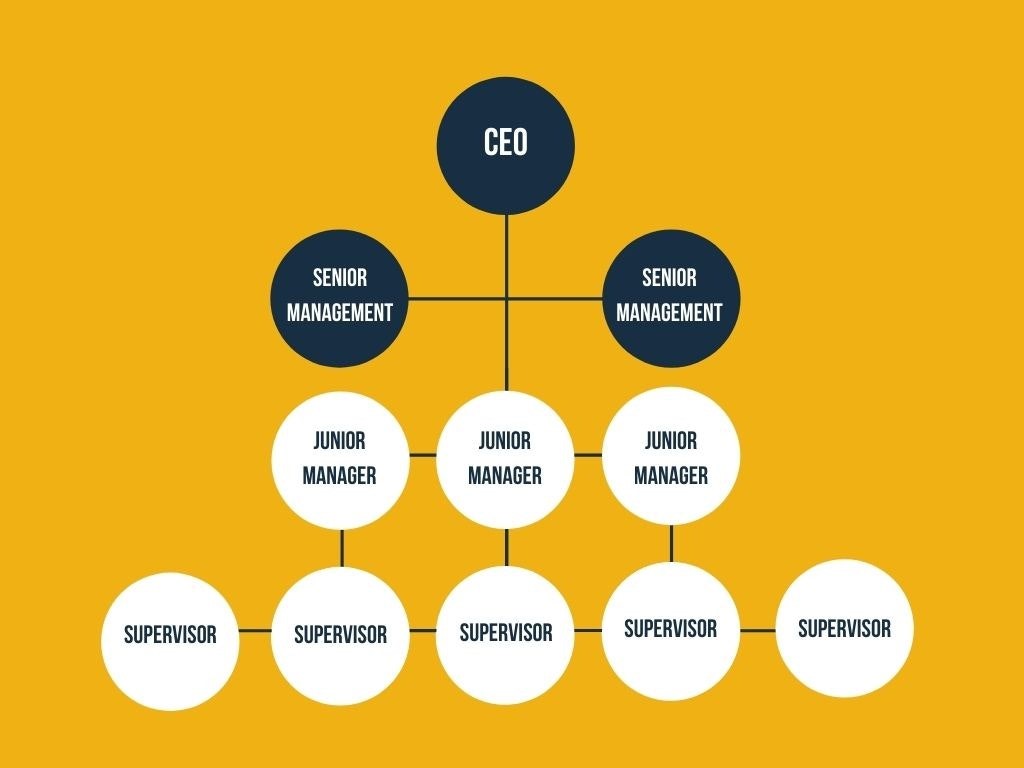
Hierarchical Structure
Companies that use hierarchical structures include:
• Amazon
• Barclays
• Walmart
Advantages of Hierarchical Structures
It is safe to infer that a hierarchical structure provides advantages because it is the most popular type of management model found in businesses. After all, if it didn’t work, businesses would find another solution.
The following are some of the benefits of using a hierarchical structure:
Levels of Control
A hierarchical structure indicates that several levels of power exist inside the company, but everyone understands what level of authority they have. Budgeting, expansion, and mergers will be major decisions made by upper management. The company’s day-to-day operations, customer experiences, and employee performance will be managed by those in the lowest ranks.
Well-Defined Career Paths
Each member in a hierarchy is aware of their current position as well as the positions above and below them. Many employees will gain from this method since they will know exactly what they need to do to advance in their careers. They’re also aware of the position they’ll be in once they’ve been promoted.
Specialized Staff
When a corporation establishes specialized departments to handle various tasks, such as finance, HR, or bidding, it also establishes more specialised staff inside these departments. Departments are more efficient and less likely to make mistakes when they have employees that are exceptionally proficient in their task.
Clear Reporting Procedures
This framework provides a clear avenue for communication, information reporting, and issue raising. Each member of the team is aware of who they should report to. This makes reporting and managing complaints much easier because everyone knows their responsibilities and there is usually only one person in charge of this information.
Team and Department Loyalty
Working as part of a group develops a sense of belonging. Staff want their team to succeed and be rewarded for their efforts. Employee performance and morale can both benefit from these feelings of loyalty.
Managers Who Can Deal With Relevant Issues
Because each department or sector has its own person in charge of the smooth operation of their segment, they are in the best position to deal with any problems that arise. Managers in a well-run organization will have a thorough understanding of their areas, allowing problems to be resolved swiftly without the need to go via other departments.

Disadvantages of Hierarchical Structures
Isolation and Siloed Thinking
The same grouping that permits department members to work successfully together also separates them from other parts of the organization, diminishing interdepartmental cooperation and communication. Departments can develop tunnel vision and become insensitive to the problems of other departments. When tensions are high, departments may prioritise their own aims over the company’s.
Centralization of Power
Power and authority are centralized at the highest levels feasible in hierarchical institutions. This might be problematic for a small business owner. Instead of making big-picture judgments, planning, and providing leadership, the owner may become engrossed in day-to-day operations, making decisions that should be left to people who are more familiar with the situation.
Endless Red Tape
The hierarchy of a hierarchical organization grows as well. Decision-making, communication, and action are all slowed by bureaucracies, and the corporation becomes a lumbering, rather than a nimble, entity. Communication and requests must travel up and down the chain of command, which causes things to slow down. In fast-paced business contexts, bureaucracy is the most destructive force.
What Type of Employee Will Thrive Under a Hierarchical Structure?
Each person is unique, and not everyone will succeed in every industry. Certain personality types, on the other hand, are more likely to succeed when working in a hierarchical organization.
Commanding Personalities
Those with authoritative personalities frequently do well in management positions because their authority is respected. They have the ability to inspire employees to complete tasks and achieve their goals to the best of their abilities.
People Pleasers
People pleasers excel in this system because they are constantly trying to impress those around them, which means they work hard to meet targets and goals.
High-Performing Personalities
This type of person thrives in hierarchical roles because they are always eager to perform well and respond positively when they are praised for their efforts.
Less Motivated Personalities
These people are more likely to thrive at the bottom of a hierarchical organization, where there are fewer demands on them to encourage themselves. They require the assistance of others in order to remain motivated.
Analytical Personalities
Analytical persons, like dominating personalities, typically thrive in positions of power. This is because they can accurately analyze what has to be done, how it should be done, and how it might be improved.

Hierarchical structures in the real world
Amazon’s organizational structure
Although Amazon’s service and experience were and continue to be at the heart of the company’s success, the company’s organizational structure also has a significant impact.
The thing with Amazon’s organizational structure is that it allows for a lot of top-down control over the company’s global e-commerce activities. Because the organization has multiple operations in several business areas, this is ideal. Amazon must maintain a framework that supports its diversified and quickly expanding market reach as a major online firm.
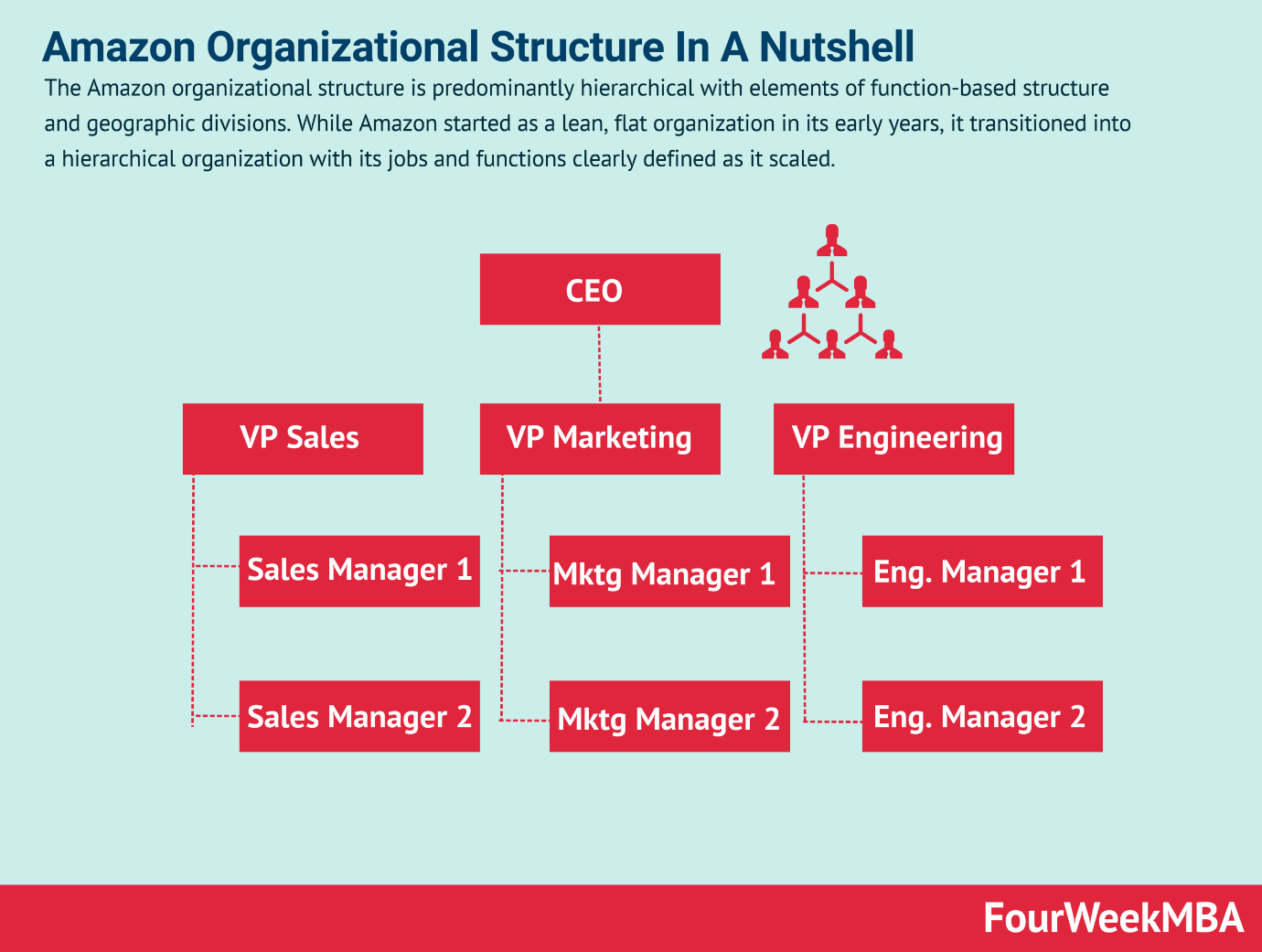
An overarching global hierarchy
Hierarchical architectures are revered by corporations. They were the original sort of organizational structure, and most large companies, especially those with a global reach, such as Amazon, still employ them today. Amazon’s hierarchy is articulated in terms of a global system with clear lines of authority that have a significant impact on the company’s operations.
For example, Jeff Bezos sits at the top of the company, exercising ultimate control over all senior executives and managers, who then issue orders to the sectors under their control, either at their discretion or at Jeff Bezos’ direction. These guidelines apply to all of the company’s relevant offices around the world.
Overarching hierarchies like this allow for comprehensive management control over whole enterprises, even when many product lines, services, and divisions exist.
How has Amazon used organizational structure to its advantage?
A huge, hierarchical organization is often thought to be inflexible and resistant to change. At Amazon, however, this is not the case. In the eCommerce market, the organization is a flexible and adaptable market leader. Indeed, Amazon has sparked innovation in both online marketplaces and global logistics.
In the face of centralized decision-making and top-down control, how is this status maintained?
The Two Pizza Rule is one of the major contributors. The Two Pizza Rule, which was instituted by Bezos, specifies that no meeting should be so large that two pizzas cannot satisfy the entire group. Efficiency and scalability are the goals here. Smaller groups spend less time organizing schedules and keeping others informed, and more time getting things done. As a result, each team has access to business resources in order to achieve short- and long-term objectives.
For example, a product team can add new product lines without consulting the project, process, or logistics teams. In a purely theoretical sense, these teams have greater autonomy than, say, an Amazon warehouse worker. They are, nevertheless, marching to the beat of Jeff Bezos’ drum.
Stability
The Amazon organizational structure is also famous for its stability, particularly in senior management.
Despite the fact that the S Team is constantly expanding, many members have held the same post for years, if not decades. The hierarchical model’s long-term success has resulted in a senior management team with a wealth of experience. As a result, Amazon has been able to grow and extend into new markets while maintaining its competitiveness.

Course Manual 2: Functional Structure
A functional organizational structure is used by companies that continuously manufacture the same commodities and have routine activities because its solid structure provides predictable stability.
Any structure that an organization demands can be accommodated. If the company primarily deals with projects, it will opt for a projectized structure. A functional structure will be used by a company that deals with operations. Because it defines your position and responsibilities and forms the work culture, your working style accommodates your organizational structure. The work atmosphere, reporting system, hierarchy, and other factors all contribute to the culture.
Every organizational structure has its own set of rules.
Team members report to the project manager in a projectized organizational structure. Employees report to a functional manager in a functional organizational structure however, it varies in a matrix organizational structure.
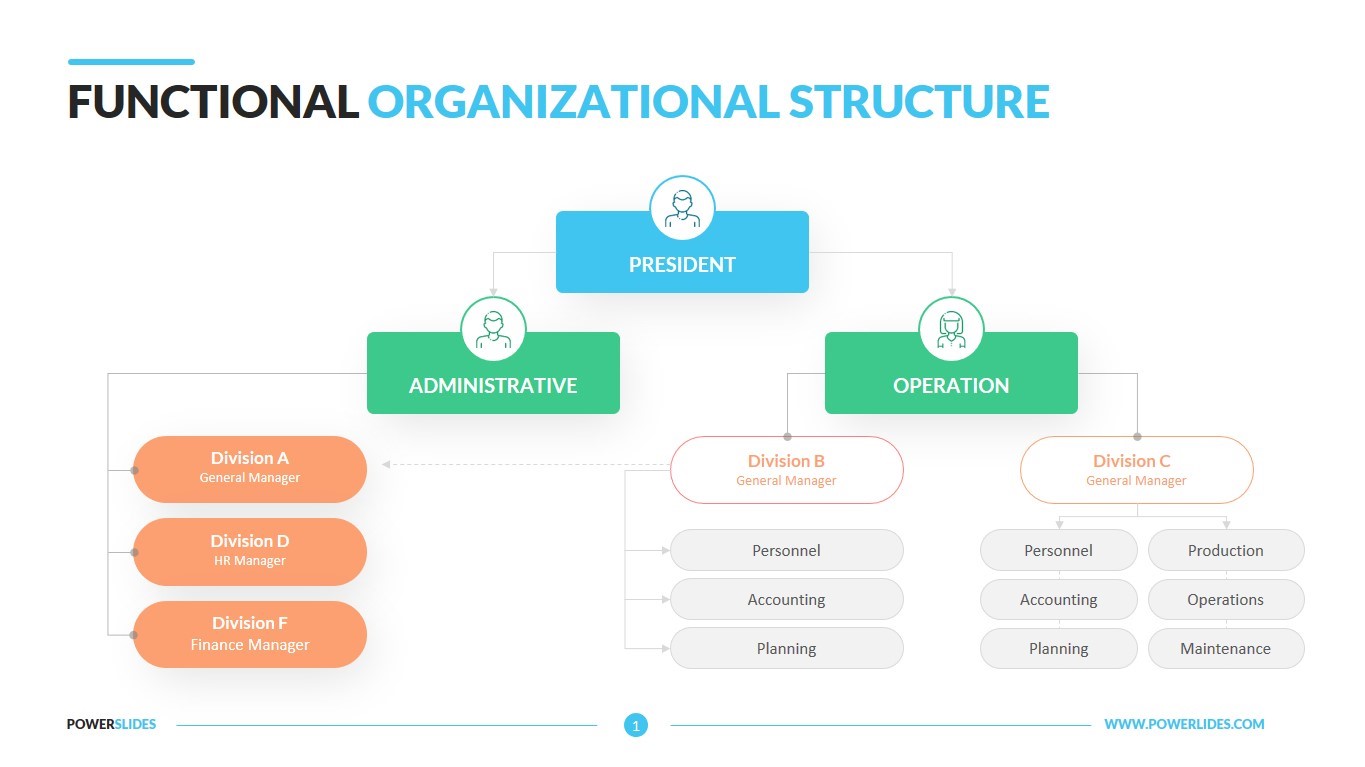
The organization is divided into departments based on their functions in a functional structure. Each is led by a functional manager, and personnel are divided into groups based on their responsibilities. Functional managers usually have prior experience in the roles they supervise, ensuring that staff are making the best use of their abilities. Companies can achieve their business goals by utilising a functional structure that maximises department expertise.
Employees are classified according to their role on an organizational chart under a functional organizational structure. The role hierarchy is depicted in this diagram (e.g., president, vice president, finance, sales, customer service, administration, etc.).
Each department has a leader who ensures that the organization’s performance is consistent and of high quality. These department heads are highly skilled, have extensive expertise in the same field, and deliver excellent results; as a result, productivity in a functional organization is excellent.
“Silos” is a term used to describe functional departments. This means that each department is vertical and isolated from the others, with communication flowing directly to top management through the department heads.
The functional manager retains all control in this situation. In most functional organizations, project managers play a minor or non-existent role. To use resources, project managers will need the consent of the functional manager, and they may act as a coordinator or an expediter.
In businesses that deal with operations, such as manufacturing, the functional organization structure works well.
Specialization and efficiency are the key advantages of functional organizational models.
Strength: Specialization
People with similar knowledge and abilities are placed together in a functional organizational structure. Employees can become specialists in their fields as a result of this. It necessitates a performance management system that enables for individual skill promotion, development, and visibility within their functional area. Functional structures hone specialization, which helps employees get in-depth knowledge and skill development, which can help you reach your company’s functional goals.
Strength: Productivity/Efficiency
Specialization improves productivity and increases operational efficiencies. Workers with specialized skills can complete jobs more quickly, efficiently, and confidently as a result of their experience, minimising the likelihood of workplace blunders. Furthermore, individuals can be extremely motivated to improve their careers as they move up the hierarchy due to the clear nature of the career path within the functional unit.
Other strengths include:
Same Knowledge in the Same Place
Those with similar knowledge are grouped together in the functional organization framework. Employees evolve into specialists when they advance within their disciplines, especially in technical fields. Businesses that use a functional organization and have a well-established performance evaluation tool will find it simple to promote from within as employees are coached and promoted. Employees have clear career goals and the direction to achieve them thanks to the in-depth training and targeted career path.
Better Performance and Information Sharing
The purpose of functional organisation is to centralize all human and informational resources required for a single activity. This improves performance by encouraging knowledge transfer from the top down. Sub-organization leaders are experts in their fields as well as the resources available, allowing each unit to achieve its full potential while avoiding overuse of limited resources. Standout personnel are promptly identified and placed where they will be most effective, thanks to specialised training and involved management, and managers are always on the lookout for useful skills and ideas.
Disadvantages of the Functional Organizational Structure
The following are a few disadvantages of the functional organizational structure:
• Employees may feel bored because of repetitive work. This monotony causes a loss of enthusiasm.
• Conflicts may arise if the performance appraisal system is not properly managed.
• A highly skilled employee costs more.
• Departments develop an insular, self-interested mentality. Functional managers pay more attention to their own departments and ignore others’ interests.
• Communication is weak among the departments. This causes poor inter-department coordination, affecting flexibility and innovation.
The following are some of the functional organizational structure’s drawbacks:
• Employees may become bored as a result of repetitious tasks. This boredom leads to a lack of motivation.
• If the performance appraisal system is not adequately handled, conflicts may occur.
• A highly skilled employee is more expensive.
• Departments develop a self-centered, insular mentality. Functional managers prioritize their own departments over the interests of others.
• There is a lack of communication across departments. This leads to a lack of inter-departmental cooperation, which has an impact on flexibility and innovation.
• Lack of collaboration between divisions stifles innovation.
• Employees may be unconcerned or uninterested in events occurring beyond their group.
• Change adaptation is difficult and sluggish due to the stiff functional structure.
• Because of the bureaucratic hierarchy, decision-making is slow.
• Functional managers have the authority to make decisions without involving the rest of the team. This does not bode well for the company’s morale.
• Personal prejudice can have a negative impact on staff morale. When a low-performing employee is promoted ahead of them, for example, an employee may become disheartened.
• Managing functional areas becomes more difficult as the company grows larger. The “silo” effect occurs when each department begins to act like a tiny business.
• Departmental goals may be more important to functional departments than organizational goals.
• Employees do not acquire new abilities, and their responsibilities do not change frequently, resulting in stagnation.
The primary goal of organizational functional structures is to bring together all human and informational resources in order to achieve the organization’s objectives. Because you may enhance performance by fostering peer collaboration across different units at various levels of management through monitoring and coordination, this can be a great structure for small enterprises that specialize on one product or service.
This structure is used by small businesses with a restricted number of products. Because of the repeated nature of their work, their staff are highly skilled, resulting in excellent efficiency and superior performance.
Employees get greater knowledge and expertise and become specialists as a result of being grouped according to their abilities and experience, making them more efficient and productive. They will work swiftly, with little likelihood of error, and produce high-quality results.

Examples of Functional Organizational Structure
Small businesses that deal with production can have a functional structure. They will, however, require aspects of a projectized structure as they evolve.
For example:
• Projects based on research to launch a new product
• Projects aimed at enhancing their product or operations
• Projects to build new production facilities
Summary
Organizations, particularly those involved in ongoing operations, benefit from the functional organizational structure. Employees feel safe, perform well, and are typically highly proficient in this environment. In a functional organization, project managers usually play no role. They will have a very restricted role and no authority if they exist at all. Employee positions are static in a functional organization, and they report to the functional manager.
Functional organizational structures in the real world
Starbucks Corporation (Starbucks Coffee Company) makes use of its organizational structure to help the worldwide coffee industry grow. The company retains its industry leadership in part due to the suitability of its organizational structure as the world’s largest coffeehouse chain. Management and leadership, communication, change strategies and management, and other aspects crucial to business performance are all influenced by a company’s organizational or corporate structure.
Starbucks adapts its organizational structure to meet changing business demands. For example, when the company expanded its operations by acquiring other companies like Ethos Water and Seattle’s Best Coffee, it had to change its corporate structure. Starbucks Corporation’s organizational structure is tailored to the demands of the company as a result of these changes. This structure fits into traditional organizational structure typologies. The company uses its structural characteristics to ensure that its operations are streamlined and properly managed, just like other multinational organizations.
Starbucks Coffee Company’s competitive advantages are bolstered by the company’s corporate structure. These competitive advantages are critical in interacting with the industry environment, which includes a strong force of competition as shown in Starbucks Corporation’s Porter’s Five Forces analysis. Large and small coffeehouses, as well as food service companies such as McDonald’s, Dunkin’ Donuts, Wendy’s, and Burger King, compete against the company. Starbucks Corporation continues to grow despite competitive pressure from these firms in the international market, thanks to the effective design and development of its organizational structure.
Functional Hierarchy
Starbucks Coffee’s organizational structure has a functional hierarchy that groups employees by business function. The company, for example, has departments for human resources, finance, and marketing. These divisions are most noticeable at the highest levels of Starbucks’ corporate structure, such as the corporate headquarters. This is a hierarchical characteristic. The corporate HR department, for example, implements policies that apply to all of the company’s cafés. The corporate structure’s functional hierarchy facilitates top-down monitoring and control, with the CEO at the helm. Starbucks Corporation’s generic competitive strategy and intensive growth strategies are developed and implemented by functional groups across the company.

Course Manual 3: Matrix Structure
Types of matrix management
There are three types of matrix management, each of which gives the project manager more or less authority. These management styles can be visualized as a scale, with the project manager at one end and the department manager at the other.
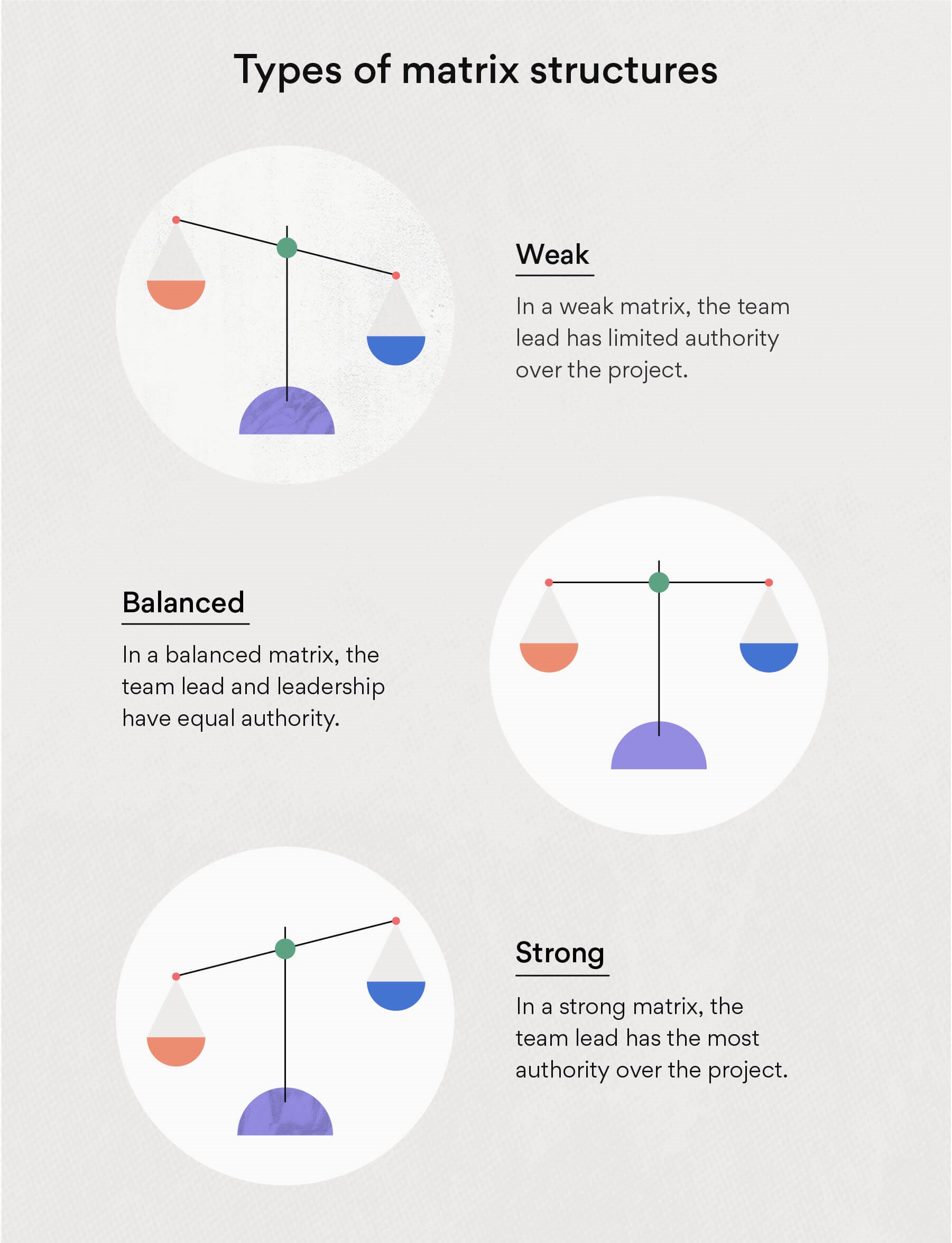
Image credit: Asana
Weak matrix
When compared to the other matrix management types, the project manager has the least amount of decision-making power in a weak matrix. Because the project budget and timeline are in the hands of the department head, the matrix becomes weak when the project manager has limited authority over the project. Creating a communication plan can help prevent communication from becoming muddled in a weak matrix.
Balanced matrix
In a balanced matrix, the department head and the project manager have equal authority and team members report to both of them. This keeps communication open between everyone in leadership roles and allows the project to move forward smoothly.
Strong matrix
In a strong matrix, the project manager has the majority of decision-making authority over the project, while the department head has less. Because the project manager has complete ownership of the project, it generates a strong organizational structure. Although the department head can oversee the project, he or she does not have the authority to make major decisions.
Advantages of the matrix organization structure
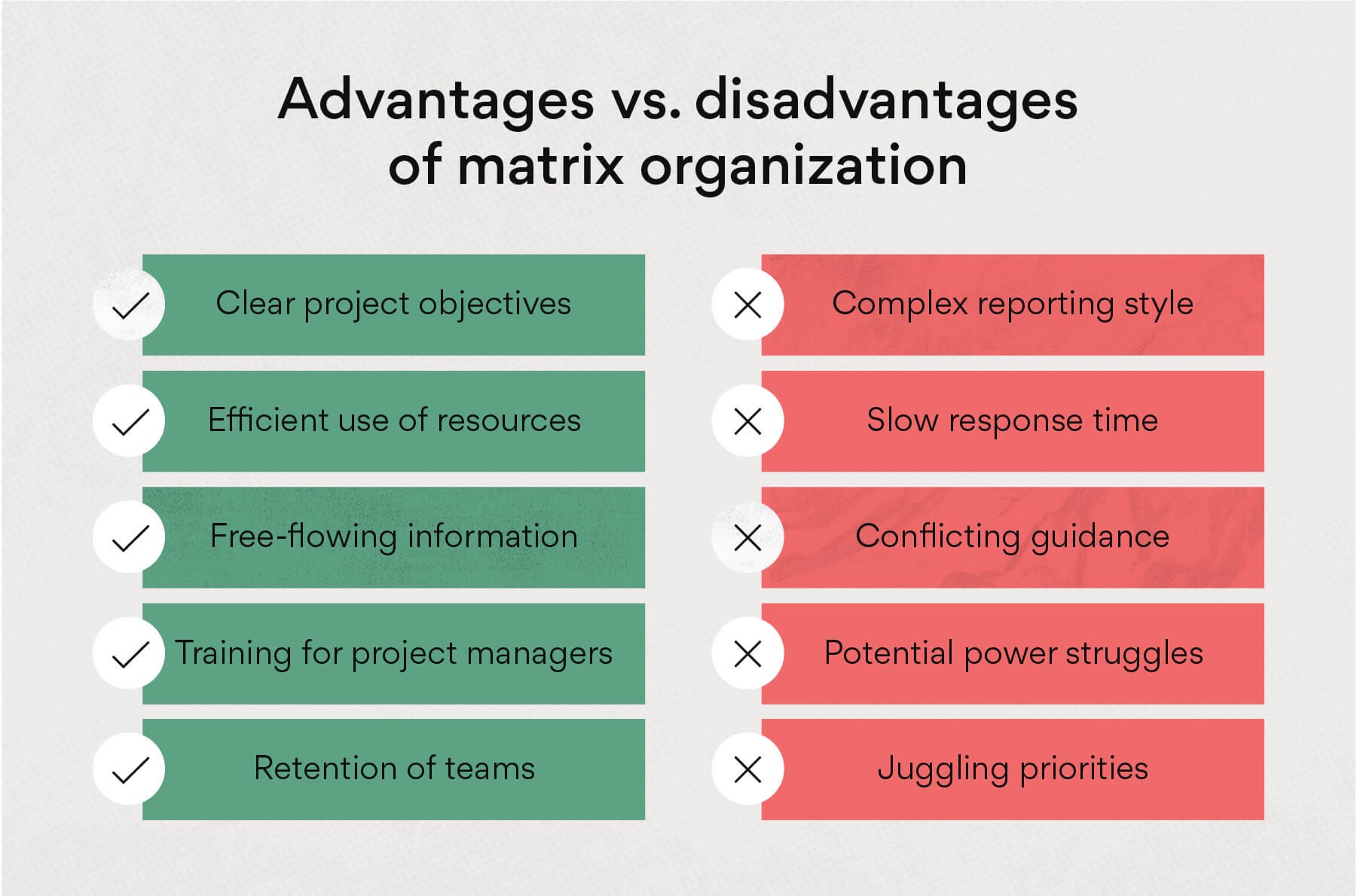
Image credit: Asana
Although the matrix organizational structure is more complex than the hierarchical structure, it offers numerous benefits. Clear project objectives, efficient resource utilization, free-flowing information, and project manager training are some of the benefits of the matrix design.
Clear project objectives
The matrix organizational structure can help to clarify project goals. Solidifying project goals is critical when your team reports their progress to both the project manager and the department head. Project organization becomes a priority when the project manager feels supported by other members of senior management.
Let’s pretend you’re working on an app development project with your team. The IT developers report to you as the project manager and the director of the IT department because you’re using a matrix organization. The goal of the project is to develop a mobile keyword search app for marketers. The app is produced faster when the IT department head and project manager communicate a clear project objective to the IT developers.
Efficient use of resources
Because teams contain specialists from diverse departments, the matrix form enables for optimal resource utilisation. This cuts down on overhead costs and the time it takes to finish a job. There are fewer managers per team in a hierarchical organisation where each team reports to only one manager. Because these teams do not comprise people with varying specialties, it may take longer for them to complete a single project deliverable.
Scenario: Specialists from the IT department, finance department, and marketing department may be part of the team developing the keyword research app. When these team members report to their department heads and project manager successfully, they boost team productivity, save time, and complete the project more quickly.
The matrix team saves money since organizations would have to restructure teams and maybe hire new team members every time a new product or service is developed if they didn’t have a pooled group of specialists.
Free-flowing information
Because each team reports to different leaders, working in a matrix structure allows information to flow freely between them. In a hierarchical organization, team members must remember to relay information, whereas the matrix makes information flow a requirement. Reporting data to several leaders may be laborious, but with the correct project management system in place, team members will have to do little or no more work.
Scenario: If the keyword research app’s development team simply reported to the project manager, information about a bug repair would be lost. When it’s part of the matrix process, however, transmitting information to the IT department head is simple.
Training for project managers
Project managers have a lot of responsibilities because of the matrix organization’s unique structure. Project managers are responsible for guiding their team through the entire project lifecycle. This structure challenges project managers and trains individuals who wish to be cross-functional managers in other areas.
Scenario: Your team encounters certain bug fixes and a delay in the project timeline during this project. It is your obligation as the project manager to liaise with the IT department head to resolve all concerns. As a result, you discover a personal interest in IT—as well as a future job option.
Team retention
When specialists are brought together, the product team stays strong, therefor the matrix organization has a remarkable track record of team member retention. These individuals work under the direction of functional department heads before being allocated to project managers. Working with specialists is often enjoyable, and it can improve project outcomes.
Scenario: The project team for the keyword research app consists of several IT, marketing, and finance specialists because these individuals are familiar with the ins and outs of developing a mobile application. This group of experts will most likely stick together in the future to work on a variety of projects.

Disadvantages of the matrix organization structure
The matrix organization, like the hierarchical and functional structures, has drawbacks. The majority of the drawbacks stem from the structure’s complexity. While complicated designs can be beneficial when they are implemented correctly, they also have the potential to produce conflict and chaos.
Complex reporting style
The intricacy of the matrix organisation might be a negative because teams may have problems knowing who to report to and when. While the matrix is intended to aid teams, it has the potential to complicate projects and confuse the whole process.
Solution: The easiest approach to avoid a reporting failure is to make sure that everyone in the matrix knows how to report and who to report to. The matrix structure can be made less difficult by using an easy project management software that supports cross-team collaboration.
Slow response time
The matrix’s complexity can cause slow response times, which can cause projects to be delayed. The necessity to report information to several people results in slow reaction times. Having more individuals participating is beneficial, but transmitting information to a larger number of people takes time.
Solution: The issue of slow response times with the matrix structure can be solved by using a project management system.
Conflicting guidance
If the project manager and department head aren’t on the same page, there will be conflicting directions. While the matrix form is intended to promote collaboration, depending on the personalities involved, it may have the opposite effect.
Solution: Create a system that allows managers to communicate directly with one another to avoid contradicting advice. Managers who are united on project goals and keep on the same page can prevent team members from feeling caught in the middle.
Potential friction
The fundamental distinction between a matrix and a hierarchical organization is that under a matrix structure, team members report to two managers. The matrix organization becomes more complex as a result, and team members are given more responsibilities. Having two managers can provide more feedback and assistance to team members, but it can also cause conflict.
Solution: It’s critical for the department head and project manager to communicate in order to avoid potential conflict. When there is a conflict between managers, it should not be the team’s responsibility to pick between them. Managers can avoid conflict by creating clear project objectives from the start and working together to generate a successful product, whether in person or through virtual platforms.
Juggling priorities
If managers don’t collaborate, it might be challenging for team members to juggle priorities in a matrix organization. If the department head believes his or her tasks are the most essential, and the project manager believes the same, the team may have difficulty deciding which manager’s advice to follow.
Solution: When team members are having difficulty prioritizing tasks due to manager misunderstanding, it is up to the managers to discuss the team’s tasks and decide what should be done first. The majority of challenges that may develop as a result of the matrix structure may be resolved by good team participation, communication, and clarity.
Examples of matrix organization
The world-renowned Dutch multinational corporation Phillips, which established the matrix organization structure in its company in 1970, is a real-life example of this type of structure. Managers were now required to report to both product division and geographical managers. Texas Instruments and Hughes Aircraft are two such companies that have adopted a matrix organizational structure.
Let’s say you’re an engineer in a functional department, and your organization gets a project that requires an engineer for a few days. You might then be assigned to that project also, and now you will have to report to two sets of bosses even if it is for a shorter time duration. This infrastructure where an employee will have to work under one or more leader is matrix structure.

Course Manual 4: Multidivisional Structure
A multidivisional organizational structure is one in which firm divisions work mainly independently to fulfil a specific task or control operations within a single region. These divisions all work for the company’s general good, but each is primarily concerned with sustaining its own operations rather than trying to keep up with the entire company’s operations.
The Walt Disney Company is a fantastic illustration of this. To keep its huge entertainment business running efficiently, it has a multidivisional organizational structure. While the firm’s film, television, theme park, and other divisions all strive to enrich the company and even collaborate to cross-reference content, each branch is still solely responsible for its own operations. Apart from senior management and administration, they are not ultimately answerable to any other divisions within the organization.00
Even though divisions may be segregated by function, this is not the same as what is known as a functional organization structure. Employees with comparable responsibilities are grouped together at the employee level in a functional structure to increase overall staff efficiency. Employees are hired inside the divisions in a multidivisional organization, and grouping happens at the functional level (or hired specifically to work for one division). Employees would be hired by the company in general and then grouped based on skill or the necessity to perform a specific role in a functional organizational structure.

Creating and Organizing Divisions
Creating a multidivisional organizational structure necessitates defining the many functions that different parts of your company execute and then splitting the company into divisions based on those activities. Each division will have its own manager and chain of command, and resources will be distributed differently based on the division’s needs.
Depending on the size of your company, separate divisions may be housed in different portions of the same building or have offices and other facilities in other locations. If some divisions focus on administrative or office-based work while others focus on manufacturing or sales, you may see many divisions spread out among a smaller number of locations based on necessity and purpose.
This isn’t to say that every job role requires its own division, or that there can’t be some functional overlap between components of two divisions. Each division should have a well-defined function within the organization, as well as the people, resources, and functional capabilities it requires to function as a cohesive entity.
For example, you might have two discrete divisions that each perform manufacturing or offer products or services to consumers, as long as each division’s goal is distinct enough that combining both components in a single division would be counterproductive.
Advantages of a multidivisional structure
• Organizational effectiveness is improved: A division of work improves organizational effectiveness in general. There is a clear division of labor between corporate and divisional management in a multidivisional structure. Divisional managers are in charge of their divisions’ day-to-day operations as well as adjusting divisional activities to the demands of customers. Corporate executives are in charge of long-term planning for the company as a whole, as well as matching the decision’s mission to the company’s objectives.
• Greater control: Corporate executives keep tabs on divisional executives’ performance. The increased oversight offered by the corporate office pushes divisional managers to focus more on internal organizational efficiency.
• Profitable expansion: When each division has its own profit center (and its individual profitability can be determined), corporate headquarters can identify the divisions where a capital investment will provide the best results. As a result, business executives will be able to make better capital resource allocation decisions to help the company expand. The multidivisional structure allows a business to expand without the communication or information overload issues that might arise when two responsibilities are merged, as they are in the functional structure.
• Internal labor market: Divisional managers who are the most capable are promoted to corporate managers. As a result, divisional managers are motivated to perform well since superior performance leads to advancement to a higher position.

Disadvantages of a multidivisional structure
• Managing the corporate-divisional relationship: A multidivisional organization poses a core management dilemma of deciding how much authority to centralize at the corporate level and how much to decentralize to the operating divisions. It is necessary to maintain a constant balance between the two. Too much centralization of authority can bind divisional managers, who lose control of decision-making to headquarters managers who are far removed from the firing line, leading to poor performance.
• Divisional coordination issues: When a multidivisional structure is established, effectiveness indicators such as return on investment can be used to assess divisional performance, and corporate headquarters can allocate capital to the division based on its success. One issue with this strategy is that divisions may begin to fight for resources, and their competition may hinder them from cooperating. When a company’s effectiveness depends on divisions exchanging knowledge and information about innovations to improve the performance of all divisions, such rivalry might impair organizational performance.
• Transfer pricing: Transfer pricing, or the price at which one division sells a product or information about inventions to another division, is a common source of friction between divisions. One division will desire a high transfer price to optimize its own return on investment, but this will penalize the other divisions, which are, after all, part of the same organization. As a result, as each section pursues its own objectives, coordination issues inside the company may arise. The corporate center’s job is to deal with such issues.
• Costs of bureaucracy: Multidivisional structures are exceedingly costly to run. The significant expenditures of running a multidivisional structure must be constantly weighed against the benefits gained by the organization. If the advantages outweigh the expenses, the corporation should consider shrinking its corporate headquarters, reducing the number of divisions, or lowering the costs of its support operations. It may be conceivable to switch to a product division or product team organization and service the demands of all of the company’s goods through a single set of centralized support operations.
• Problems with communication: It occurs in lofty hierarchies, especially when information is distorted. Because multidivisional structures are the tallest of all organizational systems, these issues are widespread. The divide between the corporate headquarters and the divisions is particularly wide.
Case Study: GM’s Multidivisional Structure Changes Over Time
General Motors has changed its organizational structure multiple times throughout the years, starting with the 25 autonomous operating divisions that made up the company in the 1910s. CEO Alfred Sloan established the multidivisional organization in 1920 to better compete with centralized, single-business Ford Motors. GM was able to reap the financial reductions that come with centralization while maintaining the flexibility and innovation that come with a dispersed organization. Sloan considered the multidivisional structure as having benefits such as enhanced accountability, easier resource allocation, and more autonomy and morale. In the 1980s, GM restructured once more to better compete with the cost-effective Japanese manufacturers, cutting the number of divisions and centralizing design and engineering. Sales plummeted, and the structure was abandoned as all GM vehicles came to look comparable.

Course Manual 5: Flat Structure
Who should use a flat organizational structure
A flat organizational structure is most common in smaller organizations, where employees can have a lot of responsibility and direct access to management without negatively impacting the company’s efficiency. If a larger firm has a flat organizational structure, it’s likely that they have a standard process in place that can function without the intervention of middle management. A flattened organizational structure may also be beneficial for firms that prioritize creativity and decision-making.
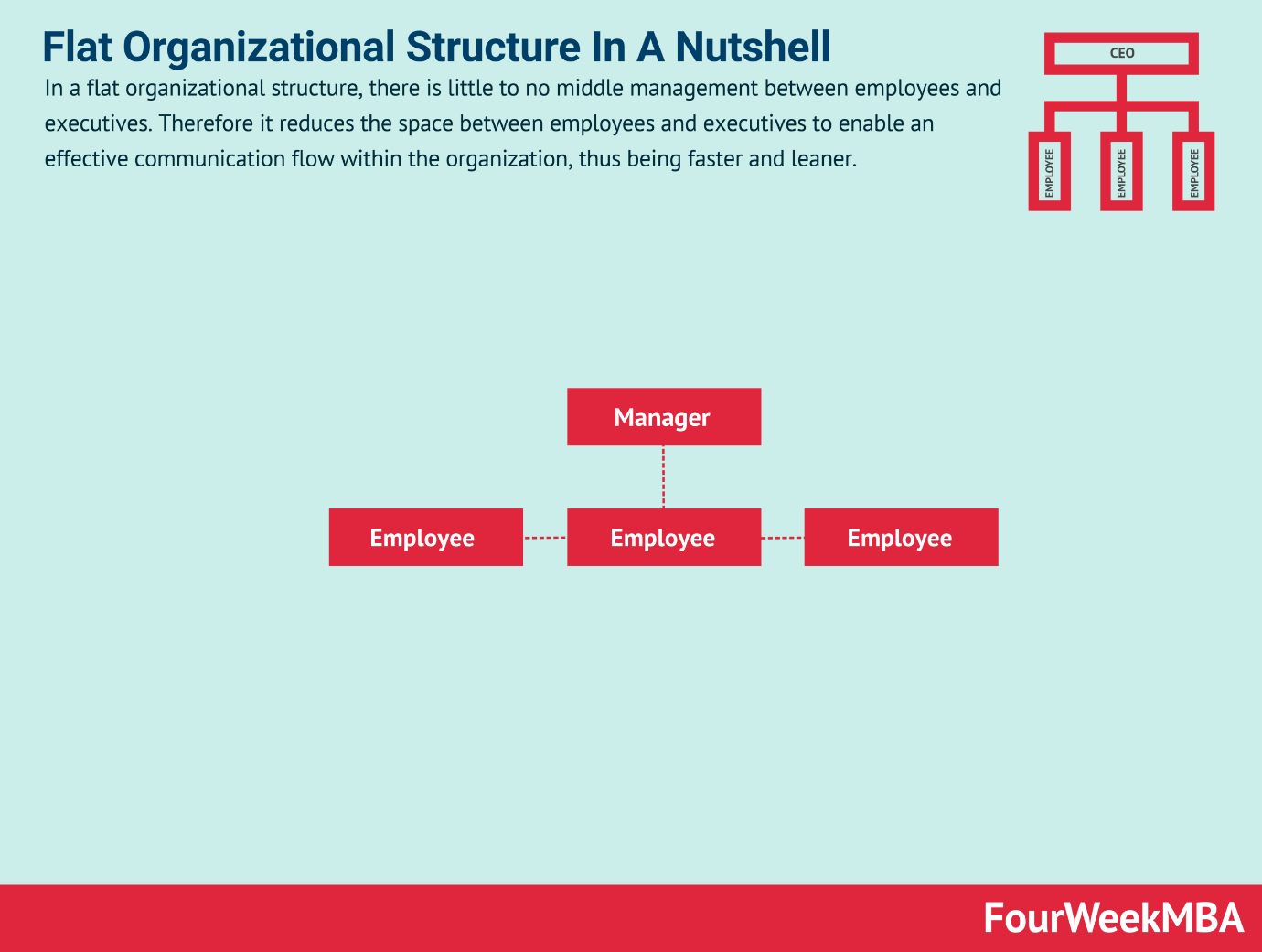
Self-managing teams
An organization with no middle management is a “strong form” of flat organization. Because there are too few employees to warrant hiring middle managers, very small enterprises may lack middle managers; in this case, the business owner or CEO may handle some of the responsibilities performed by middle managers in bigger organizations.
Some firms, on the other hand, do not hire middle managers even as they become larger, remaining exceedingly flat.
This model may be met or closely approximated in an organization with self-managing teams that plan their own work without the requirement for a middle manager or supervisor above the team. While the general aim or goal of a self-managing team is determined by a manager, the team is free to manage the means used to attain that goal. People whose career path expectations involve a promotion, which may not be available within the business due to its flat structure, may experience conflict as a result of this. Alternative “horizontal” career pathways, such as gaining greater competence in a function or mastering a craft, and/or obtaining salary raises for loyalty, may be possible.
The adoption and retention of necessary work procedures, including quality assurance procedures, is not hampered by the lack of middle management. However, because substantial responsibilities are delegated to team members, if a group of people agrees that the procedures they are following are obsolete or may be better, they may be able to change them. In some circumstances, such adjustments may necessitate the consent of executive management and/or customers (consider, for example, a digital agency producing bespoke websites for corporate clients). This might be an example of consensus decision-making or workplace democracy at the level of a team – or group of teams, if numerous teams are involved in the decision.
Valve is the most well-known example of a company with self-managing teams, as well as rotating rather than permanent team leaders, which Valve refers to as “group contributors,” in recognition of the fact that at Valve, contributing individually and leading form a spectrum rather than a binary dichotomy. A group contributor’s stay at Valve is usually limited to one project, after which they (voluntarily) cycle back to being an individual contributor. Valve also gives team members the freedom to work on whatever they want. This is known as open allocation, and it means that employees can swap teams at any moment, with no questions asked; all desks are on wheels to facilitate this. However, because new ideas often necessitate large resources, someone with a new concept may need to persuade a lot of co-workers to join them in order to form a new team and achieve the “critical mass” required for the new idea to succeed.
Valve’s co-founder has confessed that the company has problems catching incorrect actions early due to a lack of internal controls and supervisors. Valve works, according to Prof. Cliff Oswick of Cass Business School, because it hires high-calibre people who are a good fit for the leaderless atmosphere and because it was created as a flat organization from the start, so new hires always knew what they were getting into. He does warn, though, that the peer-review-based stack rating system Valve uses to determine staff remuneration could become problematic if the company runs out of cash in the future.
Other examples of companies with self-managing teams include the following:
• Qamcom Research and Technology, a Swedish specialist company with 125 employees active in the area of communication, radar and automotive systems (40% PhDs).
• Reaktor, a Finnish software and design consultancy with 400 employees that has a flat hierarchy and self-managing teams and also shares all the relevant business numbers with all of their employees.
• 37Signals, which has rotating, not permanent, team leaders. Some other digital agencies also use rotating team leads.
• GitHub Inc., which, like Valve, uses open allocation. However, in response to criticism, GitHub introduced a layer of middle management in 2014.
• Treehouse, which also uses open allocation.
• The Morning Star Company, which has no supervising managers
• Marc Rich + Co., once the world’s largest commodity group. Marc Rich + Co. utilized a flat management structure.

More benefits of a flat organizational structure
There are several other benefits to a flat organizational structure, including:
Increased responsibility
Because there is no middle management tier, most employees are given more responsibilities than they could otherwise have. This can make people feel more driven, valued, and invested in the organization they work for, which has its own set of advantages, such as better job satisfaction and a greater readiness to collaborate. Employees are better equipped to keep themselves and their co-workers accountable when they are given more responsibilities.
Easier dissemination of information
Any firm news or other sorts of information, such as procedural modifications, must usually pass-through multiple channels in a hierarchical organizational structure before reaching individual employees. This information dissemination is easier and faster with a flattened organizational structure, and there is less of a possibility that the employee may receive wrong or missing information. Employees may apply the information in their work when information sharing is straightforward, which can have a good impact on the entire organization.
Lowered operational costs
An organization that adopts a flattened structure may also realize lower operational costs because there are no middle management salaries to pay. This can assist a corporation in allocating resources to things like expanding the company, producing new product lines, improving employee training, providing incentives and raises to employees, or purchasing additional manufacturing equipment.
Better coordination
A flattened organizational structure may enable better cooperation amongst teams co-managing a project. Employees are more likely to be responsible for their own work since there are fewer tiers of management to gain approvals through. As a result, they may acquire better teamwork skills and come to shared conclusions on procedures faster than they would otherwise.
Higher productivity
Employees are usually more productive as a result of the autonomy, empowerment, and coordination that come with a flat organizational structure. Project approvals are often speedier, allowing personnel to begin working sooner and, as a result, complete tasks sooner. High productivity may help a company flourish and motivate people, leading to increased job satisfaction, readiness to take on new duties, and loyalty to the company.
Positive company culture
There are fewer layers of management to work through, so employees are more likely to get to know one another. Accountability, job justice, autonomy, and improved communication are all factors that contribute to a strong workplace culture. Top talent and competent individuals who wish to work for the company are also attracted by a positive company culture.

What Are the Disadvantages of a Flat Organizational Structure?
1. Bad decisions can be made under the guise of expertise.
Because the flat organizational structure is effectively a “bottom up” hierarchy, the front-line staff’s experience is heavily relied upon. The C-Suite may make choices based on bogus expertise if someone does not have the level of experience that their job requires. That can swiftly drive a company down the wrong path.
2. It can lead to a lot of wasted time.
Employees in this type of organization gain from being able to pitch their ideas to the C-Suite. A lot of effort is also spent conversing with others to make sure that an idea isn’t repeated before it is offered. Although having access is advantageous, because there are no continuous lines of communication between various departments or teams, a significant amount of time can be wasted when attempting to be inventive.
3. This structure can limit productivity.
The flat organizational structure presupposes that every employee will give it their all every day. In many cases, there isn’t enough supervision, so workers can get away with not working at all on some days. This is especially true for employees who may be working out of a satellite office. Although there are monitoring programs that can track productivity or worker presence, having a manager responsible for team productivity isn’t necessarily the same.
4. It isn’t scalable.
This arrangement works well for small businesses, but what happens if a company grows rapidly over a short period of time? Because this structure isn’t scalable, rapid expansion in a small business or startup can result in the C-suite losing control of their workplace. This can result in poor decision-making, inefficient conduct, and other bad job experiences.
5. There is a lack of work-life balance.
Many people who work in a flat organizational structure feel tethered to their jobs just about all the time. When the C-Suite sends out an email asking for a job to be finished or feedback to be given, there is a sense of “responsibility.” As a result, some professionals find it difficult to disconnect from their professional responsibilities when they are enjoying personal time, affecting their work-life balance.
6. It can encourage power struggles.
When the C-Suite is absent, a power vacuum is formed due to the lack of managerial definition in most flat organizational designs. In a small business, the C-suite may consist of only one person. When that individual leaves, the staff argue about who should be in charge if a replacement has not been appointed. This squabbling causes misunderstanding, which leads to animosity, which leads to a loss of productivity.
7. It can hinder employee retention.
Highly-skilled employees also appreciate the opportunity to move up the corporate ladder. There are fewer advancement opportunities in this firm structure because middle management positions are naturally limited. When an employee needs something new or different to accomplish, they may have few options, prompting them to look for a new employment rather than staying put.
8. There can be a lack of responsibility definition.
Many organizations with a flat organizational structure urge employees to perform a little bit of everything instead of having a defined position. Many workers find it challenging to stay concentrated on a single task as a result of this. When a task is swapped, the average person can lose up to 15 minutes of productivity. This reduces their effectiveness and, as a result, costs the company money.
These advantages and drawbacks of a flat organizational structure indicate that it can be successful when applied with a clear plan. Every structure faces obstacles, but when these drawbacks are addressed early on, their influence on the firm and individual employee can be successfully reduced.

Course Manual 6: Flatarchy Structure
Flat hierarchies have gained popularity in recent years as a viable alternative to more traditional organizational models. Flat hierarchies have been portrayed in some sectors of the media as a requirement for tomorrow’s successful businesses. This is not the case, however. They may be beneficial to certain organizations, but they are likely to be harmful to others. To help you learn more, we’ll look at some of the major benefits and drawbacks of flatter organizations.
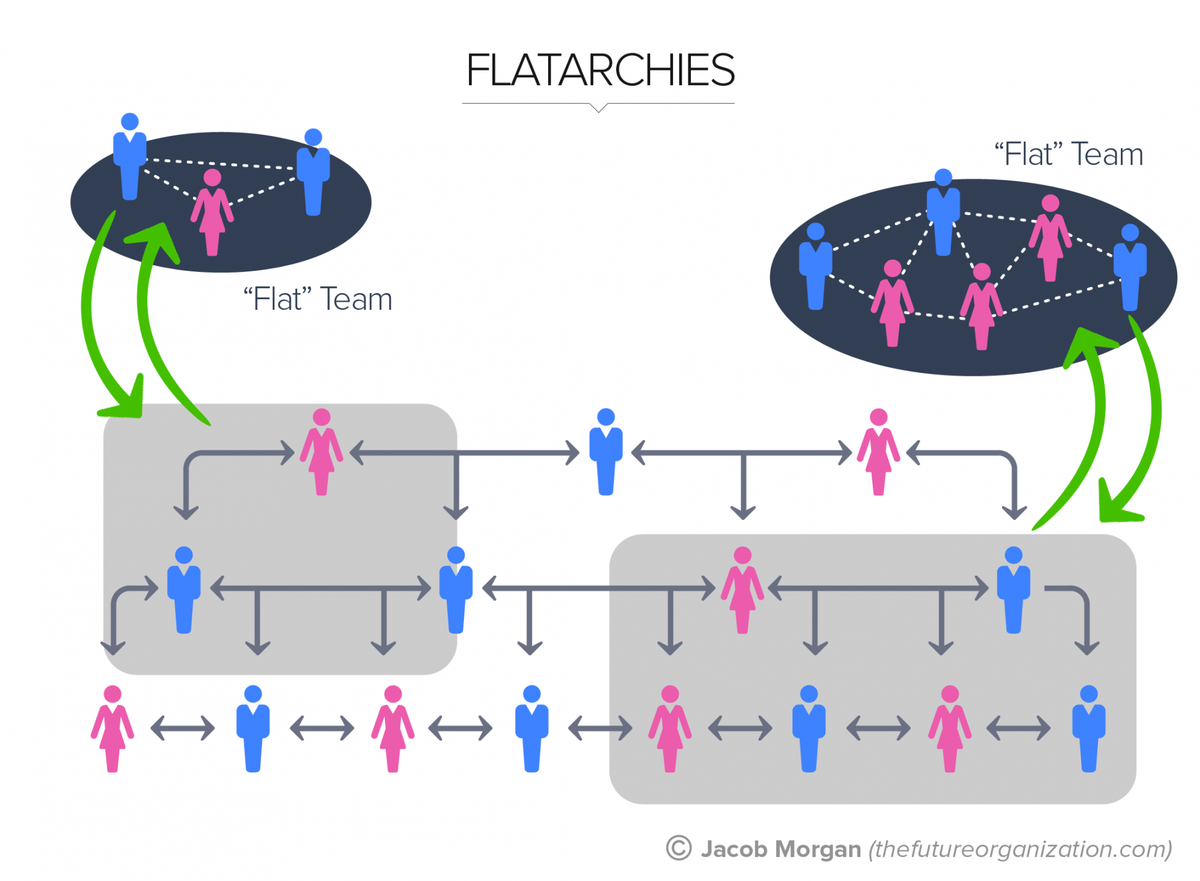
Flat hierarchies: a general definition
Holacracies have received a lot of media attention, but they are just one sort of flat hierarchy that has gained popularity as a result of its adoption by well-known corporations in Silicon Valley and the larger technology sector.
Holacracies and other flat hierarchies have a smaller-than-normal layer of middle management in common. There are no intermediary managers between employees and executives in some flat hierarchies, and decisions are made by self-organizing teams or rotating team leaders.
Others have fewer middle managers than you’d anticipate in a similar-sized traditional company, with each one overseeing a considerably bigger portion of the workforce. In general, managers in flat organizations have more responsibility and accountability. This is especially true when only one layer separates the workforce from the executive level.
Flat hierarchies: what are the pros?
Communication is clearer and less susceptible to degradation
By the time it reaches the frontline, information that has passed through numerous organizational layers has unavoidably degraded. Because nuance is lost when information is delivered electronically, the degradation is often more severe.
The degradation is likely to be less severe in flatter organizations, because information must pass through fewer layers before reaching the frontline. This certainly aids in the effective cascading of goals and decisions.
Decisions can be made faster and closer to the point of impact
There are invariably delays in traditional hierarchical organizations when decision-making authority is centralized in people. When people are gone, busy, or need to be brought up to speed on the nature of the problem before making a decision, for example.
Decisions can be taken at the point of need under flatter hierarchies, resulting in less delays in progress. Flat structures may be ideal for organizations that need to move quickly as a result of this. For example, companies seeking to gain a competitive edge by being the first to market.
Labour costs are reduced due to fewer higher-paid middle managers
Middle management is frequently the most expensive tier inside an organization. Organizations can cut costs by reducing the number of personnel in this stratum. This includes not only pay expenses, but also perks and training.
Some of this money may need to be redeployed into new incentive structures as organizations migrate to flat hierarchies. Although, due of the reduced layer of middle management, flat hierarchies will often save money on labor.
Increased autonomy and empowerment is motivating to employees
Flatter hierarchies increase employee autonomy, which is a crucial component in job satisfaction. Because there are fewer managers to defer to in flatter organizations, people are naturally more involved in decision-making.
Employees may also be more inclined to tailor their jobs to meet the changing needs of their job, the organization, and their coworkers, which can lead to increased autonomy as employees establish new areas of emphasis.
Innovation can happen informally and more quickly
Because innovation is not a ‘business as usual’ procedure, it frequently necessitates management approval. This could entail time-consuming procedures such as developing a business case to demonstrate the commercial value.
In traditional hierarchies, which prioritize stability and regulated growth, this means that innovation takes longer. Innovative decisions can be made as simply and swiftly as ‘business as usual’ decisions under flatter hierarchies.
This is why many start-ups and disruptive businesses prefer flatter organizational structures. Because the major goals are high-growth and innovation, rather than stability, cost-cutting, and a focus on the bottom line.

Flat hierarchies: what are the cons?
Informal, dysfunctional hierarchies may take the place of formal ones
According to Baker (2015), the absence of formal hierarchies in flat organizations creates a vacuum that allows informal hierarchies to emerge. If not addressed, it can be quite harmful. Personality, perceived skillset, and worth can all be used to create hierarchies.
Non-hierarchical structures may also be better suited to acquiring ‘soft power’ for those with more assertive personality types. Instead of being coerced, this is power that has been co-opted. As a result, de facto leaders who wield influence without formal authorization may emerge.
A lack of supervision and oversight means it’s harder to track productivity
Supervision is a cornerstone of hierarchical organizations, to a lesser or greater extent. This adds a layer of control over employee productivity and ensures that behaviors and outputs stay within the intended range. This enables businesses to ensure that all aspects of their operations contribute to their overarching strategic objectives.
Oversight takes time and is considerably easier with a managerial layer in place. The absence of this layer, or a much smaller layer, makes monitoring considerably more difficult, and organizations must rely on each employee’s talents, motivation, and expertise to contribute appropriately every day.
Scaling bureaucratic cooperation is difficult or impossible
Medium, a blogging site, has moved away from holacracy for a variety of reasons. One of them was that getting alignment across teams for major initiatives was difficult and time-consuming. They added that this approach could be controversial and disruptive.
This is why some researchers believe flat hierarchies function best in small-to-medium-sized businesses. However, as organizations grow larger and more bureaucratic, depending on collective buy-in and decision-making to move the entire machine as one can be too slow.
The lines between responsibility and accountability blur.
Diffusion of responsibility is a common problem with flat hierarchies. Because there are others there and it is unclear who has overall responsibility for performance, everyone is less inclined to accept responsibility.
In some flat hierarchies, employees are more likely to be generalists. Doing a little bit of everything, for example, dilutes responsibilities by removing clear boundaries of emphasis and responsibility.
On the other hand, a lack of defined boundaries of responsibility for some individuals can result in a weaker work-life balance. This is due to a sense of responsibility for everything and a willingness to pick up the slack when others fail to perform their part.
People may not be properly motivated by horizontal promotions
Promotion chances in flat organizations can range from scarce to non-existent, depending on the number of managerial positions. Promotion will almost certainly be limited to horizontal moves, with the benefits of learning new skills and being exposed to new situations.
They do not, however, provide higher levels of seniority or people management expertise, both of which are highly transferable to other contexts and organizations and are also associated with higher pay.
Employees who reach a point in their career or life where seniority and greater compensation become essential to them may be enticed to leave if these chances are not available.

Course Manual 7: Product Structure
Understanding Product Organization in Business
The product organization follows the functional method, but for each big product it sells, it forms substantial business units within the corporation. As a result, each of those product division units is made up of the functional divisions that are needed to support the product.
If a firm has a bakery and a garment division, for example, each product-based division will have its own sales department, marketing department, manufacturing department, and other functional units. Businesses with unique product groups that require specialized functional teams to support each product should use a product-based organizational structure.
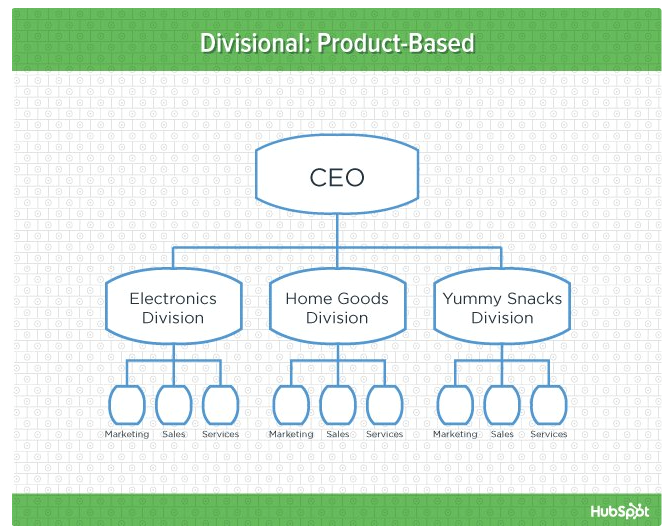
Facing disruption: when to consider a change to product structure
While some companies are forming product management teams for the first time, others are implementing organizational adjustments in reaction to market disruptions or changes in their business strategy. For example, a large enterprise technology company is transitioning one of its businesses from a GM model to a functional model to decrease engineering duplication and free GMs to focus on market wins rather than internal dynamics. Another enterprise IT firm is doing the opposite, converting to a GM structure in order to increase accountability for individual business segments’ success (building on top of a common platform).
Leaders are considering modifying their product organizational structures due to several internal and external challenges. The following are some possible internal change drivers:
• The choice to upgrade the architecture and use best-in-class agile continuous deployment processes.
• The need to break down functional silos over time and address a mismatch in engineering priorities vs product needs and consumer priorities.
• The need to increase revenue opportunities by boosting customers’ capacity to fully exploit the product suite by driving integration and coordination across businesses and reducing duplication of work caused by the GM model.
In addition to these internal drivers, many companies restructure their product lines in reaction to external disruptions and opportunities, such as:
• Cloud: Some companies are hiring new people and re-imagining their product structure and go-to-market strategy in order to produce cloud-native and SaaS products. Organizations must take a step back and rethink how to organize and succeed in a cloud-first environment in order to produce cloud-native products and transfer on-premise products to the cloud. Customers’ switching costs are minimal in a SaaS world, and consumer expectations for product capabilities are high. With current product development techniques and cloud-driven expectations for frequent releases and upgrades, businesses must have the correct organizational structure in place to meet these needs.
• Data: Improved AI capabilities mixed with data are yielding insights into user behavior that point to chances for improved product features and value-add. It’s become vital to develop a strategic data strategy and platform that spans products and consumer use cases.
• Platform and ecosystem: For many enterprises, “Platform” is becoming the ultimate destination. Many businesses are attempting to establish themselves as the platform of choice in their industry, and they want others to build solutions on top of their technological platform. This necessitates businesses’ ability to use other platforms/APIs while also developing their own ecosystem on which partners and developers can build solutions.
• New innovations: There are a slew of new breakthroughs in the pipeline (augmented reality/virtual reality, blockchain, and so on), and each one will present new problems to overcome as well as thrilling chances to seize. Organizations who can use these breakthroughs to generate better, more value-added products will stay ahead of the competition; those that can’t will be left behind. It will be vital for success to consider the best approaches to drive innovation and incorporate fresh areas into the mainstream organization and product strategy, regardless of the organization structure.

Looking at Product Division Structure Advantages
Using a product-based organizational structure has various advantages for both people and companies. One of the primary advantages from a business standpoint is that with a product model, failure in one division does not necessarily effect other divisions of the company. Even if the company’s bread section is losing sales, the clothes sector can still be profitable and have the resources it needs to expand. This can assist firms in reducing total risk.
The product-based organizational model also allows organizations to function with greater flexibility because each business division can follow the processes that are particular to their product without having to modify processes for other divisions. To stay ahead of the competition, the corporation may be able to reduce its development and manufacturing cycles and bring items to market faster as a result of this.
Employees benefit from the product-based organizational structure since it allows them to specialize in their role for a particular industry. Employees can learn new skills and build experience in particular areas as a result of this, which can help them advance their career ambitions within the organization and eventually lead to leadership positions. Employees may be exposed to new opportunities in their field as a result of the unique experience.
Avoiding the Pitfalls of Product Organizational Structure
There are downsides to consider, as with any organizational structure. This structure is only appropriate for larger companies with a diverse product line. If not, this organizational paradigm may generate issues. Operational inefficiencies are one of the major drawbacks to avoid. Because each division is self-contained, numerous people or entire departments may do redundant tasks, resulting in a loss of revenue and production.
There may be no effective lines of communication between divisions as a result of the product-based organizational structure. Employees find it difficult to exchange information on critical lessons to remember or specific training and learning materials as a result of this. When one marketing department learns something significant, they may not have a method in place to share it with the other.
Scaling a product-based organizational structure without introducing redundancy inside the business can be difficult. If each product division requires its own marketing, sales, production, and accounting departments, the corporation must discover efficiency to avoid losing money.
Is Product Organization Right for Your Business?
Before evaluating whether or not this model is good for you, think about the benefits and drawbacks of the product organizational structure. If you’re considering about implementing this model for your company, there are a few things to think about:
• Diversity of products: Are your products distinct enough to justify separate divisions? Is the manufacturing process the same for both? Is their target market the same? Make careful to specify how unique your products are. If they’re too similar, your procedures may suffer from a slew of operational inefficiencies.
• Structure of each division: Will each of your product divisions require its own functional structure, or will they all be similar? Is it necessary to have a production department for one product and a research and development department for another? You could be a strong candidate for a product division.
• Employee expertise: Do you already have personnel who specialize in one product, or will you need to hire additional people to staff your new divisions? Remember that acquiring and training new personnel involves time and money.
• Communicate strategies: How will information be shared between your product divisions? Companies can lose income and productivity due to a lack of communication between product groups. Make sure you have a system in place that allows functional counterparts to share information when it’s needed.
• Scaling opportunities: Will your product divisions be able to scale without adding to the number of redundant employees? Before it becomes a problem, figure out how much redundancy your organization can manage. Would you consider pooling resources across divisions if it meant more profits?
While there are numerous advantages to using a product-based organizational structure in your firm, it’s important to be aware of the drawbacks so you can actively avoid them.

Unilever’s Organizational Structure for Product Innovation
The corporate structure of Unilever is responsible for guaranteeing enough support for product innovation across the company’s global operations. The organizational structure of Unilever varies in response to developments in the consumer products industry and the worldwide market. Currently, the corporation has a system in place that meets corporate needs for managing product kinds all over the world. Unilever, as a premier consumer goods company, has an organizational structure that is well suited to its diverse global operations.
Unilever maintains its position as one of the world’s largest consumer products corporations because to an organizational structure that allows for effective product development. Unilever’s continued performance is ensured by such organizational structural design, notwithstanding the complexity of its global operations.
Features of Unilever’s Organizational Structure
Unilever’s organizational structure is divided into product types. The company is separated into sections based on the products they specialize on. The corporation, for example, has a segment dedicated to personal care items and another dedicated to home care products. Unilever’s organizational structure has the following main characteristics:
1. Divisions of product types (most significant feature)
2. Corporate executive teams
3. Geographical divisions (least significant feature)
Product Type Divisions. Unilever’s product type division works as a unit to manage the creation, manufacturing, distribution, and sale of its consumer goods. This characteristic of the organizational structure, for example, is used by corporate managers to match market needs with appropriate products. The company’s efforts to apply product differentiation, which is Unilever’s generic strategy for competitive advantage, are aided by this structural trait. This corporate structure is advantageous, especially given the company’s varied product line. Unilever’s organizational structure includes the following product category divisions:
1. Personal Care
2. Foods
3. Home Care
4. Refreshment
Unilever’s Corporate Structure – Implications, Advantages & Disadvantages
The assistance for product development and innovation provided by Unilever’s organizational structure is an advantage. Each product type division, for example, has its own semi-autonomous capabilities for developing items that directly address the needs of consumer goods market segments. This corporate structure is also useful because it allows Unilever to differentiate its products despite its global operations’ vast size.
Unilever’s organizational structure has the problem of providing little assistance for regional plan implementation. Despite the fact that regional divides are one of the organization’s structural aspects, the company places a greater emphasis on product type divisions. As a result, support for market-specific or regional strategic reforms is limited.
As a result, one suggestion for improving this organizational structure is for Unilever to place a greater emphasis on geographic divisions in order to empower regional management teams. In regional consumer goods marketplaces, such structural shift promotes strategic efficacy.

Course Manual 8: Project Management Structure
Organizational structures are evolving to meet the needs of the modern workplace as the globe progresses in the IT industry. The competitive climate for businesses is driving a demand for result-oriented workspace and corresponding improvements in the environment and culture.
People are tested on their understanding of how to handle various types of surroundings, therefore knowing what kind of organizational structure will suit a given type of organization is beneficial.
Organizations have grown into enormous entities that rely on collaboration among various stakeholders. People rely on their peers and other departments to assist them in achieving a goal or completing various duties. Employees are now encouraged to learn and grow from the various experiences they encounter on a daily basis. The personnel can then share their knowledge with their co-workers, allowing everyone to profit.
These are some of the procedures followed by an organization with a projectized structure. Adaptability and dynamic ways of thinking and functioning are two of the most important qualities of a projectized organization. Any company based on a projectized structure that lacks these will have a hard time succeeding.
Projectized Organization Structure
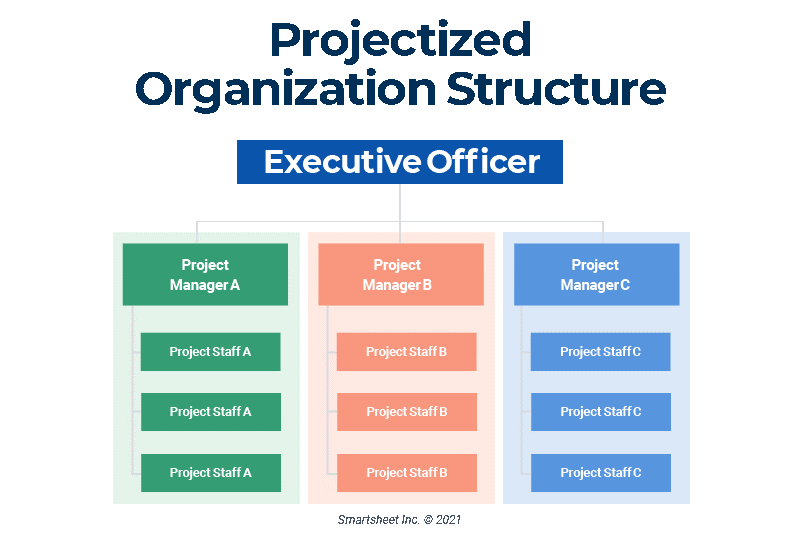
The first thing to realize about a projectized organization is that functional managers are uncommon. They have very little control over the personnel or how things are done in the organization if they have one. A project-based organization organizes activities into portfolios or programs, which are then carried out through projects.
The project manager, under these types of structures, has final authority over the project they’re working on. They are the only ones who report to the project’s team. Projectized organizations perform well because people are not obligated to find new methods to accomplish things. They allow the employee to learn on their own and from the experiences of their peers.
Project-oriented organizations ensure that the bulk of resources are dedicated to projects and that they are completed properly. Because most projectized firms’ output is predicated on deliverables from external clients, they will not be manufacturing items or services for their own use.
Accounting, administration, and human resources are some of the lesser departments that assist keep things running. When it comes to the organization’s essential functions, these make employees feel at ease.
In a projectized setting, the project manager has full-time team members reporting to them. If an external team member is to be added to the core team, they are categorized and positioned such that coordination and communication are not hampered. This improves their efficiency and produces a smooth work flow for project completion.
Although the project manager has complete control over the project, this does not imply that they are free to do whatever they choose. When a resource is available with one team but not required by the current team in possession of the equipment, the resource can be reallocated whether or not the management approves.
Project managers are given the authority they need to finish the project successfully in projectized companies, and the outcome is exclusively their responsibility.
Advantages
The obvious benefit of a project structure is that it gives you more control over your team, but there are other benefits as well:
• Teams with a strong sense of identity are more likely to succeed. It is the simplest structure for developing a strong team culture.
• Because the entire team is focused on the project’s aims, there is a conflict of loyalties between the project and the day job for those working on it. The project is their day job.
• Because resources are allocated to the project, scheduling work is significantly easier. You’ll know when the team members are available, and there’s no possibility of their being reassigned to routine work for another manager at short notice.
• Projects that follow this format provide excellent opportunities to hone your project management and technical leadership skills.
Disadvantages
The project structure is the most straightforward to deal with, although it does have certain disadvantages:
• Dedicating a team to a single project is an expensive investment. It’s usually only used on large projects.
• Removing people from their functional roles may make it difficult for them to return, especially if the project is lengthy. Returning to your prior employment after working on a new, hard project in a multidisciplinary workplace isn’t tempting to many people. As a result, managing the team’s transition when a project is completed becomes even more critical.
• If the business has moved on and another role isn’t available for you, closing a project may result in you losing your employment.
• Dedicated teams, by their very nature, squander resources in order to focus on a single task. They have the potential to limit the number of projects a company may work on at any given moment, especially when multiple projects require the same capabilities.
• Project managers in this structure also act as line managers for their teams, which means they have to spend time and effort on human resource activities that they wouldn’t have to perform in other models. This component could be advantageous if you appreciate the aspect of dealing with people.

What are the characteristics of a projectized organizational structure?
Now that we’ve covered the basics of what a projectized organization structure is, let’s look at some of its unique characteristics that set it apart from the functional organization structure we’re used to. Although projectized organization structures appear to be similar to functional organization structures, they have their own framework that distinguishes them from both matrix and functional organization structures.
A projectized organization structure has the following characteristics:
• The project manager directs the activities of the team members. These team members usually work full-time and on a permanent basis, and they inform the project manager of any updates or changes.
• The project manager has complete control over all of the project’s operations. This includes making decisions, assigning work to members of the team, and managing resources and funds.
• Once the project is completed, the teams and resources are demobilized. This is one of the characteristics that distinguishes projectized organizations from other forms of organizational structures.
Citing Examples
Let us use an example based on a real-life project scenario to properly comprehend the concept of projectized organization structure.
Let us use an example based on a real-life project scenario to properly comprehend the concept of projectized organization structure.
Let’s pretend that a project has two tasks. Project A and Project B are the names we’ve given them. This is a project for a video game that I’m working on. Let’s call this Video Game X—this is the project that the assigned team will be working on. The two projects mentioned (Projects A and B, in case you’re confused) are now listed under Video Game X. Project A entails creating game coding as well as conducting testing to guarantee that the game is free of bugs and other concerns. Project B, on the other hand, is concerned with the creation of graphics, such as concept art and rendering. A project manager is in charge of Video Game X. Should any updates be required, the members working on both projects report to the manager.
Projected Organization Structure’s Future
For a more ordered framework of activities and projects, some organizations use a projectized structure. Project managers are trusted to do the tasks assigned to them, and their abilities and skills are critical to the project’s success and efficacy. At the end of the day, the type of structure that the business believes would assist them develop in the market is still determined by the firm’s culture and ideals.

Course Manual 9: Network Structure
How the Structure Works
An organization considered as a central hub surrounded by a network of outside specialists is at the heart of a network organizational structure. The network organizational structure is depicted in the diagram below in a very simplified manner.
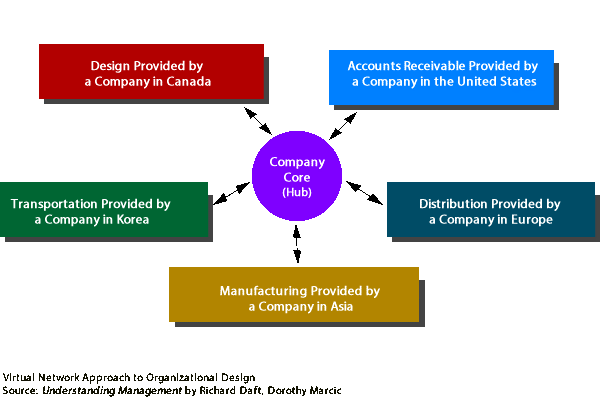
Accounting, design, manufacturing, and distribution are outsourced to independent organizations that are connected electronically to the central office rather than being situated under one roof. The central organization merely coordinates the operations of others in order for the product to reach the ultimate consumer in a timely and effective manner.
Organizations may communicate data and information so quickly and easily thanks to networked computer systems, collaborative software, and the Internet that a loosely connected network of suppliers, manufacturers, assemblers, and distributors can appear and operate as one seamless corporation.
One of the many benefits of a network approach to organizational architecture is that it allows a company to focus on what it does best while contracting out other activities to organizations with specific expertise in those areas, allowing it to do more with less.
Multinational organizations such as financial companies, computer suppliers, and mobile phone companies handle call centers and technical assistance for multinational corporations in nations such as India and Malaysia, as well as European locations such as Scotland and Eastern Europe.
Similarly, large portions of Canadas’s Bombardier and Brazil’s Embraer airplanes are engineered and built by outside contractors. Fiat Auto has a number of intricate outsourcing arrangements with other companies that handle logistics, maintenance, and some part manufacture.
These interorganizational interactions reflect a major shift in organizational structure. As a result of advancements in information and communication technology, the network organizational structure, also known as virtual network structure, has become considerably more possible.
Network Organizational Structure Examples
H&M (Hennes & Mauritz), a well-known brand with a global following, is an example of a company that has used network structure. H&M has outsourced the manufacturing and processing of their products to a variety of nations, primarily in Asia and Southeast Asia.
In this scenario, H&M is the main player. As can be seen, the core company delegated its tasks to many companies located in various countries: a product development company in Australia, a call center company in New Zealand, an accounting firm in Australia, a distribution firm in Singapore, and a manufacturing firm in Malaysia.
Outsourcing work to foreign nations, on the other hand, is not required; corporations typically do so to save money. Companies shift their production to China, for example, to take advantage of the low labor costs.
Managers have an important role in the network structure. They are in charge of both internal and external interactions. Because many layers of management are eliminated from between and their functions are handed on to other organizations, the network structure is less hierarchical and flatter.
Because of the network’s flat topology, it has a larger range of control, allowing for bottom-to-top communication. A network structure offers both advantages and disadvantages.

Benefits of Network Structure
A Sharper Focus
If a company eliminates all functions but its core competency, it may focus more clearly on what it does best. This is possible because to a network organizational structure.
For instance, if a company specializes in clothing design, it will not go through the trouble of manufacturing the fabric or stitching the garments; it will simply design the garments.
The chances of a company’s overall success are higher if it can spend most or all of its time doing what it does best.
Lower Costs
It is far more expensive to set up and run a department than to outsource that activity. Furthermore, when a company establishes a functional department, there may be significant sunk costs that are not recovered.
Work can be outsourced to other firms that specialize in that particular work using a network organizational structure. The company will not only save money, but will also receive a higher-quality service than if it did it on its own.
Flexibility
One of the key reasons why companies choose network organizational structures in the first place is because it allows them to be more flexible. An organization can be more flexible by outsourcing work. This enables them to change their production techniques, quantity, product designs, or even stop production entirely without experiencing any serious issues.
On the other hand, if the company controls all of the departments, changing things would be incredibly tough. Changing things around will not only be pricey, but it will also be inconvenient for everyone in the company.
Customers benefit from companies who are attentive to changes in demand. They get what they want in a short period of time. Furthermore, a company that performs a specific task for another company will not deduct from their earnings. They will also be hired by other businesses. As a result, it’s a win-win situation for everyone.
Network Structure’s Drawbacks
Control and Reliability
A network structure causes a company to become increasingly dispersed. It becomes increasingly difficult to maintain control over an organization’s network as it expands.
Additionally, some of the firm’s partners may be located in different countries. Communication and delivery become more challenging as a result. Furthermore, some of the companies that delegate work may be untrustworthy.
This causes delays in achieving deadlines and commitments, and as a result, the entire system suffers.
Lack of secrecy
When you outsource some work to another firm while pursuing a network organizational structure, that firm may also be conducting work for your competitors. The firm that works for you may disclose your company’s confidential information to your competitors.
Information leakage can occur for a variety of reasons, including being bribed for information, leakage by mistake, speculating about the job being done in the firm that is working for you, and so on.
Loss of control
You lose a lot of control over your operations when you outsource key work to outside organizations. Instead, you become reliant on external forces with great control over you in this manner.
They may fall behind in their work, fail to fulfill deadlines, purposely slow down, and so degrade the quality. A conflict of interest can also emerge between internal and external entities. It is critical to comprehend the full conflict process, as this conflict can obstruct the system.
Sacrificing of profit
You may be sacrificing profit that you could have earned if you had done the outsourced task yourself when you outsource work. For example, if you create your own goods rather than purchasing them from a third party, your company’s potential revenues may grow.
Outsourcing has the potential to be more expensive than doing the task yourself.
Conclusion
The advantages and disadvantages of network structure can be weighed, and we can come to the conclusion that the advantages outweigh the disadvantages. This can help to balance out the disadvantages and network structure. To begin with, whether a firm can maintain control over other firms that are being entrusted with the work.
Second, an agreement should be signed to prevent any personal information from being leaked. Furthermore, it should be ensured that buying from outside sources or outsourcing work is less expensive than doing it yourself.
If the conditions are met, work will be distributed.

Course Manual 10: Team-based Structure
Some criticized the phrase “team,” while others tossed it into the “business fad” pile, convinced that its 15 minutes of glory would come to an end as quickly as it began. They could be said to have missed the mark. Team-based organizational structures have been a force to be reckoned with for around 20 years, and now business leaders are ready to make a forecast that might endure another 20: Because team-based organizational structures are an effective method to manage a firm, the “trend” is here to stay.
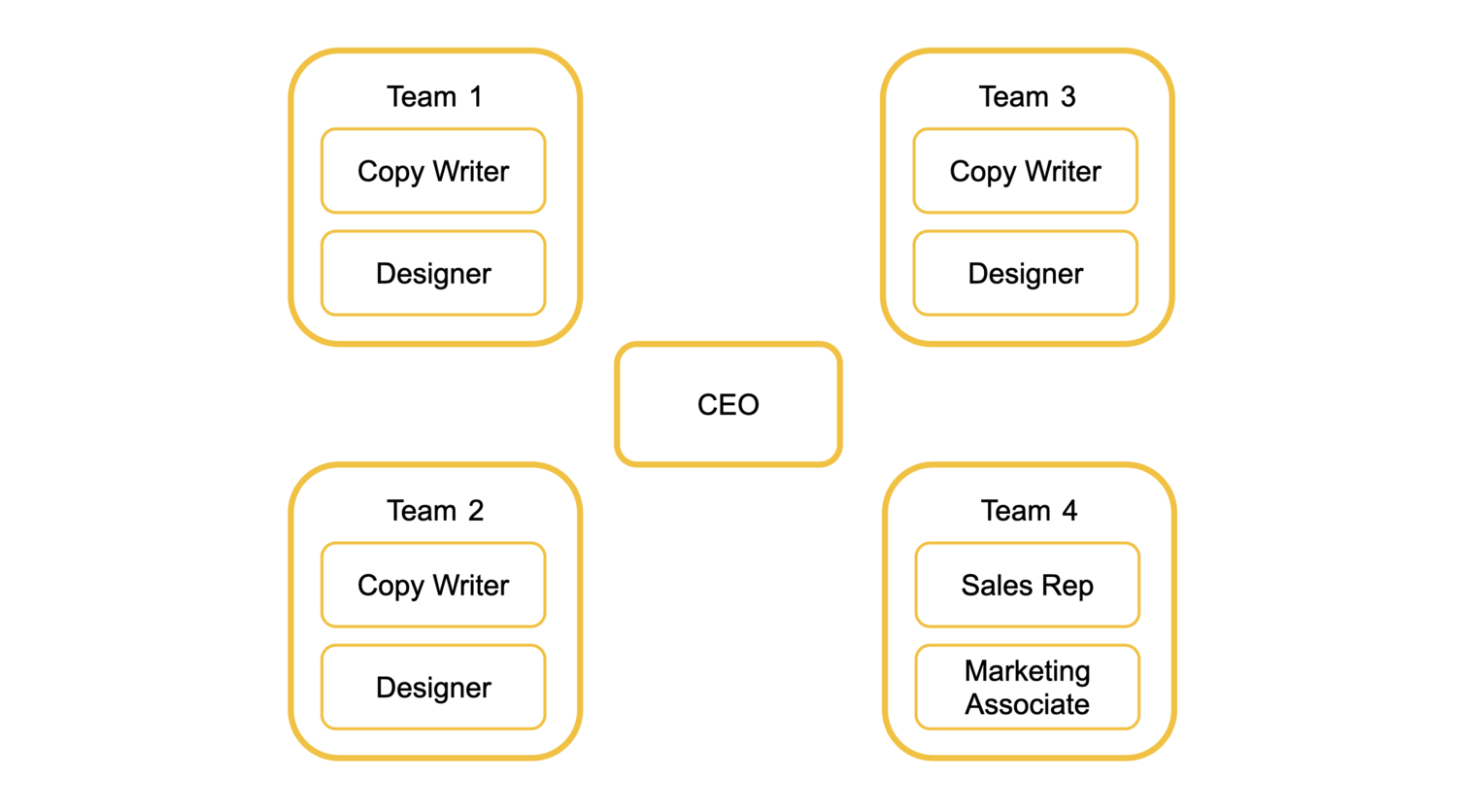
Asamby Consulting
Understand the Definition of a Team-Based Organization Structure
The team-based organizational structure, as its name implies, is one in which a group of employees collaborates as a unit. When the structure first appeared in the late twentieth century, the naming caused some misunderstanding. It does not imply that a team is merely a “rah-rah, go team!” in name. According to Lumen Learning, the structure necessitates that team members be picked purposefully for the abilities they bring to the fore, so that they can work together to achieve a successful feeling of synergy.
That goal could be short-term or long-term, and once the mission is completed, the team is usually disbanded. People working on one team, completing a project, and then moving on to another team to give their knowledge may be highly fluid under a team-based organizational structure. As you might expect, instances of team-based organizations are more common at Fortune 500 businesses like Google (and parent company Alphabet), which have a large workforce and a diverse range of skills.
The fact that team-based organizational structures are often less hierarchical is perhaps the most distinguishing feature. If there’s one thing that American corporations are known for, it’s their love of the hierarchical management structure, in which there’s a clear and direct chain of command from the top to the bottom. In general, this means that senior managers make all of the major decisions and pass them down via all of the lower-level command chains. Nevertheless, most working groups benefit from some structure, and team-based organizations typically make it obvious who is in control or who reports to whom.

The Case for Teams Begins to Take Shape
Companies have discovered that hierarchies aren’t always conducive to the innovation that drives growth and market distinction, according to Rise. The current flood of millennials into the labor market has exacerbated the problem. The early reservations about the team structure appear to be dissipating as organizations continue to introduce and experiment with it. The acceptance could be bolstered in part by studies from industry heavyweights like Deloitte, which reported the following in its 2019 Global Human Capital Trends report of 10,000 companies:
• 31% of respondents indicated they currently do “almost all” or “most” of their work in teams.
• After switching to a team-based organizational structure, 53% of respondents reported a “significant improvement” in performance.
Teams Can ‘Circle the Perimeter’
Deloitte was persuaded by the findings to make a bet on team-based organizational structures. “The global trend toward team-based organizations is growing for a reason: It is a more effective model for operating in the dynamic, unpredictable business environment typical seen today,” it stated, encouraging American enterprises to follow suit. We believe that, in the long run, there will be no leading company that does not work predominantly through teams.”
If there’s a catch – and there’s nearly always a qualifier to such broad projections – it’s that many organizations will adopt the movement in stages as their workforce increases. This may be especially true for small enterprises, which lack the same depth of talent as major corporations. To put it another way, small businesses may not have a choice. Even if they wanted to, many people couldn’t commit to a full-fledged team-based structure.
Deloitte also predicts that organizations – including yours – would mostly keep their hierarchical structure and embed a team when a great chance arises, such as when the company has to complete a unique project.
The dice may be cast in either case, according to Deloitte: “One of the fundamental changes in business today is the steady shift away from hierarchical models of management.”
Assess the Advantages
Some of the benefits of team-based organizational structures may appear self-evident, which is one reason why some firms may be skeptical of their worth. Even the most cynical business owner will understand that employees can learn more from one short-term team experience than two years of solo work when looking at a list compiled by Sandler Training. And who stands to gain the most in the end? The proprietor of a small business. Consider the following when working as a team:
• Clarifies the skill sets of employees. There’s nothing like a roundtable discussion between, say, a graphic designer, a writer, and a social media strategist to show where employees’ abilities lie and how team members must play to each other’s advantages.
• Encourages employees to share their knowledge and stimulates brainstorming and creativity. Nobody says your social media strategist has to (or should) become your go-to writer, but it stands to reason that if the two collaborate and routinely analyze your other’s work, the quality of the job will improve.
• Promotes strategic risk-taking and creativity. Even the most outlandishly dangerous ideas may be finessed when employees find strength and support in numbers. The most innovative ideas are sometimes born in high-risk environments.
• Raises the bar for competitive kinds to achieve excellence. Even if they were not competitive before being grouped as a team, they will most certainly begin to monitor each other more attentively in a positive way.
• Unlike any other employment experience, it fosters trust and bonds. Teams rapidly realize that their fortunes rise and fall together, and they will usually step up to assist, encourage, and watch each other’s backs. What happens if someone slacks off or misses a deadline? They respond with a tough look or reprimand, so the business owner doesn’t have to.
• Strengthens dispute resolution abilities. Even the most effective teams can become bogged down in conflict. One of the most valuable aspects of teamwork is learning how to put out embers before they engulf the team in a blaze of raging conflict.
• Promotes a sense of belonging, company involvement, and pride of ownership – all of which are valuable assets for a company that wants to keep its people happy, loyal, and invested in its success.

The disadvantages of a Team-based structure
Potential for Conflict
Personality conflicts within a team can have a detrimental impact on efficiency and group unity, which is a major drawback of a team-based organization. Although managers have the option of removing a disruptive employee from the team to maintain unity, this can be difficult because the disruptive employee would have to fit in with another team.
Some people do not work well in groups
Another disadvantage is that not all employees are well-suited to working as part of a team. Some employees work more efficiently on their own, and working in a group may not allow them to fully utilize their abilities.
Employees that aren’t performing well hide behind the team
Another disadvantage is that in a team situation, some individuals may rely on others to compensate for their own lack of effort. In other words, some employees may be able to coast on the efforts of others, necessitating the implementation of individual performance goals by managers to guarantee that each team member is putting forth the same effort.
You are capable of meeting the challenge
If there’s a drawback to the continuous shift toward team-based organizational structures, Deloitte found it in the small percentage of respondents who said they were ready to make the change: only 7%. Only 6% of respondents said they were confident in their ability to lead cross-functional teams.
As a result, the organization suggests that, before forming team structures, hesitant business owners take the first step toward instilling the concept of “team-based thinking” among:
• Individuals
• The team leader
• The entire team
• The organization
• The business’s ecosystem or external stakeholders
It’s true that while there is no “I” in “team,” there is one in “opportunity” and two in “vision.”

Course Manual 11: Process-based Structure
To address their firms’ lack of innovation, leadership teams are gradually investigating alternatives to the status quo. Transitioning to a process-based organization is unquestionably the most viable approach. A process-based organization is based on the concept of process management, whereas a standard org structure is focused on command and control management. The assignment of an owner to design, operate, and develop an end-to-end process is known as process management (or as close to an end-to-end process as possible). A process may have subprocess owners to oversee components that are geographically distant or require specialized skillsets if the scale or nature of the process warrants it.. A pharmaceutical R&D process, for example, may include specialized testing of a new product. This part of the process could be overseen by a sub process owner with the necessary knowledge and understanding of the testing procedure.
Process owners take the place of departmental managers and a variety of other leadership positions in a process-based company. Employees who carry out the process may report to the process owner or to localised management, such as a store manager in a retail establishment. Process owners develop, oversee, and alter their functions regardless of where they report.

In large, complicated companies, the benefits of this strategy are amplified. Departmental bottlenecks are no longer an issue. The misalignment of resources and disconnects between departmental priorities are no longer an issue. Even more powerful, the application of this paradigm necessitates the analysis and documenting of an organization’s fundamental processes. This information base’s importance cannot be overstated. Most leadership teams are unaware of what happens on a daily basis inside their firms. Unfortunately, the processes carried out by ground-level workers are the primary determinant of whether a customer has a positive experience or decides to switch providers.
To truly fuel the innovation engine, decision makers must have a thorough awareness of the day-to-day actions that take place in front of the customer. In other words, the company must be aware of its capabilities. A process-based business may create real, meaningful change by combining this knowledge with customer insights and analyzing it against probable competition reactions. Studying the customer, plotting market adjustments to align products to match the customer’s wants and needs, and then using institutional knowledge of the company’s operational capabilities to design and execute initiatives to take the company to the desired strategic position – this is the launch pad for game-changing innovations. This approach’s simplicity and directness can reenergize strategic laggards and breathe new life into firms in need of new ideas.
Unfortunately, switching from a traditional approach to one that is based on processes is not easy. Complacency and acceptance of the status quo have been developed by decades of “follow the leader” mentalities. The company’s DNA is encrusted with old habits and procedures. Change, in most cases, comes at a cost. It requires patience and perseverance. And, like the proverbial elephant that cannot be eaten in one sitting, it must be approached in incremental steps.
Starting small, building momentum, and gradually building the supporting structures until the new practices have taken root is the ideal method to handle such a transformation.
Phase 1: Start Light
The leadership team may not be fully committed at this stage of the transition, or only a portion of the business may be willing to move forward. A process-based paradigm has the advantage of being able to be adopted on a small scale while still delivering significant value. To begin, the original business unit’s fundamental procedures must be documented. Process owners can be named to oversee these processes once they’ve been documented. Then it’s time to have some fun. The next stage is to create feedback loops in order to capture and make available the desires and needs of the consumer base of the business units. Customers can be both internal and external to the organization. The process owners use this data to identify and design initiatives. Each initiative is expected to provide value once it is implemented. The innovation portfolio for the company’s participating areas is made up of the entire collection of these efforts. An innovation portfolio is a group of projects that can be prioritized and put into action. The values of the projects are changed over time to account for changes in the market and other circumstances, just like an investment portfolio. The business unit can then adapt its resources and emphasis to ensure that it is always delivering the most value to the company.
Phase 2: Build Momentum
The model expands beyond a small portion of the organization in the second phase. In Phase 1, all of the solution’s components that were in their infancy are extended and solidified. The initiative management function, for example, becomes more formalized (i.e. scoping, evaluating, prioritizing, allocating resources, and tracking initiatives). As the process evolves to include a greater scope, it often necessitates some reengineering. More importantly, the governance structure that controls the administration of the initiative management role must be selected, trained, and involved in the current activity. It’s a good idea to start a training program at this stage in the changeover. Process owners and teams must be taught on the fundamentals of process improvement and how to use process management as a management framework.
Phase 3: Formalize & Institutionalize
The methodology and frameworks are expanded to the rest of the company in this final phase. While the approach’s fundamentals are usually well-developed at this time, moving beyond the existing portion of the organization necessitates a significant amount of training and change management. The structure of the process and its documentation should be explored further and redrawn to incorporate the entire organization. The governance team expands to include members from additional areas, and the leadership team’s position becomes more formalized. Old ways of doing things and making decisions are being phased out. At this point, change management is crucial to ensure proper communication of the changes, as well as training and reinforcement of the new mode of operation.
Large-scale changes are never simple. In fact, they’re frequently absurdly difficult. Some employees may never be able to adapt to the new way of doing things and will leave. Others, on the other hand, will welcome the change, possibility, and simplicity that a process-based organization offers. The fact that employees have a clear picture of what is going on and where the company is headed is enough to boost morale. The ability of a process-based organization to precisely define improvement alternatives and promptly capitalize on them is, however, its greatest asset.

Advantges
• Quick and adaptable to a wide range of business requirements.
• Enables comprehensive data collection and analysis by tracking activities and their interactions directly.
• Allows for the streamlining of workflows in order to optimize project and department-specific processes, as well as overall business process management.
Disadvantages
• If not managed appropriately, several interdependencies can cause delays and harm production and efficiency.
• Over time, data and communication silos can form.
• Additional resources are required to ensure proper data gathering and management in order to optimize processes.
Conclusion
Companies are being forced to become more efficient every day as a result of competitive pressures. Only a small percentage of businesses can afford to operate in isolation; the others should focus on improving their operations. Process orientation is a great technique to cut down on non-value added operations. Academicians, consultants, and practitioners have acknowledged it as a management philosophy that can ensure better company practice.
Although there are many concepts and ideas associated with process orientation, one of the most powerful initiatives is process-based organization design. Process orientation is regarded as a very high priority level issue when an organization is structured around business processes. To eliminate unfounded anxieties, the process-based organization should be defined and communicated more openly and clearly, since this will increase the likelihood of its implementation.

Course Manual 12: Agile Methodology
12 Best Practices for Leading Agile Transformation
According to a Deloitte poll of over 10,000 senior executives, less than 10% of senior executives consider their present organization to be “highly agile” today.
This is a startling result, given that the majority of them believe agile transformation is essential for their companies to flourish in today’s fast-paced business environment.
Despite the fact that being more agile is not straightforward, there are several best practices that businesses should follow.
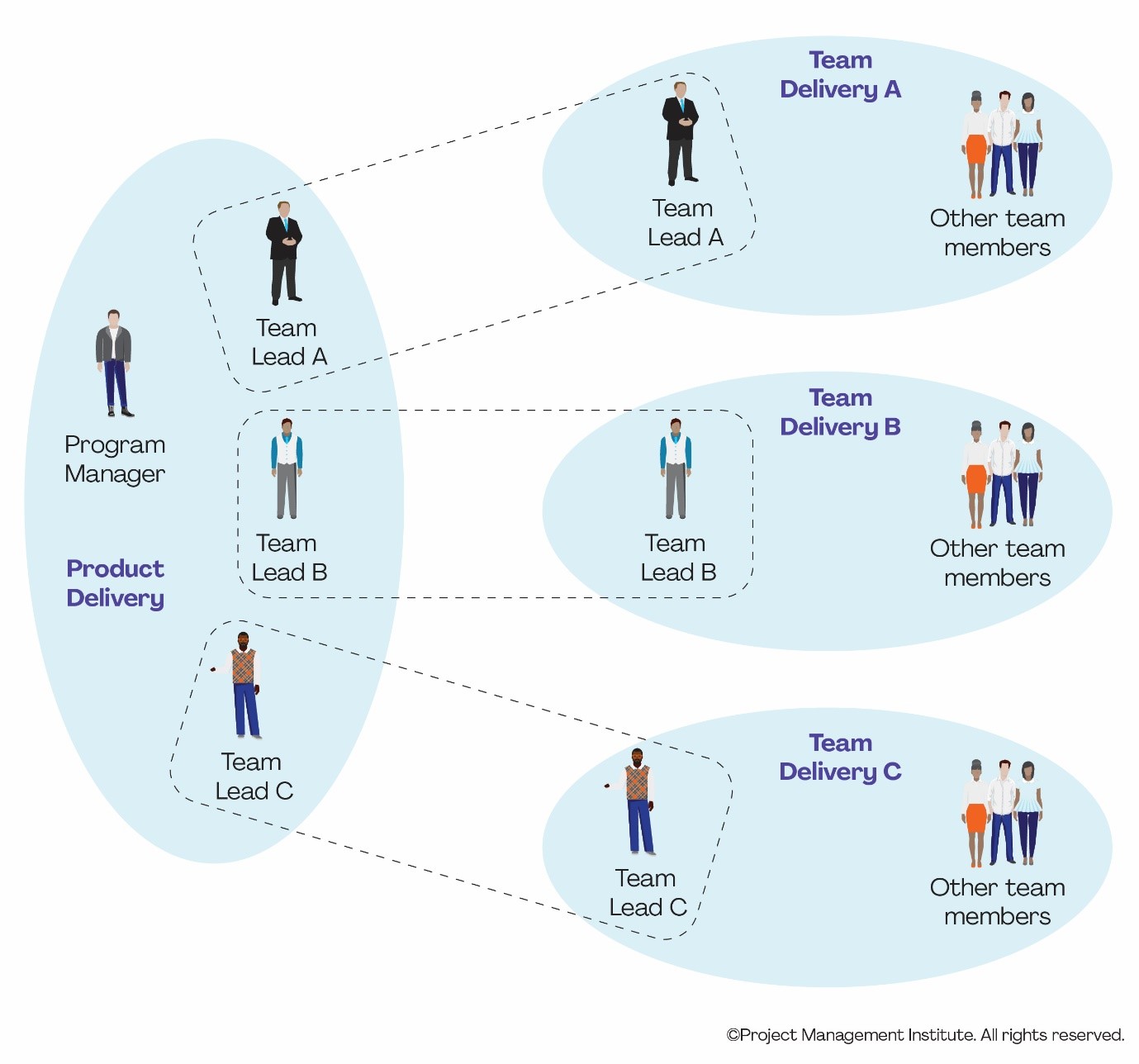
1. Agile structures and processes should be redefined
Organizations must first describe their new, more agile structures and processes before embarking on an agile transformation plan. Flexibility and speed necessitate the definition of agile structures and processes.
Organizations with linear, bureaucratic structures and tight command chains frequently make unproductive judgments and, as a result, struggle to become more agile. As a result of a lack of knowledge, transparency, and a robust staff communications plan, such firms work in silos and experience redundancy.
Organizations must adopt flatter hierarchies, embrace employee empowerment, implement new decision-making procedures, and build cross-functional teams in order to embrace agile transformation.
2. Organizations need to rethink their corporate cultures
Organizations must first understand the role employees play in the entire process in order to achieve agile transformation in the workplace, as it necessitates a fundamental shift in employees’ mentality and behavior.
Executives and their teams must be willing to operate in cross-functional teams, with a greater focus on employee engagement, self-management, and information sharing. Changing internal culture is the most consequential obstacle to transformation, accounting for the top three barriers to adopting and scaling agile.
As a result, the value of cultural investment on the journey to agility cannot be emphasized. According to research, firms that create the correct agile mentality among their executives and staff are far more likely to succeed in their agile transition.
Internal communications is the most crucial condition for achieving cultural transformation in the company, as culture takes a long time to alter.
3. Internal communications should play an important strategic role
Employee communication should always be clear and honest, but it is even more crucial during times of transition and transformation. As a result, employers must recognize the critical role that IC departments play in achieving successful agile transformation.
Corporate and business communications are responsible for sharing the organization’s agile strategy, developing trust in the workplace, opening channels of communication, aligning employees with the business goals, and empowering executives, as you will discover later in the Course Manual.
They’re in charge of ensuring that employees understand your company’s mission, goals, and objectives by communicating with them in a clear, effective, and transparent manner.
4. Employees must support the company’s strategic objectives
As previously said, aligning personnel with strategic goals is a critical component in removing barriers to effective agile transformation.
Nonetheless, according to The State of Scrum, lack of alignment is an issue holding up agile transformation for 29% of employees.
5. The advantages and consequences of agile transformation should be explained clearly and frequently
Employees must comprehend the benefits of becoming more agile for their own success as well as the organization’s overall performance in order to create organizational alignment. In order to reap the benefits of true organizational agility, the entire organization must comprehend the value of agile transformation.
Employees want to know why agility is worth investing in, how it will be done, and how it will benefit their jobs and careers before and during the agile transition.
As a result, to establish a complete change communications plan, change management teams, executives, and managers must collaborate closely with internal communications teams.
Take the current situation, for example. In these uncertain times, the Deloitte white paper referenced earlier provides an excellent example of what a healthy workplace communication plan should look like.
6. Internal communicators should generate and share motivating content
The creation of a collection of exciting, creative, and encouraging internal content is one of the most significant aspects of an agile transformation communication plan.
Even though IC departments should spearhead such efforts, it is critical that other teams participate in the creation of the IC editorial calendar.
Internal communicators nowadays must also be skilled storytellers. Creating a narrative that emphasizes the importance and advantages of agile transformation can make or break your success.
Only if your employees can relate to your messages and you deliver them in a real and personal manner will you be able to gain their attention and buy-in.
7. Leaders and managers should be role models for their employees
To successfully drive change, leaders and managers must recognize that agile transformation is more than a project or a new initiative; it is an ongoing journey that necessitates a different way of thinking than the top-down hierarchical approach.
Leadership buy-in, on the other hand, isn’t enough. Leaders and managers should always function as role models for the rest of the organization. Their actions and behaviors should reflect the traits that businesses seek in their employees.
Leadership and management must express their enthusiasm for the project, as well as inspire and guide its implementation. Leadership narrative, as well as honest leadership communication, play a key role here.
8. Teams and departments should be able to work together easily
According to Deloitte, 94 percent of businesses believe that “agility and teamwork” are crucial to their success. Despite this, few people nowadays claim to be agile.
Organizations must change to a networked, team-based collaborative structure during agile transformation because cross-departmental communication is essential.
Because diverse teams from various departments are frequently involved in this process, cross-functional collaboration has a significant impact on your agile transformation activities.
Many firms are building central response offices (CROs) to alleviate the effects of the current epidemic and create a collaborative, open, and inclusive virtual work environment, according to Deloitte.
IC, HR, IT, legal, and leadership specialists make up the majority of such teams. Their common responsibilities, according to Deloitte, are:
• Ensure that messaging is consistent across the organization—the single source of truth for everyone.
• Manage many communication channels, including confidential feedback and reporting channels.
• Provide organizational leaders with updates on the most recent public advisories from local, state, and national political leaders and health experts so that they may align on situations and actions.
• Be at the core of all remedial measures based on scenarios and triggers across all work streams. Coordination with the functions is essential, as is quick action.
• Create governance to enable cross-functional teams to work together.
• Evaluate any changes in working practices as a result of Business Continuity Planning (BCP) scenarios and clearly communicate acceptable working practices.
• Provide managers with consistent guidelines to maintain employee safety and engagement.
9. Mediums of communication that are flexible should be defined
According to the same Deloitte report, only 14% of firms believe their internal collaboration and decision-making procedures are effective, and 77% believe email is no longer a viable medium for effective communication and cooperation.
As a result, organizations must improve internal communication and deploy new technologies that allow employees from various departments to communicate and collaborate more effectively.
Emails and out-of-date intranets aren’t going to cut it. More user-friendly and mobile-friendly communication options should be considered instead.
Organizations must take into account the preferences of Millennials and Generation Z, as well as better understand how they communicate with one another. They must do all possible to provide technology that is similar to the smart and enjoyable apps that they are accustomed to using on a regular basis in their personal life.
10. Cognitive overload should be avoided
Another study shows that cognitive fatigue is one of the leading causes of failed agile transition.
This is why work processes must be simplified and new tools must be implemented. We have said that for agile transformation, networked and collaborative structures are required.
However, such developments may increase the need for teams to coordinate, resulting in an overabundance of meetings, emails, and communication channels. This cognitive overload can lead to considerable information overload and a significant drop in productivity.
Given that individuals spend hours searching for the information they need to conduct their jobs well, agile transformation is only conceivable if this obstacle is totally eliminated.
11. It is important to recognize and appreciate success
Because agile transformation must be handled on a regular basis after it is implemented, it is critical to express gratitude for new employee actions and behaviors in order to encourage them to embrace change even more.
Consider developing a recognition program centered on the new corporate values you want to instill in your staff. Recognize employees’ hard work and accomplishment when they perform in accordance with those values. This is an excellent method to encourage those practices in other employees as well.
12. Employee-driven communication should be embraced and encouraged
A surge in employee-driven communication, rather to communication initiated solely by leaders, managers, or internal communicators, is one sign of positive transformation in the workplace.
Employees should be able to start and lead company-wide dialogues that are visible to all at any time.
Agile transformation teams should be able to get input, ideas, and concerns from throughout the organization quickly and efficiently.
Remember that only organizational cultures that encourage and promote open and honest communication can be effective in agile transformation.

4 Typical Obstacles to Agile Transformation
It’s not easy to lead an agile change. Most businesses encounter hurdles when it comes to driving change in the workplace, which include:
1. A general aversion to change
Because it demands employees to adjust to new ways of working, most people are resistant to change. To gain employee buy-in, it is the employer’s responsibility to carefully, explicitly, and consistently communicate the benefits of agile transformation.
2. A lack of management and leadership support
Even if you succeed in gaining staff buy-in, agile transformation would be impossible without the support of leadership and management. They play a critical role in the workplace because they account for the majority of employee engagement.
3. Ineffective internal communication
One of the most common reasons for change failure is a lack of communication in the workplace. As a result, internal communications departments must collaborate closely with agile teams and develop a strategy for communicating updates on the agile transformation, including how, when, and through which channels.
4. Inability to supply appropriate technology and tools
There are, fortunately, solutions that make agile transformation much more manageable. However, many organizations overlook the importance of technology in becoming more agile.
Workshop Exercises

Organizational Structure Exercises
01. Hierarchical Structure: Explain in your own words how this process will directly impact upon your department?
02. Functional Structure: Explain in your own words how this process will directly impact upon your department?
03. Matrix Structure: Explain in your own words how this process will directly impact upon your department?
04. Multidivisional Structure: Explain in your own words how this process will directly impact upon your department?
05. Flat Structure: Explain in your own words how this process will directly impact upon your department?
06. Flatarchy Structure: Explain in your own words how this process will directly impact upon your department?
07. Product Structure: Explain in your own words how this process will directly impact upon your department?
08. Project Management Structure: Explain in your own words how this process will directly impact upon your department?
09. Network Structure: Explain in your own words how this process will directly impact upon your department?
10. Team-based Structure: Explain in your own words how this process will directly impact upon your department?
11. Process-based Structure: Explain in your own words how this process will directly impact upon your department?
12. Agile Methodology: Explain in your own words how this process will directly impact upon your department?

SWOT & MOST Analysis Exercises
01. Undertake a detailed SWOT Analysis in order to identify your department’s internal strengths and weaknesses and external opportunities and threats in relation to each of the 12 Organizational Structure processes featured above. Undertake this task together with your department’s stakeholders in order to encourage collaborative evaluation.
02. Develop a detailed MOST Analysis in order to establish your department’s: Mission; Objectives; Strategies and Tasks in relation to Organizational Structure. Undertake this task together with all of your department’s stakeholders in order to encourage collaborative evaluation.
Project Studies
Project Study (Part 1) – Customer Service
The Head of this Department is to provide a detailed report relating to the Leading IT Transformation process that has been implemented within their department, together with all key stakeholders, as a result of conducting this workshop, incorporating process: planning; development; implementation; management; and review. Your process should feature the following 12 parts:
01. Hierarchical Structure
02. Functional Structure
03. Matrix Structure
04. Multidivisional Structure
05. Flat Structure
06. Flatarchy Structure
07. Product Structure
08. Project Management Structure
09. Network Structure
10. Team-based Structure
11. Process-based Structure
12. Agile Methodology
Please include the results of the initial evaluation and assessment.
Project Study (Part 2) – E-Business
The Head of this Department is to provide a detailed report relating to the Leading IT Transformation process that has been implemented within their department, together with all key stakeholders, as a result of conducting this workshop, incorporating process: planning; development; implementation; management; and review. Your process should feature the following 12 parts:
01. Hierarchical Structure
02. Functional Structure
03. Matrix Structure
04. Multidivisional Structure
05. Flat Structure
06. Flatarchy Structure
07. Product Structure
08. Project Management Structure
09. Network Structure
10. Team-based Structure
11. Process-based Structure
12. Agile Methodology
Please include the results of the initial evaluation and assessment.
Project Study (Part 3) – Finance
The Head of this Department is to provide a detailed report relating to the Leading IT Transformation process that has been implemented within their department, together with all key stakeholders, as a result of conducting this workshop, incorporating process: planning; development; implementation; management; and review. Your process should feature the following 12 parts:
01. Hierarchical Structure
02. Functional Structure
03. Matrix Structure
04. Multidivisional Structure
05. Flat Structure
06. Flatarchy Structure
07. Product Structure
08. Project Management Structure
09. Network Structure
10. Team-based Structure
11. Process-based Structure
12. Agile Methodology
Please include the results of the initial evaluation and assessment.
Project Study (Part 4) – Globalization
The Head of this Department is to provide a detailed report relating to the Leading IT Transformation process that has been implemented within their department, together with all key stakeholders, as a result of conducting this workshop, incorporating process: planning; development; implementation; management; and review. Your process should feature the following 12 parts:
01. Hierarchical Structure
02. Functional Structure
03. Matrix Structure
04. Multidivisional Structure
05. Flat Structure
06. Flatarchy Structure
07. Product Structure
08. Project Management Structure
09. Network Structure
10. Team-based Structure
11. Process-based Structure
12. Agile Methodology
Please include the results of the initial evaluation and assessment.
Project Study (Part 5) – Human Resources
The Head of this Department is to provide a detailed report relating to the Leading IT Transformation process that has been implemented within their department, together with all key stakeholders, as a result of conducting this workshop, incorporating process: planning; development; implementation; management; and review. Your process should feature the following 12 parts:
01. Hierarchical Structure
02. Functional Structure
03. Matrix Structure
04. Multidivisional Structure
05. Flat Structure
06. Flatarchy Structure
07. Product Structure
08. Project Management Structure
09. Network Structure
10. Team-based Structure
11. Process-based Structure
12. Agile Methodology
Please include the results of the initial evaluation and assessment.
Project Study (Part 6) – Information Technology
The Head of this Department is to provide a detailed report relating to the Leading IT Transformation process that has been implemented within their department, together with all key stakeholders, as a result of conducting this workshop, incorporating process: planning; development; implementation; management; and review. Your process should feature the following 12 parts:
01. Hierarchical Structure
02. Functional Structure
03. Matrix Structure
04. Multidivisional Structure
05. Flat Structure
06. Flatarchy Structure
07. Product Structure
08. Project Management Structure
09. Network Structure
10. Team-based Structure
11. Process-based Structure
12. Agile Methodology
Please include the results of the initial evaluation and assessment.
Project Study (Part 7) – Legal
The Head of this Department is to provide a detailed report relating to the Leading IT Transformation process that has been implemented within their department, together with all key stakeholders, as a result of conducting this workshop, incorporating process: planning; development; implementation; management; and review. Your process should feature the following 12 parts:
01. Hierarchical Structure
02. Functional Structure
03. Matrix Structure
04. Multidivisional Structure
05. Flat Structure
06. Flatarchy Structure
07. Product Structure
08. Project Management Structure
09. Network Structure
10. Team-based Structure
11. Process-based Structure
12. Agile Methodology
Please include the results of the initial evaluation and assessment.
Project Study (Part 8) – Management
The Head of this Department is to provide a detailed report relating to the Leading IT Transformation process that has been implemented within their department, together with all key stakeholders, as a result of conducting this workshop, incorporating process: planning; development; implementation; management; and review. Your process should feature the following 12 parts:
01. Hierarchical Structure
02. Functional Structure
03. Matrix Structure
04. Multidivisional Structure
05. Flat Structure
06. Flatarchy Structure
07. Product Structure
08. Project Management Structure
09. Network Structure
10. Team-based Structure
11. Process-based Structure
12. Agile Methodology
Please include the results of the initial evaluation and assessment.

Project Study (Part 9) – Marketing
The Head of this Department is to provide a detailed report relating to the Leading IT Transformation process that has been implemented within their department, together with all key stakeholders, as a result of conducting this workshop, incorporating process: planning; development; implementation; management; and review. Your process should feature the following 12 parts:
01. Hierarchical Structure
02. Functional Structure
03. Matrix Structure
04. Multidivisional Structure
05. Flat Structure
06. Flatarchy Structure
07. Product Structure
08. Project Management Structure
09. Network Structure
10. Team-based Structure
11. Process-based Structure
12. Agile Methodology
Please include the results of the initial evaluation and assessment.

Project Study (Part 10) – Production
The Head of this Department is to provide a detailed report relating to the Leading IT Transformation process that has been implemented within their department, together with all key stakeholders, as a result of conducting this workshop, incorporating process: planning; development; implementation; management; and review. Your process should feature the following 12 parts:
01. Hierarchical Structure
02. Functional Structure
03. Matrix Structure
04. Multidivisional Structure
05. Flat Structure
06. Flatarchy Structure
07. Product Structure
08. Project Management Structure
09. Network Structure
10. Team-based Structure
11. Process-based Structure
12. Agile Methodology
Please include the results of the initial evaluation and assessment.

Project Study (Part 11) – Logistics
The Head of this Department is to provide a detailed report relating to the Leading IT Transformation process that has been implemented within their department, together with all key stakeholders, as a result of conducting this workshop, incorporating process: planning; development; implementation; management; and review. Your process should feature the following 12 parts:
01. Hierarchical Structure
02. Functional Structure
03. Matrix Structure
04. Multidivisional Structure
05. Flat Structure
06. Flatarchy Structure
07. Product Structure
08. Project Management Structure
09. Network Structure
10. Team-based Structure
11. Process-based Structure
12. Agile Methodology
Please include the results of the initial evaluation and assessment.

Project Study (Part 12) – Education
The Head of this Department is to provide a detailed report relating to the Leading IT Transformation process that has been implemented within their department, together with all key stakeholders, as a result of conducting this workshop, incorporating process: planning; development; implementation; management; and review. Your process should feature the following 12 parts:
01. Hierarchical Structure
02. Functional Structure
03. Matrix Structure
04. Multidivisional Structure
05. Flat Structure
06. Flatarchy Structure
07. Product Structure
08. Project Management Structure
09. Network Structure
10. Team-based Structure
11. Process-based Structure
12. Agile Methodology
Please include the results of the initial evaluation and assessment.
Program Benefits
Information Technology
- Agile IT processes
- Improved value delivery
- Decreased defects
- Continuous improvement
- Modernized infrastructure
- Re-tooled staff
- Increased morale
- IT Business partnership
- Meaningful metrics
- Effective sourcing
Management
- Decreased costs
- Aligned strategies
- Servant leadership
- Clarified priorities
- Improved effectiveness
- Improved transparency
- Reduced risk
- Measurable results
- Satisfied customers
- Vendor partnerships
Human Resources
- Empowered teams
- Servant leaders
- Re-tooled staff
- Improved teamwork
- Enhanced collaboration
- Improved performance
- Reduced turnover
- Improved loyalty
- Leadership development
- Employee development
Client Telephone Conference (CTC)
If you have any questions or if you would like to arrange a Client Telephone Conference (CTC) to discuss this particular Unique Consulting Service Proposition (UCSP) in more detail, please CLICK HERE.
























